Baltic Containerport Review | Reefer Monitoring: Data Driven | Spreaders: Electric & Green Goals
DAR SWIMS AGAINST THE TIDE
TAPPING DRY BULK TRANSSHIPMENT
SANTOS: RETHINK UNDERWAY?
ASSET VALUATION: SMALL PORTS
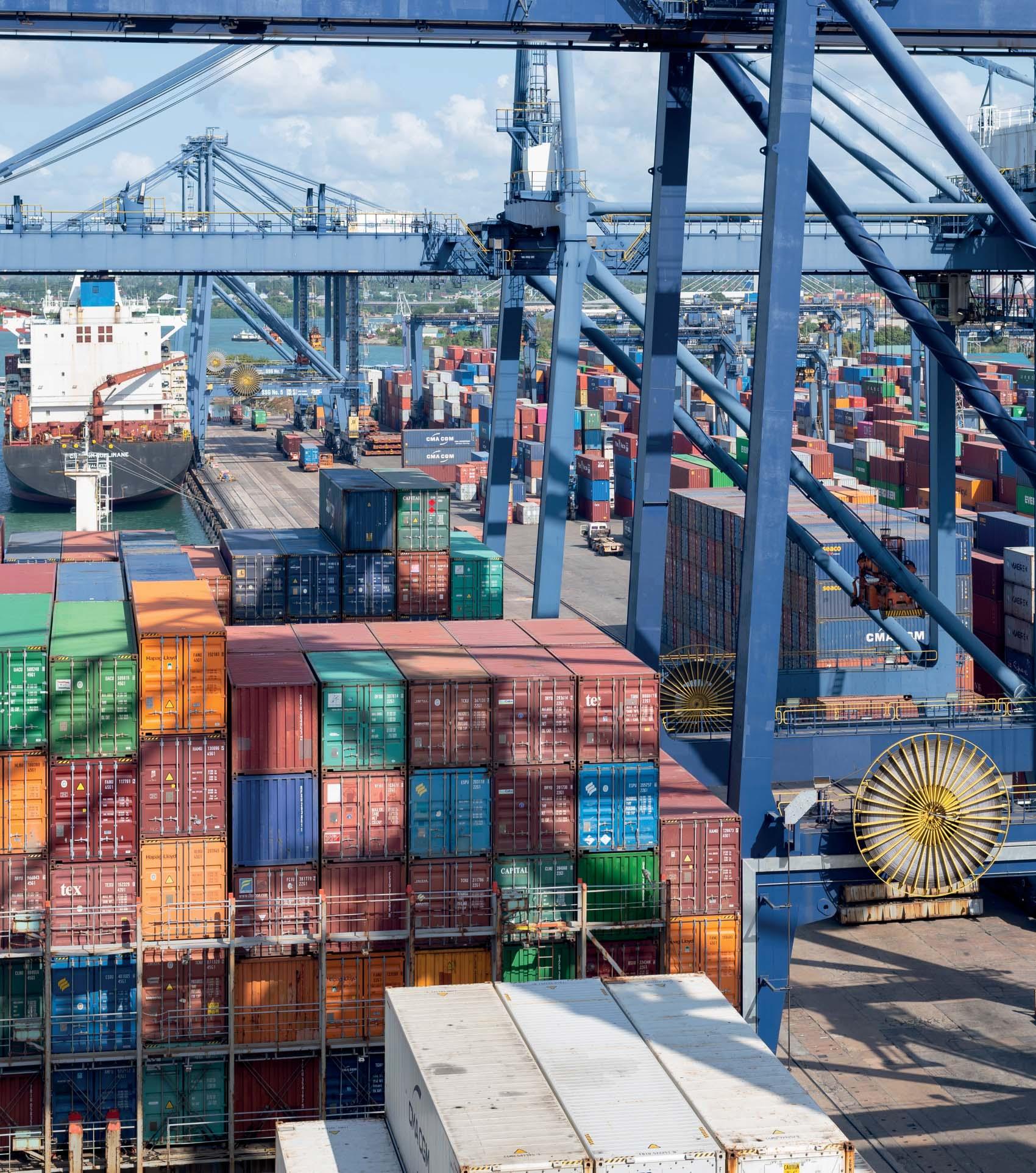
JULY/AUGUST 2023 VOL 1023 ISSUE 6 portstrategy.com
From initial concept through to design, construction, operation, and eventually decommissioning, we provide a one-stop solution supporting customers at every stage of the lifecycle for marine, ports and coastal projects.



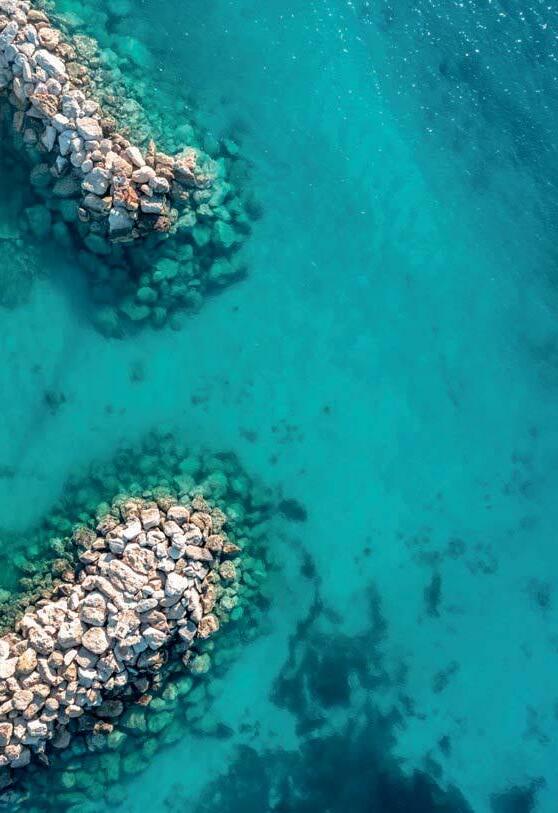


www.bmt.org
MIKE MUNDY
Integrity Has Its Place
The Black Sea Grain Initiative has folded and the Kremlin has launched a series of missile attacks on the port city of Odessa in Ukraine. The reason? Allegedly because the West has impeded Russia’s own grain and fertilizer export operations. Those of us that are properly informed, however, know that there will be little truth in this – its just more bull….from the deranged centre of power in Moscow! A lashing out as Ukraine dared to create an explosion on the bridge to Crimea where Russia is in illegal occupancy.
I have visited Odessa a couple of times and it is without doubt a jewel in the crown of Ukraine’s cities and has the same status in global terms as a port city. It is a city with stunning architecture that has been subject to diverse influences over the years – for example, French and Italian much more so than Russian. UNESCO underlines, for example:
“The historic centre of Odessa represents an important interchange of human values within Eastern Europe through its heterogeneous architectural styles, developed during its rapid growth in the 19th century, that reflect the coexistence of many cultures and the combination of influences characteristic of the border area of Europe and Asia.”
So, to hear in the last few days of Russian missiles hitting a cathedral and other non-military buildings is really just deplorable, as (of course) is the loss of civilian lives.
History will be the judge of this, and I doubt very much if President Putin and Russia will come out of this well. Putin’s propaganda machine may have the Russian people fooled for now but history will definitely be a more objective judge.
The application of sanctions against Russia and the withdrawal of business from engagement in Russian deals and commerce generally is also a way for business to make a statement against the wrongs being implemented by Russia. The sale by APM Terminals of its stake in Global Ports was the right thing to do as was the termination of calls in Russia by its sister company Maersk as well as similar actions by other liner operators.
But there is still a way to go with this withdrawal. According to data from the Kyiv School of Economics less than 300 of over 3350 large foreign companies that owned assets in Russia have already left and about 500 are in the process of withdrawing.
There are also others that need to ‘get on the programme’ – the operators of the dark ships and others who may even be considering stronger engagement with Moscow, for example DP World whose name has recently been added to a list of international sponsors of war by Ukraine’s National Agency on Corruption Prevention. The agency contends DP World is strengthening its cooperation with Russia and specifically that it has recently signed an agreement with the Russian state corporation Rosatom on the development of the Northern Sea Route.
Generally, it is perhaps appropriate to reflect on the words of Dwight D. Eisenhower who said: “The supreme quality for leadership is unquestionably integrity.”
The international magazine for senior port & terminal executives
EDITORIAL & CONTENT
Editorial Director: Mike Mundy mmundy@portstrategy.com
Features Editor: A J Keyes keyesj186@gmail.com
Consultant Editor: AndrewPenfold andypenfold@yahoo.com


Regular Correspondents: Felicity Landon; Stevie Knight; Ben Hackett; Peter de Langen; Charles Haine; AJ Keyes; Andrew Penfold; Oleksandr Gavrylyuk Johan-Paul Verschuure; Phoebe Davison
Production David Blake, Paul Dunnington production@mercatormedia.com
SALES & MARKETING t +44 1329 825335 f +44 1329 550192
Media Sales Manager: Arrate Landera alandera@mercatormedia.com
Marketing marketing@mercatormedia.com
Chief Executive: Andrew Webster awebster@mercatormedia.com
PS magazine is published monthly by Mercator Media Limited, Spinnaker House, Waterside Gardens, Fareham, Hants PO16 8SD UK t +44 1329 825335 f +44 1329 550192 info@mercatormedia.com www.mercatormedia.com
Subscriptions
Subscriptions@mercatormedia.com
Register and subscribe at www.portstrategy.com
1 year’s print subscription £295.00
1 year’s digital subscription with online access £228.50
For Memberships and Corporate/ multi-user subscriptions: corporatesubs@mercatormedia.com
©Mercator Media Limited 2023. ISSN 1740-2638 (print) ISSN 2633-4232 (online). Port Strategy is a trade mark of Mercator Media Ltd. All rights reserved. No part of this magazine can be reproduced without the written consent of Mercator Media Ltd. Registered in England Company Number 2427909. Registered office: c/o Spinnaker House, Waterside Gardens, Fareham, Hampshire, PO16 8SD, UK.
For the latest news and analysis go to www.portstrategy.com JULY/AUGUST 2023 | 3
The war in Ukraine –and it is a war not a so-called ‘Special Operation’ – has a long shadow which extends well into the maritime sector. Who knows when this unnecessary, heinous conflict will end but when it does, if not before, there will, in all probability, be a reckoning with regard to how companies and indeed countries have behaved during it. Integrity has its place!
PORTSTRATEGY INSIGHT FOR PORT EXECUTIVES
VIEWPOINT
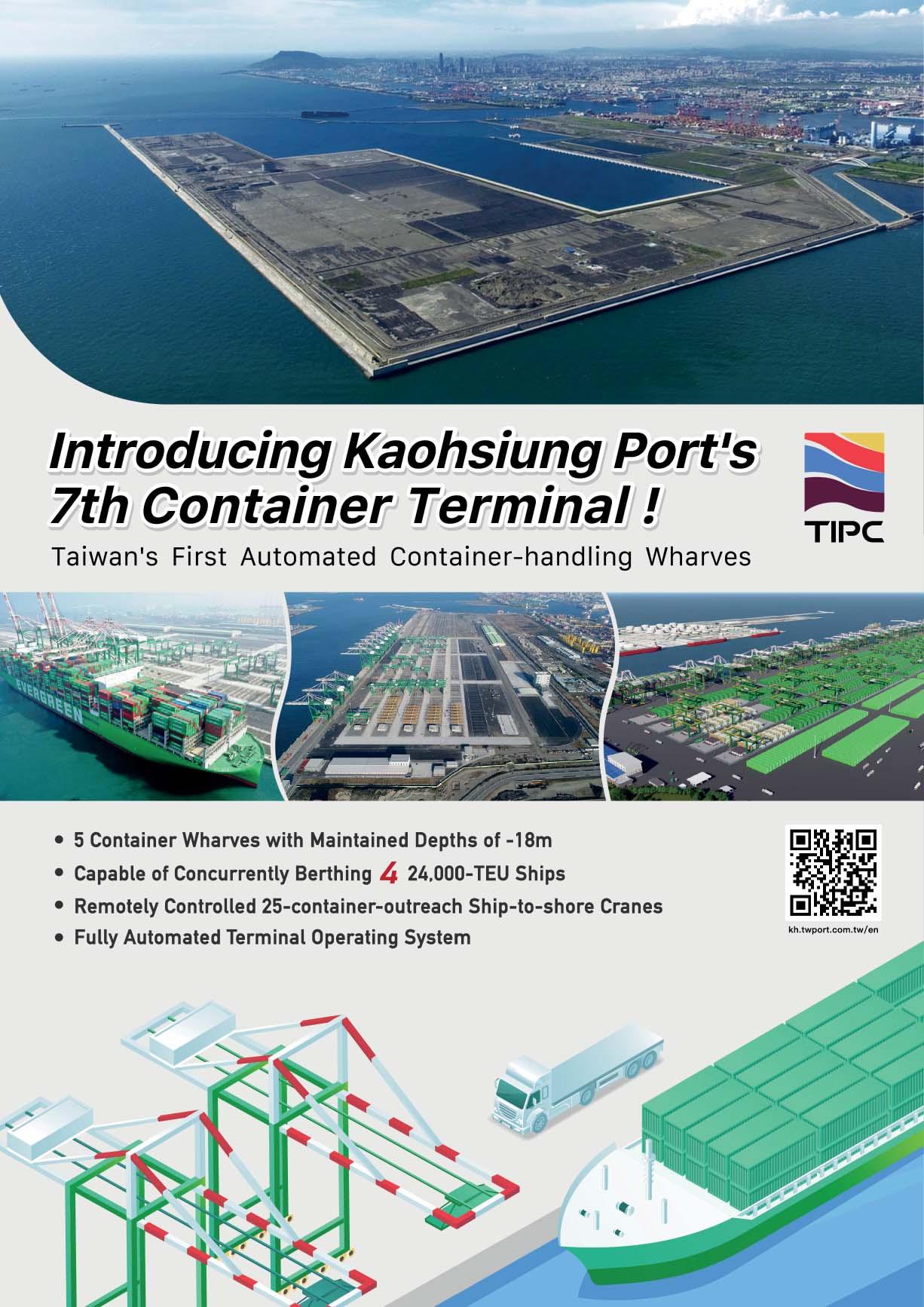
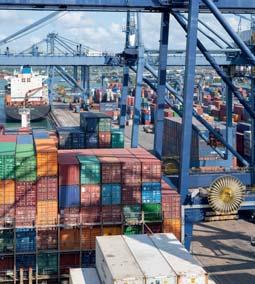
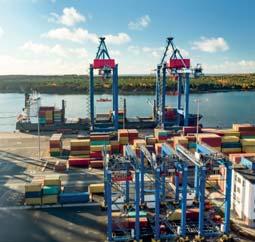
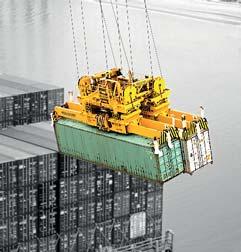


For the latest news and analysis go to www.portstrategy.com JULY/AUGUST 2023 | 5 Weekly E-News Sign up for FREEat: www.portstrategy.com/enews CONTENTS JULY/AUGUST 2023 is a proud support of Greenport and GreenPort Congress GreenPort magazine is a business information resource on how best to meet the environmental and CSR demands in marine ports and terminals. Sign up at greenport.com The Congress is a meeting point that provides senior executives with the solutions they require to meet regulatory and operational environmental challenges. Stay in touch at greenport.com Online portstrategy.com 5 Latest news 5 Comment & analysis 5 Industry database 5 Events Social Media links LinkedIn PortStrategy portstrategy YouTube On the cover The award of the container terminal concession in Dar es Salaam effects not just Tanzanian importers and exporters but those in the landlocked countries around Tanzania that depend on the Dar gateway. The fundamental goal behind the award is improved efficiency and as such the Tanzania Port Authority’s seeming intention to depart from best practice in making the award is hard to understand - (p23). NEWS FEATURE ARTICLES REGULARS 19 The New Yorker Linking Up the Data Silos 19 The Analyst Sustainability and Digitalisation to the Fore 21 The Economist No Cause for Optimism 21 The Strategist Clean Energy Maritime Hubs 23 Swimming Against the Tide Taking the Wrong Road in Dar es Salaam? 24 Tapping Transshipment Dry Bulk Transshipment to Reduce Costs 26 Santos Rethink? Concession Policy Rejig 29 New Lease of Life DP World Santos, Improved Prospects 30 In Pole Position Poland Leads in the Baltic 32 Cranking Up Capacity Baltic Port Plans 34 Bidding for the Big Time Klaipeda Seeks Scale 35 Big Ambitions but Challenges Russia turns to Northeast passage 36 Maximising Value Asset Valuation for Small Ports 38 Data Drives Development Automated Reefer Monitoring 40 Electric and Green Goals Telescopic Spreader Trends 46 Postscript China Revs up Auto Activities JULY/AUGUST 2023 VOL 1023 ISSUE 6 portstrategy.com Baltic Containerport Review Reefer Monitoring: Data Driven Spreaders: Electric & Green Goals TAPPING DRY BULK TRANSSHIPMENT DAR SWIMS AGAINST THE TIDE SANTOS: RETHINK UNDERWAY? ASSET VALUATION: SMALL PORTS 17 ICTSI Selected… …for Durban Pier 2 17 CPKC Alternative Serving the US via Mexico 18 Valencia Deal CMA CGM Buys In 19 Mega Trends Focus Hamburg Plan 10 MSC Link to Wilson, Sons Acquisition Interest? 11 Predicting Truck Flows Valencia Taps AI 11 Costa Scans Two new scanners 13 Double Oering from CM Labs New STS Pack and MasterCab 14 Double-Stack in Brisbane Truck trials with Qube 15 Autonomous Trucksy Roerdam Plans 17 Busy Times Kalmar & Liebherr


ICTSI SELECTED FOR FLAGSHIP DURBAN CONTAINER TERMINAL

After an extensive selection process, Transnet, the government agency responsible for the development, management and operation of South Africa’s key terminals, has selected Manila headquartered International Container Terminal Services Inc (ICTSI) as the equity partner for its flagship Durban Container Terminal (DCT) Pier 2.
DCT Pier 2 is Transnet’s biggest container terminal, handling 72 per cent of the Port of Durban’s throughput and 46 per cent of South Africa’s container traffic. The 25-year joint venture will have a major focus on the development and upgrade of the terminal with the objective of delivering superior standards of operation to waterside and landside-based customers.
The general intention is to reposition the terminal for best practice performance, in turn delivering growth in throughput volume. ICTSI will support the terminal in an operational context as well as commercially in conjunction with liner operators.
Transnet points out the combined planned initiatives will play a significant part in stimulating exports and imports with this notably facilitated by lifting DCT Pier 2’s annual throughput capacity from two million to 2.8 million TEU/yr.
“The partnership in Pier 2 is a major step forward for our programme to bring in global expertise to improve efficiencies
Barcelona Re-Tender
The Port of Barcelona is resuming its tender for the construction and operation of the 54,000m2 future cruise terminal G on Adossat wharf. The original tender was approved in November 2022, but then cancelled in March 2023. To date, two companies have shown an interest, Catalonia Cruise Terminal C, S.L. (Royal Caribbean) and a joint venture of Norwegian Cruise Line, Viking Ocean Cruises and Virgin Cruises.
CPKC Targets Safe Mexican Alternative
Shortly after confirming itself as a newly merged entity, Canadian Pacific Kansas City Railroad (CPKC), outlined a “safe alternative route that is considerably faster” from Asia to key locations in the US via Mexico.
at our terminals, and bodes well for our ongoing plans to crowd in the private sector in areas identified for growth,” underlines Portia Derby, Transnet Group Chief Executive.
There was stiff competition to secure the opportunity. Transnet confirms it received 18 responses to its initial call for Expressions of Interest, in August 2021, nine of them from global terminal operators. Ten parties were subsequently shortlisted in response to a request for qualifications and of the shortlisted respondents, six bidders submitted proposals, before ICTSI was selected.
Key elements of the transaction include:
5 A new company will be formed to manage the operations at DCT Pier 2, in which Transnet will have majority ownership of 50 per cent plus one share.
5 The term of the transaction is 25 years, with an option to extend to a maximum of 30
Long An is Live
Long An International Port in Vietnam has officially launched container handling services across seven berths. Dongtam Group commenced construction in 2015. The total berth length from Berth 1 to Berth 7 is 1670m. In the next phase of development the Port will expand to 10 berths, including one berth for liquid/ liquefied petroleum gas and one berth for large cruise ships. The facility is located in Can Giuoc District, Vietnam.
years in the event that berth deepening of the North Quay at Pier 2 is delayed.
5 Non-current assets will be transferred into the new company, together with customer and supplier contracts. The new company is required to achieve a minimum level 4 BBEE contribution status.
5 The terminal operating licence and lease will be subcontracted to the new company, after seeking approval from Transnet National Ports Authority.
5 DCT Pier 2 employees will be seconded to the new entity. There will be no retrenchments, and employees will retain the same terms and conditions before and after the introduction of the private sector partner.
Transnet is now working with ICTSI to finalise arrangements.
No Hutch Sale
International press reports are indicating that PSA International is no longer planning to sell its 20 per cent stake in Hutchison Ports due to limited interest in the deal. Singapore-based operator, PSA, acquired the stake in Hutchison Ports in 2006 for US$4.4bn and was rumoured to be seeking US$4bn from this proposed sale. Both Cosco and China Merchants had been noted as possible names looking into the opportunity.
According to Cory Heinz, MD Asia Pacific, CPKC, the company already offers highly competitive access from Vancouver (BC) to the US Midwest, with a four- day transit to Chicago and direct access to Kansas City and Minneapolis.
The option of access to US markets via Mexico and avoiding US West Coast terminals and the Panama Canal is regarded by CKPC as a potential “game-changer.”
Lázaro Cárdenas is Mexico’s second-largest port and has two container terminals with a combined capacity of 3.2 million TEU per annum, with on-dock rail access and expansion space, with terminal utilisation only in the order of 50 per cent.
CPKC adds that moving container traffic from Asia to Dallas over this Mexican Pacific gateway takes sixteen days on the water and four on the rail, equivalent to 7-10 days faster than using the Panama Canal and calling at Houston (based on rail to Kansas City and Chicago being seven and eight days, respectively).
BRIEFS
Norvik Seeking CO2
The Swedish Energy Agency is funding a feasibility study to assess the viability of establishing the infrastructure to support captured carbon dioxide (CO2) at Stockholm Norvik Port. The initiative aims to establish overall proof of concept to develop a regional, sustainable, and cost-efficient infrastructure for carbon dioxide capture, interim storage, and transportation in eastern Sweden.
For the latest news and analysis go to www.portstrategy.com JULY/AUGUST 2023 | 7 PORT & TERMINAL NEWS
8 Transnet has selected ICTSI as its equity partner for its flagship Pier 2 terminal at Durban
CMA CGM ENTERS PORT OF VALENCIA BRIEFS
Onne for Safety
Onne Multipurpose Terminal (OMT), the Nigerian cargo-handling operation of International Container Terminal Services, Inc. has recorded an impressive safety milestone after achieving two million man-hours with zero lost time injury (LTI). Moreover, OMT has been able to reach this significant position just two years after it commenced commercial operations in 2021. OMT is one of four current ICTSI terminals in Africa, although this total is expected to increase.
PSA Venice Gets 25 More Years
PSA Venice has signed an agreement with the North Adriatic Sea Port Authority (AdSP) to extend its existing concession by 25 years. This new contract commences on October 1, 2024, and will run until October 1, 2049. The operator confirms it will be implementing terminal improvements, including expanding capacity to 500,000TEU per annum.
The original 25-year concession began in 1997.
Ceres Sold
Carrix has agreed to purchase the Ceres Terminals portfolio from Macquarie Asset Management. The deal includes 18 port locations in North America, but excludes assets in Jacksonville, which remain under the ownership of Macquarie. No financial terms have been revealed, although Macquarie was reportedly seeking US$1bn. The Ceres facilities will become part of Carrix’s subsidiary, SSA Marine, which operates at over 250 port and rail locations worldwide. The transaction remains subject to the approval of relevant regulatory authorities.
CMA CGM has closed a deal to acquire 49 per cent of Cosco Shipping Ports (CSP) Valencia Iberian Terminal, located at the Muelle Príncipe Felipe in the Port of Valencia.
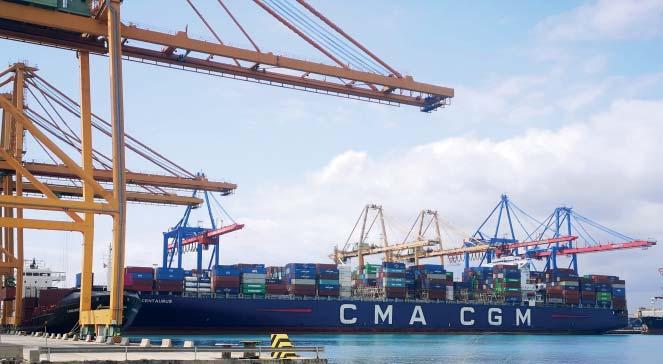
The CSP Iberian Valencia Terminal consists of 2300m of berth, 145ha of yard, an automatic gate system solely to support local cargo flows and direct connectivity to the dry ports of Madrid, Zaragoza and Bilbao, as well as an automatic gate system for the flow of local cargo.
A combination of this infrastructure and geographic location make both this terminal, and Valenciaport, a key container gateway for the Iberian peninsula, in addition to the leading port for serving Madrid. The terminal serves a market extending
APM Terminals (APMT) Valencia is investing €3.6 million (US$3.9 million) to expand capacity, increase equipment efficiency and improve the flow of trucks entering its terminal.
According to this operator, sister company to Maersk Line within the AP Moller Maersk Group, a total of 11 new Terberg YT223 terminal tractors, each equipped with Cummins Stage 5
350km, which comprises an estimated 55-60 per cent of Spanish GDP activity, according to information specialist Data&.
The commitment from the French line further consolidates the port’s key strategic role in the Western Mediterranean. In addition to CMA CGM,
8 CMA CGM has acquired a 49 per cent stake in Cosco Shipping Ports (CSP) Valencia Iberian Terminal
Mediterranean Shipping Co (MSC), Maersk Line and Cosco all have made major commitments to high capacity operations in the port of Valencia.
…AS APMT ALSO INVESTS
engines to comply with current European Union emissions regulations, have arrived at the facility.
The new tractors are one part of a more extensive investment plan by APMT Valencia, which includes the commissioning of four Rubber-Tyred Gantry (RTG) cranes, with a 50-tonne lifting capacity.
Further, the terminal has commenced the construction of new gates for trucks, which will see the number of access lanes to the terminal increased from five to six, while also being able to automatically read container and truck details through use of Optical Character Recognition and License Plate Recognition.
PLUS SAGUNTO RAIL INVESTMENT CONFIRMED
The Port of Sagunto, a satellite port to Valenica and also under the management of the Port Authority of Valencia, is to see investment of €17.5 million (US19.3 million) from the Spanish Government for construction of its inner rail network. The
8 Rotterdam World Gateway (RWG) has reached agreement with its shareholders DP World, CMACGM/ Terminal Link, HMM, MOL and the Port of Rotterdam Authority regarding a phased expansion of the RWG terminal. In the first phase, an extra berth for the deep-sea operations will be developed and alongside this capacity expansion the focus will be on future oriented facilities in which automation, sustainability and connectivity are central. The total investment is approximately €500 million and initially includes civil works, quay cranes, storage modules with automatic stacking cranes and electrical automatic guided vehicles. Commerical roll-out will be 2026.
recently released tender cites a completion period of 11 months after the award.
The project is being financed with European CEF funds and includes an Intermodal Goods Facility, with the terminal capable of accommodating trains of 750m
in length. This project is part of the Port Authority of Valencia (PAV) development strategy which earmarks more than US$260 million for the rail sector and forms part of comprehensive efforts to decarbonise port operations.
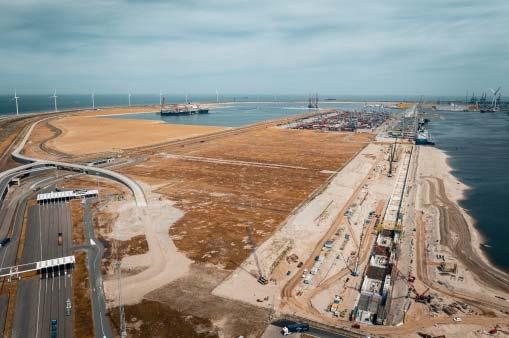
PORT & TERMINAL NEWS
8 | JULY/AUGUST 2023 For the latest news and analysis go to www.portstrategy.com
HAMBURG TARGETING “GLOBAL MEGA TRENDS”…
The Hamburg Senate has endorsed a new port development plan. As a result, the strategic guidelines for future port policy and availability of land for port development are more visible.
Dr. Melanie Leonhard, Senator of Economics and Innovation explains: “Hamburg is and will remain Germany’s largest seaport. This is of fundamental importance for the economic strength of Germany as an exporting economy and for supply chain security at national
and European level. Going forward, we shall continue to operate a large, efficient universal seaport that serves these aims. Cargo handling is not an end in itself and container numbers may be an indicator but are not the only relevant factor. Unlike other ports, Hamburg is itself a significant market and industrial base. Goods on arrival are not only transhipped, but also consumed or further processed.“
The Senate also confirms that the port will focus on “global mega-trends” including

digitalization, climate protection, and e-commerce, to extend its competitive position. Other key areas of focus include special attention given to the port railway network and the rail infrastructure with the hinterland, noting that from 2040 the Port should be climateneutral in its operations. Moreover, expansion of shore power-supply for vessels to reduce emissions of harmful pollutants, contributing directly towards keeping the atmosphere clean are also key points of note.
...AS MEGA-SHIP ARRIVES
Takoradi Sees Biggest Bulk Ship – and Record Activity
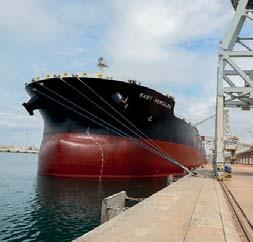

The “ONE Innovation”, the largest container ship of the shipping company ONE - Ocean Network Express - has called at the port of Hamburg. This vessel is the first 24,000TEU vessel of the ONE shipping company. It has a 400m LOA and an exact capacity of 24,136TEU.
“The shipping company’s
Indiana Interest?
Ports of Indiana has issued a Request for Qualifications (RFQ) to identify potential operators for the general cargo terminal at Ports of Indiana-Mount Vernon.
The 11-acre facility includes three warehouses (totalling 90,000ft2) and potential connectivity to five Class I railroads. A 60-ton dual lift crane capable of transloading cargoes between warehouse, barge, truck, and rail is also available. Investment of US$2.5 million has been made since 2020.
decision to call at the Port of Hamburg with its most modern ship shows that we have done our homework. For example, the terminal operators have state-of-the-art container gantry cranes to efficiently unload and load a ship of this size. In addition, shore power systems are currently being installed at the
Rotterdam Rail
Modal 3 Logistik has commenced a new rail shuttle running twice a week back and forth between Rotterdam and Magdeburg in central Germany. This service represents the first time this German logistics service provider has offered a direct train shuttle to Rotterdam. Each Sunday and Wednesday the container shuttle departs from Rotterdam and arrives in Magdeburg on Mondays and Thursdays, respectively. Modal 3 also provides first and last mile trucking..
container terminals in the Port of Hamburg to make the ships’ laytime more environmentally friendly,” says Axel Mattern, CEO of Port of Hamburg Marketing. The ship is deployed on the Asia-Europe service, FE3, by THE Alliance (THEA). It is the first of six new Megamax vessels to join ONE’s core fleet.
VICT on Schedule
International Container Terminal Services (ICTSI) has confirmed that its Victoria International Container Terminal (VICT) at the Port of Melbourne, Australia is on schedule to simultaneously accommodate two ships up to 14,000TEU by 2024. The A$235 million ($159 million) expansion includes adding three new quay cranes (to eight units), 10 new automatic stacking cranes (ASC) and raising yard capacity by 50 per cent.
Takoradi Port has received the biggest bulk ship ever to call the port since its construction in 1928.
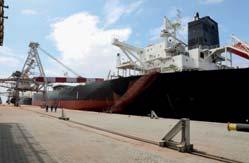
The bauxite vessel, mv Baby Hercules, is a Capesize bulker with a 240m LOA and a draught of 16 meters, the first ever with these dimensions. Bedeschi S.p.a. supplied all the conveyor lines of the terminal, the two shiploaders and one eco-hopper, which enabled the vessel to load a record of 106,530 metric tons of Bauxite in just five days, which compares favourably to needing between 12 and 15 days to load the same volumes without the equipment from Bedeschi S.p.a.
BRIEFS
BNCT to Double
Belawan New Container Terminal (BNCT) is doubling its throughput capacity to 1.4 million TEU per annum. Operator of the facility, DP World, confi rms it has signed an agreement with the Indonesia Investment Authority (INA) and government-owned port operator Pelindo. The global operator also announced that it plans to support links to other terminals and minor ports on the island of Sumatra, faciliating lower cost box transport.
For the latest news and analysis go to www.portstrategy.com JULY/AUGUST 2023 | 9 PORT & TERMINAL NEWS
MSC AND WILSON, SONS LINK BRIEFS
Truck Rule Change
The Peruvian Association of Port Operators (ASPPOR) is calling for new regulations that would allow for two 20ft containers to be transported by truck instead of the current maximum of one, as this would save 100,000 heavy vehicle trips per year between Lima and the port of Callao. Favio León Lecca, President of ASPPOR, is pressing for rules to be changed to reduce pollution and traffic congestion: “It is important that transport companies, regulators and port terminals work together to find solutions that allow greater efficiency in the flow of cargo, and, for sure, allowing two x 20 footers is one of them,” underlines Lecca.

News…94 so far… Uruguay
The Administracion Nacional de Puertos de Uruguay (ANP, or National Uruguayan Ports Authority) has opened up a tender process to improve the infrastructure at the port of Nueva Palmira, in the Colonia province, at the strategic confluence of the Rivers Uruguay and Parana, some 220 km west of Montevideo. Four companies have already shown an interest, states ANP, without disclosing the names of the companies involved. Nueva Palmira is Uruguay’s largest port for dry bulk shipments, and most of the improvements will be made to the Ultramar Sur and Union piers.
FIG floating dock
The Falkland Islands Government (FIG) has launched a tender to build a new floating dock system to replace the moribund FIPASS dock. Potential developers have two months to present their plans.
MSC is reportedly keen to buy a majority shareholding in Wilson, Sons, the Brazilian based diversified shipping, terminal operating and logistics company.
An article published in the Globo newspaper stirred up the “Chat and Gossip channels” in Brazilian port and maritime circles as Wilson, Sons declared that it was carrying out one of its occasional “strategic reviews” but that “nothing was on the table”.
Wilson, Sons, owns and operates two port terminals (Tecon Salvador in the northeast of Brazil, and Tecon Rio Grande, TRG, in the far south) and also owns a shipyard (in Guaruja, across the channel from Santos), and two fleets (88 tugboats and 22 Offshore Support Vessels), as well as an inland terminal (at Santo Andre, near Sao Paulo), two offshore support bases and various other offices and ship agencies.
Taking over Tecon Salvador and TRG – two deepwater terminals – could greatly assist MSC’s transshipment options along East Coast of South America, several analysts advised PS.
According to Bloomberg the share price of parent company Ocean Wilsons Holdings Limited shot up by 14.07 per cent in the wake of the news that MSC was looking to buy the company. However, although contact between the two parties has been made, reliable sources do
not believe any formal offers have been put forward by the Swiss headquartered company, which has a 50 per cent share in the BTP Terminal Operating Company in Santos. The share price of Santos Brasil, still Brazil’s biggest TOC, also rose (also by 14 per cent) on the Wilson’s news with the Bovespa (Sao Paulo stock exchange) reflecting the fact that MSC, and its partner Maersk, had also shown an interest in buying them, not so long ago. The current valuation of Wilson, Sons on the Bovespa is around Reais8.8BN (US$1.8BN)
Arnaldo Calbucci, the CEO for Wilson, Sons in Brazil, told PS that
the “main shareholders of the company are studying strategic possibilities as they regularly do and have done in the past” and that there is “nothing on the table” right now.
A statement from Wilson, Sons to both the London Stock Exchange and Bovespa, reflects the same sentiment as Calbucci, stating that “no formal proposals had been made from third parties”.
“Whenever news of these discussions is leaked or released the share price shoots up, so I am not sure how credible the MSC bid is, but it possibly has more substance than the Maersk one of two years ago and there would be more synergies in an MSC buy than a Maersk one,” said one market analyst based in Sao Paulo.
DP WORLD CALLAO BUILDS GREEN CREDENTIALS
DP World Callao, in Peru, has received the first LNG powered vessel to berth along the West Coast of South America and is promising the container terminal will be carbon neutral by the year 2030.
The Liberty, owned and operated by CMA CGM is, at 366 meters and with 14,800TEU capacity, one of the largest ships currently operated in WCSA trade.
“DP World is reducing its carbon footprint throughout the world and we hope to achieve carbonneutrality in the South Pier in Callao by 2030,” states the terminal operator.
In 2021, DP World began a
US$350M expansion plan – taking capacity from 1.5m TEU up to 2.7m TEU – with all new equipment bought for the upgrade helping it carry out a gradual change of the energy matrix from fossil fuels to electricity, especially from
renewable sources. Eventually the company will halt emissions of 4320 tons of CO2 gases per year from its Callao facility.

LATIN AMERICA NEWS
10 | JULY/AUGUST 2023For the latest news and analysis go to www.portstrategy.com
8 Wilson, Sons Tecon Salvador facility – reportedly part of the company’s assets attracting interest from MSC
8 DP World reducing its carbon footprint in Callao with this goal at the heart of expansion plans
Valenciaport and Nextport have developed a pilot programme using Artificial Intelligence (AI) that aims to predict: the number of trucks that will pass through the port; which terminal will be accessed and whether the truck will be loaded or unloaded.
The new Artificial Intelligence system combines Valenciaport’s data, both landside and marinerelated, with other relevant information to understand the behaviour of a ship on arrival at the port and its impact on landside traffic flow.
The size of the ships, the type of services and routes, the terminal timetables, the weather, the calendars of festivities in third countries (the Chinese New Year, for example, has a strong influence on port traffic) or even a history of world GDP are considered to adjust this predictive machine learning model; assisted and supervised by specialists in the system.
Using this specialist software, Valenciaport states it can know days in advance what is going to happen in the Valencian docks, both in terms of loading and unloading of ships, as well as the movements that will take place at the terminal gates and the number of truck entries.
This means that when Valenciaport enters in the new system that a ship is going to arrive on a specific day, it will be able to forecast from this point in time the workload for both import and export activities.
Valenciaport points out that this predictive, AI-assisted model represents a competitive advantage for terminals and carriers operating within its
Next-Gen Westwell
Westwell has released its “Next-Gen Digital & Intelligent Port Operating Platform” and launched the new Large Language Model (LLM) product TerminalGPT for port operations. Using the LLM technology and combined with experience of large logistics scenarios, the new product can become an expert in smart port operations through continuous pre-trainings by transforming from a manual operation to an intelligent mode.
VALENCIA PORT USING AI TO PREDICT TRUCK FLOWS
8 Valenciaport is using AI technology to offer predictive solutions to landside port traffic flow
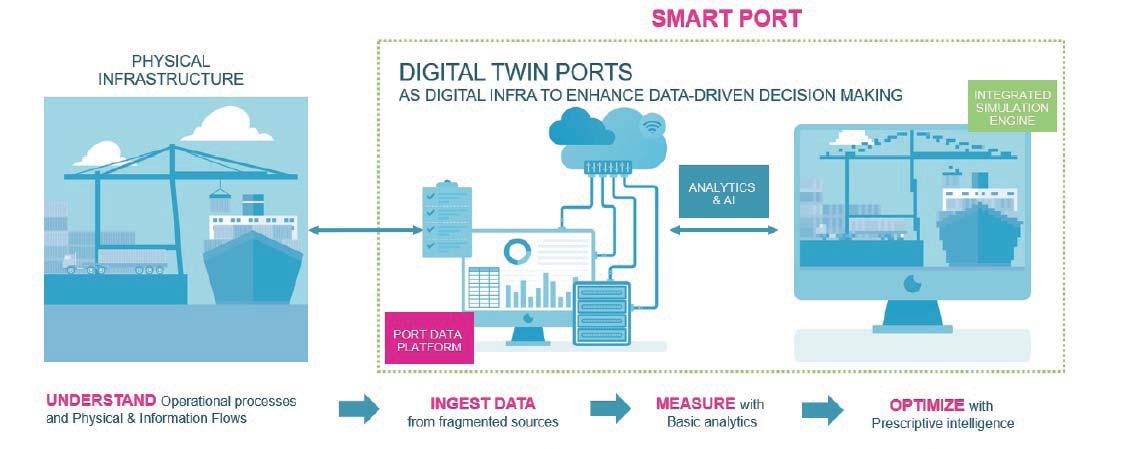
facilities as improvements in planning and managing needs and working times can be undertaken far more efficiently.
Jose García de la Guía, Senior Product Manager at Nextport (a division of US-headquartered Moffatt & Nichol) underlines:
“With this tool, which combines
Big Data technology, Digital Twin, Simulation and Artificial Intelligence, a more dynamic, real-time and prescriptive decision-making process is promoted.”
Moving forward, Valenciaport is confident that this AI software can assist beyond the port’s boundaries.
It states that the information forecast can be utilised to
improve traffic management on the roads near the port’s access points as well as internally in the port area.
As a result, by knowing the volume of trucking that is expected to be using the port’s road connections, on an hourly basis, it will be possible to warn truck and other drivers about the latest position who, if necessary, can seek alternate routes.
REPUTATION MATTERS IN COSTA RICA
The Government of Costa Rica in partnership with APM Terminals (APMT) Moin has confirmed the inauguration of two new container scanners.
The two new units have been added to one existing scanner that has been in service at the facility since 2020. The government states it is implementing this new
ImpalaID App is Go
Hamburg-based software provider, DAKOSY, has created ImpalaID, a new universal identification tool for logistics at the Port of Hamburg. It is a central Identity Provider System (IDP-System) for logistics and generates secure legitimisation through a secure QR code for users. Nicolai Port, Head of the Intermodal Transport Solutions Department, DAKOSY, notes: “Our new app fills a significant gap for authentication at barriers or gate systems in the port.”
investment in order to provide better surveillance and security to combat the typical day-to-day challenges that any port or terminal faces regarding the detection of unlawful goods and container contamination.
Ensuring that the port is more efficient, modern and safe are all key objectives of this investment. Leo Huisman,
SMITCO is Live
Tideworks Technology has confirmed that its Mainsail 10 terminal operating system (TOS) is live at Santa Marta International Terminal Company (SMITCO). SMITCO successfully upgraded from Tideworks’ legacy Mainsail solution to the advanced Mainsail 10, offering the terminal operator more flexibility through a highly configurable user experience and intelligent third-party integration capabilities
Regional Director, APM Terminals Americas, emphasises: “The inauguration of these scanners will allow our customers and international markets to see Costa Rica as a safer country and improve the country’s reputation.”
Integrated Platform
SEDNA will integrate its email management platform with OrbitMI’s maritime software products. This represents an extension of a partnership established in 2021. The primary purpose of this new unified product is to help centralise vessel data by providing a seamless flow of maritime data across the two platforms, digitally. It is already in use in the tanker industry with Stena Bulk and will now be rolled out at a wider level.
For the latest news and analysis go to www.portstrategy.com JULY/AUGUST 2023 | 11 DIGITAL NEWS
BRIEFS

CM Labs Simulations, has launched two new products for the port industry.
The first is an enhanced Ship-To-Shore (STS) Crane Simulator Training Pack. Taking on board feedback from a range of customers and industry experts, the Montreal, Canada-based company is offering a range of new features in this package including an enhanced graphics engine and the following:
5 Multiple STS Size application – expanded offering of cranes from Post-Panamax to MegaMax
5 Support for various delivery methods - training to move cargo to transfer vehicles or straddle carriers on the dock
5 Dual Cycle Support (load/ unload) - move cargo off and on the ship in the same exercise
5 Ship orientation (port/starboard) - choose and train for loading and unloading from port or starboard sides of the ship
5 Exercise builder capabilities - instructors can make their own load plans – choose vessel, orientation, and cycle type Devon Van de Kletersteeg, Product Manager, Ports, CM Labs explains why the update delivers a more absorbing experience for the user:
“Every port operates slightly differently. With this update to the STS, we wanted to make sure that the training addresses the operations needs of various port environments. With the enhancements, trainees will have a much deeper immersive experience and instructors will be able to more closely replicate the existing port environment. Combining the new features with
ABP Digital Drive
Major UK ports group, Associated British Ports (ABP), has launched a new company-wide initiative to digitalise asset management across its network of 21 ports. The GBP£1.5 million (US$1.8 million) investment follows a successful pilot trial of the new technology. Working in conjunction with Mainsaver and Spidex, in-depth tests confirmed the practicalities of implementing and allocating work in a digital manner.
CM LABS UPGRADES STS TRAINING PACK AND INTRODUCES MASTERCAB
system expandable to six Degrees of Freedom (DOF). This means that the MasterCab can reproduce the sensory cues experienced by operators on the real equipment, ensuring a more fluid transition from training to real operations.
Van de Kletersteeg notes:: “We are delivering on the promise to release a fully immersive simulation training experience with the MasterCab. With the MasterCab, port and terminal managers and operators can experience more effective training and skills development, and ultimately realize a faster return on their investment.”
the power of the physics-based CM Labs’ Smart Training Technology, the STS is the most accurate and realistic offering on the market today.”
The second product released is CM Labs’ MasterCab, a fullimmersion training simulator. This product is powered by what CM Labs describes as the most “realistic port equipment simulation” offering available.
MasterCab is a comprehensive training solution that develops operational skills, muscle memory, and spatial intelligence. As a result,
ZIM’s Spinframe Lead
ZIM, has confirmed the closing of an US$8 million financing round in Spinframe. Spinframe develops vehicle-inspection systems based on artificial intelligence (AI), computer vision, and machine-learning technologies, that create “Digital Twins” for vehicles throughout the supply chain, while detecting anomalies during the process. This project is a key part of ZIM’s strategy is to invest in earlystage digital supply chain companies.
it allows terminals to safely and effectively assess and train new operators, while at the same time preparing personnel for new equipment and processes.
MasterCab features 10 high-definition displays, providing full field-of-view perspective, driven by what CM Labs describes as industryleading simulation of operating conditions, machine response and the port environment.
Further aspects of the product offering that enable the trainee operator to gain a more realistic understanding include professional-grade seating, controls and pedals as well as high-fidelity audio and a motion

Russian Cyberattack
The port of Rotterdam website has been targeted in a cyberattack that is being blamed on pro-Russian supporters, according to Dutch news sources. A hacker group called “NoName057(16)” said the attacks were a response to plans by the government of the Netherlands to buy Swiss tanks for Ukraine. Amsterdam and Groningen faced distributeddenial-of-service attacks (DDoS), according to the Dutch National Cyber Security Centre.
The MasterCab provides training that is available 24/7, and runs a complete catalogue of quay-side and yard-side equipment training packs and custom simulations, thereby giving instructors real-time training data so that all sessions can be monitored and assessed
CM Labs clients include the Port of Tilbury, Flinders Adelaide Container Terminal, Indonesian Port Corporation, Napier Port, Ports of Auckland, multiple DP World sites, the Pacific Maritime Association (USA) and over 100 other companies and equipment operators.
BRIEFS
CLEVR Kongsberg
Kongsberg Maritime and CLEVR have confi rmed a new partnership. This collaboration has the primary aim of accelerating Kongsberg Maritime’s internal digital transformation journey. CLEVR, a provider of low code and software solutions, will support development of an internal tool for digital workfl ow processes to unlock new levels of operational efficiency, streamline processes, and enhance collaboration across the value chain.
For the latest news and analysis go to www.portstrategy.com JULY/AUGUST 2023 | 13 DIGITAL NEWS
8 CM Labs has released two new products, including MasterCab, which the company describes as a full-immersion training simulator
Vietnam Venture
Trelleborg Marine and Infrastructure, is to open a new state-of-theart manufacturing facility in Vietnam. With production to commence in 2026. This new facility will complement the company’s existing operations at its Qingdao based site, which serves the Chinese market. The new Vietnam factory is located in the Phu My 3 Specialised Industrial Park (SIP) of Ba Ria Vung Tau province, one of eight provinces in the southern key economic zones of Vietnam.
Zero Emissions Tug
A new consortium of UK shipbuilder Harland & Wolff, Macduff Ship Designers, Kongsberg Maritime and Echandia, are aiming to develop and build a zero emissions harbour and coastal tug. The unit will be 25.5m in length and have a bollard pull of 50 tonnes, with electric propulsion gained from stored battery power for day-to-day operations. The tug’s engine is also backed up by generators driven by biofuel when shore charging support is unavailable.
Felixstowe Order
The UK Port of Felixstowe has placed a new order for 100 batterypowered autonomous trucks, in a deal with Shanghai Westwell Technology. Felixstowe owner, Hutchison Ports, introduced the same Q-Trucks model at its Terminal D facility in Laem Chabang, Thailand in 2020. The port has also taken delivery of six new semi-automated remote-controlled electric rubber-tired gantry cranes (RCeRTGs) from Konecranes of Finland, the first part of an order for 17 new cranes.
NEW DOUBLE-STACK VEHICLE TRIALS IN BRISBANE…
Working under stringent operating and safety conditions, the new Super B Double Stacked vehicle, which was designed by specialist The Drake Group, carried eight empty containers on a pre-defined route that covered both Qube’s port area and some public port roads. The ability to double-stack containers is fully compliant with load restraint requirements in Australia
Qube said that this activity was the first time any double stacked container vehicle had been tested on any public roads in Australia. The Drake Group simultaneously launched the 32m Super B-double trailer at the Brisbane Truck Show in June 2023.
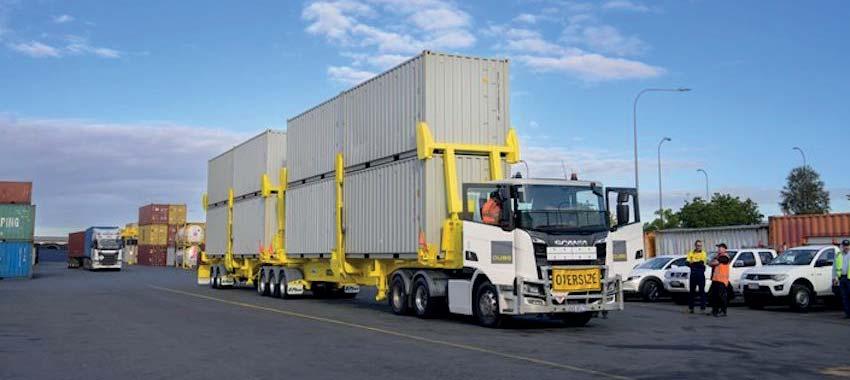
Neil Stephens, CEO, PBPL (Port of Brisbane) offered congratulations on the trial being completed successfully, while highlighting the importance of the process: “This is a fantastic outcome for Qube and all parties involved…. as Port Manager one of our key priorities is investing in infrastructure to support supply chain efficiency.”
Stephens stressed that this test represented a clear demonstration of the potential for enhancements in operational efficiency in Brisbane, based on collaboration and innovation being achieved by Qube Logistics customers and partners, which include PBPL. “We were pleased to deliver road improvement works and upgrade the access/ egress to a number of facilities to support this new vehicle and Qube’s innovation,” he added.
Sam Drake, Director, The Drake Group, endorsed these comments: “We’ve worked with the customer, the Port of Brisbane, the National Heavy Vehicle Regulator (NHVR) and other relevant authorities to come up with an approved Double Stack Container Super B-double Skel trailer combination that can be operated on the port precinct,” he said. “The purpose is to shift as many empty containers as possible in the most efficient way on the port precinct. So, we’re hoping that it’s something people see as a viable solution and get excited.”
…AS AARHUS TRIALS AUTOMATED ‘BLUE BOT’ STRADS
APM Terminals (APMT) Aarhus has received two further automated straddle carriers from Shanghai Zhenhua Heavy Industries Co. Ltd. (ZPMC).
These latest two carriers will complement a first prototype that has been tested at a real-world operating terminal since the start of 2022.
The automated straddle carriers are known as “Blue Bots” and ZPMC confirms that they have been specifically built for APM Terminals Aarhus. APMT states that the straddles are
equipped with hybrid diesel generators and lithium battery to meet the demand for intelligent environmental protection.
A range of tests has been conducted with the first straddle carrier, including navigating in the reefer area and picking and placing containers to and from a test quay crane lane.
APMT notes that the first “Blue Bot” has successfully completed more than 6000 lifts and navigated 800km in a testing area.
Mikael Gutman, Nordic Managing Director, APMT,
elaborates: “We are proud to be part of the development of these highly-advanced GPS operated automated straddle carriers. We have been testing the first straddle carrier in a small, enclosed area which has provided valuable learnings and insights for the development of the next models. With the new Blue Bots, we are now ready to expand our test area to 65,000 square metres in order to further analyse and optimise the technology to fit our operations and enhance safety.”
EQUIPMENT NEWS
A new double stacked container vehicle has been tested at the Port of Brisbane, Australia, by logistics specialist, Qube Logistics.
BRIEFS
14 | JULY/AUGUST 2023 For the latest news and analysis go to www.portstrategy.com
8 Qube Logistics, in conjunction with vehicle designer, The Drake Group, has successfully trialled its new Super B Double Stacked vehicle at the Port of Brisbane, the first time such a vehicle has been tested in Australia
8 The Port of Seattle has acquired a third shore power system for its Pier 66, claiming this makes it the world’s first port with three systems for cruise ships. The Port of Seattle will use Watts Marine’s innovative, cost-effective Mobile Cable Positioning Device (CPD), which facilitates shore power connections by moving the cabling strategically to the ideal location. The mobile design simplifies moving the system to accommodate docked vessels of all sizes and configurations, making shore power available almost immediately. The new shore power connection is expected to be fully operational by the 2024 Alaska cruise season. The port serves a large and fast-growing cruise market, with more than 200 vessels in a typical season between April and October.
HYSTER® TO USE ROCSYS
Autonomous Yard Trucks in Rotterdam
Autonomous yard trucks are to be used across multiple locations in the Port of Rotterdam, as a result of a new partnership.
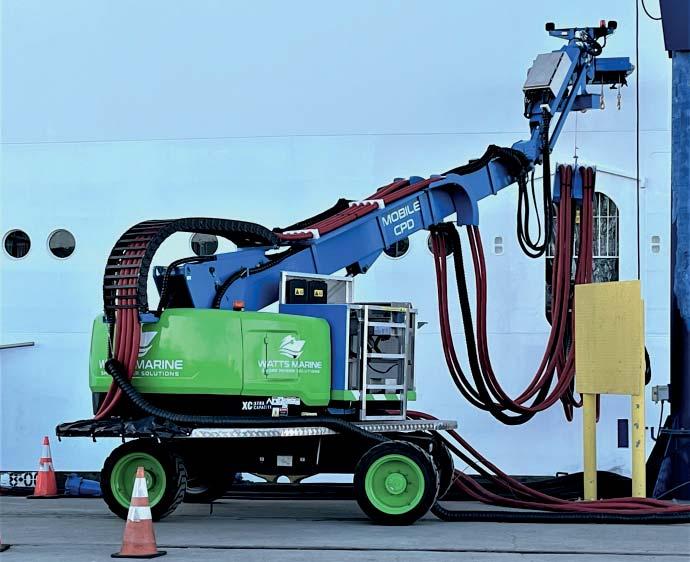
Kramer Group, a major Rotterdam depot and container terminal operator and StreetDrone, a leading provider of autonomous yard truck technology, and Terberg, Europe’s largest manufacturer of yard trucks, have joined forces on the project.
Over the course of the next two years, the programme will see the introduction of six autonomous yard trucks. First delivery will be by the end of 2023 to the Kramer City Terminal, followed by supporting the Maasvlakte Container Exchange Route in 2024.
Zero-emission Hyster Terminal
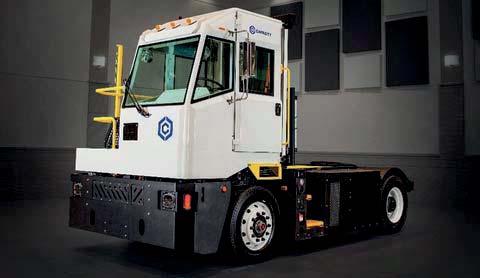
Tractors are planning to use the ROC-1 autonomous charging system developed by Rocsys. This new deal means that by using the robotic ROC-1 solution, parked machines can be both plugged in and charged automatically, while taking advantage of the system’s ability
Virtual MIT
Manzanillo International Terminal (MIT), Panama is introducing a new virtual training tool for its terminal yard tractor drivers from Tideworks. The DriverSIM solution incorporates virtual reality technology in order to provide terminal operatives with simulated activities as part of the equipment training process. Tideworks highlights that moving training to a virtual environment can reduce training costs by 50 per cent.
to work with any type of charger, notably a standard CCS (Common Charging System) inlet.
Crijn Bouman, CEO and Co-founder of Rocsys, explains: “Rocsys is thrilled to introduce the first autonomous charger for Hyster. By harnessing cuttingedge soft robotics, AI technology, and continuous data-driven
ABB & HHLA Project
ABB Ltd and Hamburger terminal operator Hafen und Logistik AG (HHLA) have announced a new partnership with the aim of increasing efficiency in the longterm operation of big, automated stacking crane (ASC) systems. The two companies report that the deal, due to run until the end of 2025, is seeking to unlock potential for further development of systems for ASCs as well as their use, maintenance, and servicing, through exploiting their combined knowledge.
monitoring, we offer a reliable and secure charging solution. The high power requirements of electric vehicles can result in heavy and inflexible charging cables, which may be challenging to handle. Our innovative system eliminates this issue, helping to support safety and efficiency without compromising performance.”
As well as being an option for selected Hyster equipment, the ROC-1 autonomous charging system will also be implemented at the Hyster test centre in Weeze, Germany. Rocsys will use the Hyster site to carry out autonomous charging demos.
Shore Investment
The Ministry of Infrastructure in the Netherlands is allocating €140 million (US$150 million) to boost shore power plants at ports, with a further €40 million (US$43 million) being added from its climate fund. By 2030, European ports will be required to supply ships over 5000 gross tonnes with shore power under the Alternative Fuels Infrastructure Regulation (AFIR). Ports involved include: Amsterdam, North Sea Port and Rotterdam.
The partners in the venture expect the new technology of StreetDrone’s autonomous driving and remote teleoperation solutions to help Kramer’s workforce to move containers with heightened precision, efficiency, and safety, while using Terberg’s high-end autonomous vehicle platform.
Kramer Group is a major depot and container terminal service provider, with key locations in Waalhaven and at the Maasvlakte, managing 900,000 container movements annually. UK-based StreetDrone offers connected autonomous yard truck fleets, fleet management and automotive control systems.
BRIEFS
Electric Dreams
The marine unit of Volvo, Volvo Penta, and Italian heavy equipment manufacturer Fantuzzi Team Material Handling (FTMH) are collaborating on the development of electric forklifts. The two companies are targeting a range of e-forklifts up to 52 tonnes, with the first model to be electrified being the 26-tonne capacity FTF 2612, which currently uses a Volvo Penta D8 engine. FTMH has been using Volvo Penta diesel engines for the past 10 years.
For the latest news and analysis go to www.portstrategy.com JULY/AUGUST 2023 | 15 EQUIPMENT NEWS
8 The robotic ROC-1 solution from Rocsys means parked Hyster units can be both plugged in and charged automatically, while taking advantage of the system’s ability to work with any type of charger

RTE rte-usa.com Reefer Monitoring for Terminals Discover what 80+ locations worldwide already have. Refrigerated Transport Electronics | New York - Panama | Since 1981 IT’S YOUR MOVE. www.tideworks.com +1.206.382.4470
BUSY TIME FOR KALMAR AND LIEBHERR
BRIEFS
Autonomous Estonia
HHLA TK Estonia, a subsidiary of Hamburger Hafen und Logistik AG (HHLA), and Munichbased FERNRIDE have successfully completed their phase one jointventure relating to development of selfdriving vehicles. FERNRIDE had equipped a yard truck with sensors and cameras to transport containers between the quayside and the yard via remote control at the terminal in Estonia. Phase two will see autonomous driving incorporated into operational procedures.
A round-up of recent activities from major equipment manufacturers and suppliers, Kalmar (part of Cargotec) and Liebherr Container Cranes Ltd, outlines a range of deliveries and orders across different ports and geographic locations.
The following is a summary of key Kalmar activities:
5 Supply of the world’s first all-electric fleet of straddle carriers for operation at the new fourth berth at DP World’s London Gateway Terminal. Order value GBP12m.
5 A deal to supply 15 medium electric forklifts to BJB Lift Trucks Ltd (BJB), a UK material handling equipment provider. The order was booked in Q2 2023, with delivery scheduled for Q4 2023. With its headquarters in Grimsby, BJB supports a UK-wide customer base and already has a fleet of 36 diesel-powered Kalmar trucks of this size.
Ian Roden, Director, BJB explains: “Electrically powered forklift trucks are becoming increasingly popular as a way to reduce emissions and fuel costs across a wide range of material-handling applications. Kalmar is a trusted partner for BJB and its medium electric forklift truck is a state-of-theart solution.”
5 Another larger order that involves supplying 13 forklift
trucks to a leading Italian logistics and equipment rental service provider. The deal was recorded in Q2 2023.
Although the ordering company has not been named, Kalmar said it is a “long-term partner of Kalmar and one of its longest-standing customers in Italy, already operating a fleet of Kalmar forklifts of varying models.”
5 Confirmed delivery of its first fully electric reachstacker to long-standing partner, Cabooter Group. The announcement follows a six-month testing phase at the Cabooter Group’s Greenport Venlo intermodal terminal, located in the southeast of the Netherlands.
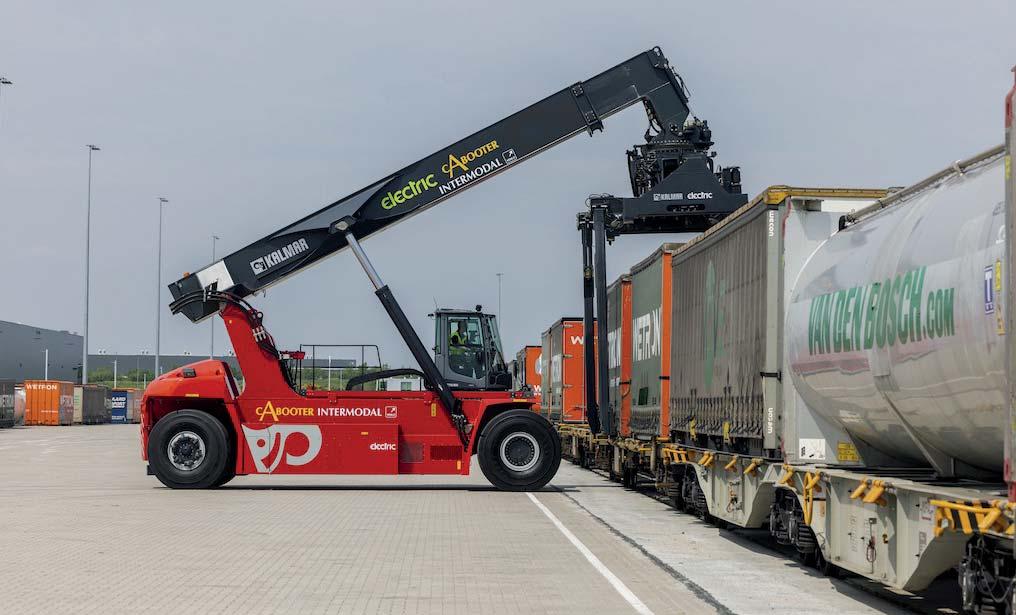
Cabooter Group is already utilising five Kalmar Eco reachstackers at its Venlo and also Kaldenkirchen terminal in Germany, as part of a desire to lower fuel costs and ensure reduced emissions.
LIEBHERR INNOVATION
Liebherr confirms several recent notable developments:
5 A new cabinless ship-to-shore container crane at Patrick Terminals – Brisbane AutoStrad, Australia. The unit utilises Liebherr’s Remote Operator Station (ROS) for pick and place over the vessel and allows the same level of crane control as an on-board operator but from
an office-based environment
This new semi-automated crane is the first of its type for use by Patrick Terminals, as well as one of the first cabinless Liebherr ship to shore container cranes to enter service globally.
Brisbane Autostrad already has two Liebherr ship to shore container cranes, with the unit supplied in 2015 recently undergoing a lift height and outreach extension using Liebherr’s transform technology so as to now offer an outreach of 54m.
5 Three big dual trolley ship-toshore container cranes to Hamburger Hafen und Logistik AG (HHLA), for the Container Terminal Altenwerder (CTA) facility at the Port of Hamburg, Germany. These units have a safe working load of 75 tonnes twin lift, at an outreach of 61m. The cabinless cranes operate via automation and remote control, which includes the Liebherr Remote Operator Station (ROS), for pick and place on the vessel. The use of two trolleys operating on a single crane ensures a mix of operational flexibility and increased efficiencies.
Konecranes Win
A public tender from Copenhagen Malmö Port (CMP) to supply container handling equipment for a new container terminal in Copenhagen has been won by Konecranes. As a result, eight hybrid straddle carriers will be delivered in Q4 2023, and two Ship-To-Shore (STS) cranes are scheduled for delivery in Q1 2025. The existing container terminal in Copenhagen is being moved to a new location in Ydre Nordhavn, with completion due in 2025.
HIT Solar Power
Hongkong International Terminals (HIT), operated by Hutchison Ports has received two new quay cranes, the first in the port featuring 84 solar panels on top of the machinery house. HIT explains the HK$78 million (US$10 million) investment:
“Energy collected will be used to power auxiliary systems including air conditioning and lighting systems in the quay cranes. With estimated three hours of exposure to sunlight every day, the photovoltaic system on quay cranes will be able to generate roughly 42,000Wh of energy with a 98.75% system efficiency.
For the latest news and analysis go to www.portstrategy.com JULY/AUGUST 2023 | 17 EQUIPMENT NEWS
8 Kalmar has delivered its first fully electric reachstacker to longstanding partner, Cabooter Group, after a six-month testing phase at the Cabooter Group’s Greenport Venlo intermodal terminal
WATCH ALL THE REEFERS, ALL OF THE TIME, WITHOUT TAKING A STEP
With visibility comes insight – a proven solution for true reefer container management. MTBS







STRATEGY
Port Policy
Port Sector Reform
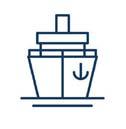
Value & Business Strategy
Public Private Partnerships
(National) Port Master planning
Institutional & Regulatory Change
Organisational Reform & Alignment

VALUATION
Feasibility
Business Case
Value Creation & Protection
Financial Modelling & Analysis






Project Structuring & Packaging
Risk Valuation, Allocation, Mitigation
TRANSACTION
Financial Solutions
Transaction Strategy
Transaction Management

Documentation & Contracts








Tendering & Negotiated Solutions

FINANCE
Due Diligence
Project Financing
Financial Structuring
Procurement of Finances
Investment/Divestment
Merger & Acquisition
value in the maritime
is the leading Unlocking
& transport industry MTBS.NL
BARRY PARKER
LINKING UP THE DATA SILOS

As readers are viewing this, the International Maritime Organization (IMO) meeting regarding the future path of shipping’s decarbonisation will have already occurred. The digitalisation sector, goes hand in hand with this objective; perhaps coincidently, but probably not - there has been an absolute explosion of data providers hoping to offer the shipping business (vessel owners, cargo interests, and everyone in between) products/ apps/platforms (take your pick!) to help “optimise”.
As I listened to a sudden burst of webinars just prior to the full -blown summer season, it occurs to me that something is missing from these vast “data lakes” (buzzwords loom large in the world of the shipping optimisers) meant to fine-tune vessel voyages. The missing element is data from the ports.
Some of the larger ports have trumpeted their databases, available to online viewers, of
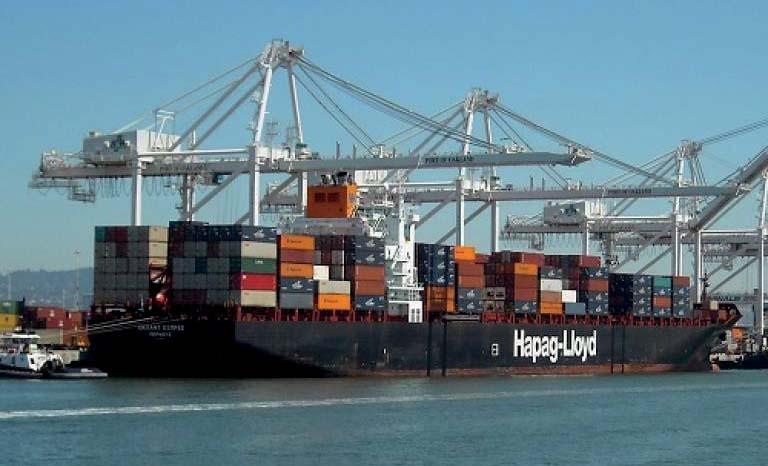
things like vessel arrivals, number of vessels waiting, and the like. Yet these are all discrete systems; they don’t hook up to optimisation systems aimed at the shipping companies (who could reduce their carbon emissions if the ships did not “hurry up and wait” because berths are not ready.)
There are no real common standards for such systems, so a few of the ports have developed APIs (application programming interfaces, yes) which can make
PETER DE LANGEN THEANALYST

The government of the city state of Hamburg recently published Hamburg’s port vision until 2040. The vision clearly describes the changing environment and discusses the initiatives to succeed in this new environment, with a strong focus on sustainability and digitalisation. This approach clearly is the ‘new normal’ in the ports industry. The following five observations are especially noteworthy.
First, while other ports have also indicated that they are shifting away from a ‘volume focus’, in which the tons handled are central to a port’s success, Hamburg probably does so in the most explicit way. Most news items the German and international press published at the launch of the vision focus on
found that the beauty of APIs is that the industry need not adhere to a precise set of data architecture, but they do need to make certain bits of logistical data (I am thinking berth availability and scheduling) available via the interfaces that will then feed disparate systems. For the management of the ports, it’s important for them to make their carrier and terminal customers, along with their in-house number crunchers and data boffins, clearly aware of the broader purpose of opening up this type of data to other applications.
data available to developers of voyage optimizer apps. Indeed, the data can also be viewed, and input into programming efforts on the cargo side, as well.
The exact nuts and bolts of how to write the code for a port’s data availability are beyond my low-tech grasp. However, I’ve
A welcome development would be for organisers of conferences directed at the port sector, to check out what the optimisers are saying when they are speaking at conferences (or, these days, webinars) directed at ship operators. The port side and the vessel side (including vendors of products that pull together data from multiple sources) ought to be talking to each other.
HAMBURG PUTS SUSTAINABILITY AND DIGITALISATION TO THE FORE
this point. The vision document does not present scenarios for the evolution of volumes or an assessment of additional capacity needs. Mostly implicitly, the vision suggests Hamburg can cater for eventual growth of demand for cargo handling through improving the productivity of existing facilities and assets.
Second, the vision emphasises Hamburg’s strength and growth potential as a port industriallogistics ecosystem, with opportunities for attracting new activities in energy production, circular manufacturing and maritime technology. The vision also suggests that the port authority (HPA) aims to take new steps in ‘designing’ this
ecosystem, for instance through maximising the use of rail and barge by companies located in the port and by promoting intensive land use.
Third, the vision shows Hamburg aims to benefit from growth opportunities in the cruise segment. This contrasts with other attractive port-cities like Amsterdam, Valencia and Barcelona, that explicitly or implicitly take an approach focused on improving the sustainability (in the ecological as well as social perspective) rather than the growth of cruise tourism.
Fourth -though this was not a recent decision- the ‘Hafencity’ redevelopment of older port areas will cross the river Elbe with
the development of the Grasbrook Neighborhood. As initially with the development of Hafencity, sceptics may rightly point out the increasing pressure this puts on the adjacent port activities, but this redevelopment undoubtedly creates value for residents and visitors alike.
Fifth, perhaps the best way to understand how we look at the future is through looking at past vision documents. In 2012 Hamburg published its plan for 2025. Then, it handled more than 130 million tons (compared to 120 in 2022) and forecast a volume of 296 million ton in 2025. Even without volume growth Hamburg remained a thriving port industrial-logistics ecosystem.
For the latest news and analysis go to www.portstrategy.com JULY/AUGUST 2023 | 19
THENEWYORKER
8 The better interchange of data between ports and shipping lines can assist in meeting decarbonisation challenges
Green Ports and Shipping Congress will identify and prioritise the areas that ports-based organisations and shipping companies need to collaborate on to reduce emissions.

Green Ports & Shipping Congress will cover a range of topics addressing the aspects of energy transition plans and


operations and ships.
Sessions and streams will focus on the required infrastructure, alternative fuel options/bunkering, technical solutions and how these align with the shipping lines and logistics chains.
It is a must-attend event for policy makers, ports and terminal operators, shipping companies, shippers and logistics companies, fuel & propulsion providers, decarbonisation clusters.

Media partners: PORTSTRATEGY INSIGHTFOR PORTEXECUTIVES GREENPORT INSIGHTFOR PORTEXECUTIVES MOTORSHIP MARINETECHNOLOGY THE Visit www.greenseascongress.com Supporters:
For further information about speaking, sponsoring or attending as a delegate,
the Events
Register your interest now!
contact
team on +44 1329 825335
HACKETT
NO CAUSE FOR OPTIMISM
The lights are off on economic growth as the volume of trade continues to decline, we should not be overly optimistic about the 3rd quarter.
The world’s major economies are struggling to keep out of recession, according to the technical definition of two quarters of GDP decline. The U.S. has managed to avoid officially being designated as in recession, as has the struggling UK, but only just. The once mighty German economy is technically in a very mild recession which is causing much debate about how to bring the economy back to its once consistently strong growth. China also has issues with economic growth below five per cent.
Taking the old GDP measure as an indicator of the economy today has little to guide us in the near-term future and maybe not even over the longer term as economists are beginning to tell
us. I have always been critical of using GDP growth as a means of looking forward for 12 months. What we are seeing in the figures published by various countries’ economic institutions is that there is hardly a twinkle of growth underlying economic activity as consumers struggle with high inflation in foodstuffs and services leaving little room for expenditure on the nice things to have, consumer goods.
MIKE MUNDY THE


STRATEGIST
As we look at the volume of import trade on the three big head-haul routes it is very clear that there is a problem with growth. There isn’t any! It is virtually all negative except for the odd hiccup such as the Panama Canal water crisis which
is causing cargo to be off-loaded on the U.S. West Coast instead of on the East Coast. This is a leading indicator of bad things to come as retailers are still trying to get rid of high inventories of unwanted goods.
Carriers continue to introduce new capacity, particularly the larger vessel sizes over 20,000 TEU capacity, adding to their headaches of sharply declining revenue as freight rates have collapsed in line with declining import demand in North America and Europe.

Freight rates across the major trading lanes have continued their downward trend. Most carriers have managed to avoid losses, but the pressure is on to hold on to the little positive that is left. Ports and terminals are also feeling the pinch as a result.
Perhaps if you are on vacation, extend the time away!
Just before PS was about to go to press, I was sitting in the basement coffee shop of Waterstones bookshop in Piccadilly, London, chatting with a colleague/friend and among the various topics we covered was the remarkable lack of infrastructure and systems under development to support the global shipping industry’s greater use of low carbon fuels. Was there a spy in the sky, who was listening?
Well, it seems a number of countries – specifically Canada, Norway, Panama, Uruguay and the United Arab Emirates (UAE) –plus the International Chamber of Shipping (ICS) and the International Association of Ports & Harbors (IAPH), who, hot on the heels of this discussion, on the 20
CLEAN ENERGY MARINE HUBS INITIATIVE LAUNCHED
July, launched the Clean Energy Maritime Hubs Initiative (CEMHubs). Announced in Goa, India CEM-Hubs aims to bring together the private sector and governments across the energy-maritime value chain “to transform maritime transportation and production hubs for future low-carbon fuels.”
The founding partners in the initiative emphasise: “The energy maritime value chain is far from ready to transport the influx of low-carbon fuels that are expected between now and 2050. To accommodate demand,” they elaborate, “the shipping industry is expected to transport at least 50 per cent of all traded low carbon fuels by 2050, according
to the International Renewable Energy Agency (IRENA). But the production centres, vessels and port infrastructure required to accommodate expected demand do not currently exist at commercial scale.”
Further underlining the size of the challenge, they point out that to-date, “only one ship in the whole global fleet has been piloted to transport liquefied hydrogen – travelling from Australia to Japan.” And that: “For hydrogen derivatives such as ammonia and other low-carbon fuels moved by ships, the scale is far from what heavy industries, transport and other sectors would require. To support the global transition to
net-zero targets, shipping is expected to transport between two and up to five times the low carbon fuels it will consume by 2050.”
The initiative is clearly a much needed one with it adopted less than a year after it was first presented, in an unprecedented move by the Clean Energy Ministerial (CEM). This again underlines the immense scale of the problem and urgency to establish solutions.
Well done all those involved –let’s get cracking!
It is not just an area that must be addressed but also as Patrick Verhoeven, Managing Director, IAPH, points out, a significant area of business opportunity.
For the latest news and analysis go to www.portstrategy.com JULY/AUGUST 2023 | 21
BEN
THEECONOMIST
8 Typifying today’s difficult market – Cosco Shipping anticipates a 74 per cent fall in earnings with bargain basement container rates in-play
OCT 2023 Lisbon Portugal
Port of Lisbon, Lisbon • Portugal
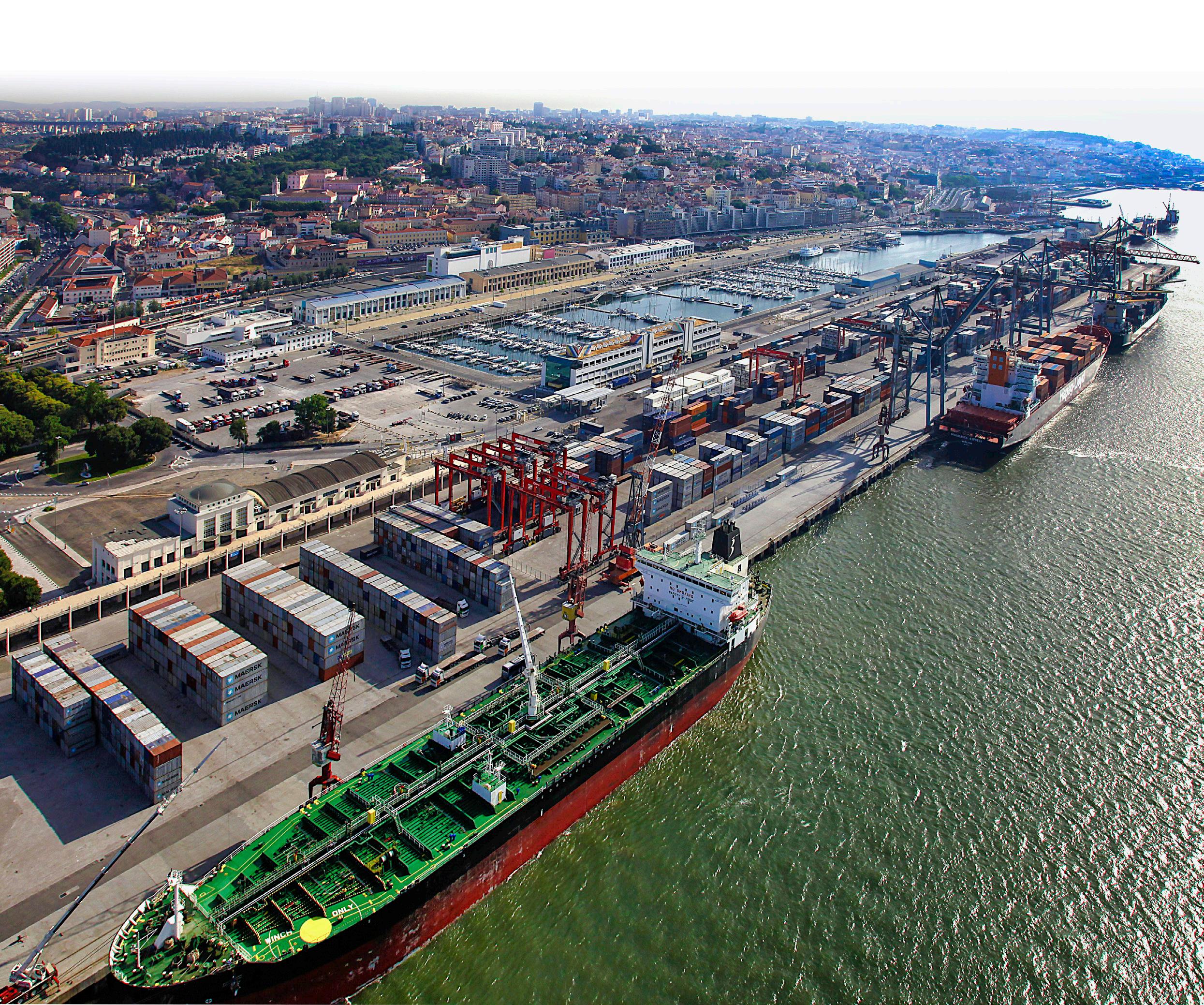
Host Port:


Conference Programme
Balancing environmental challenges with economic demands
Sponsored by:

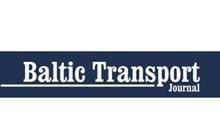
Supported by:
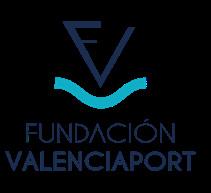
Balancing Environmental Considerations with Economic Demands. The world’s leading conference on sustainable environmental practice comes to Lisbon.
Join us for two days of conference presentations and learn from the foremost experts in environmental technologies


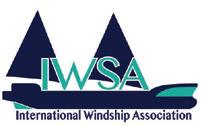
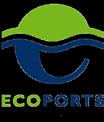
visit: greenport.com/congress contact: +44 1329 825335 email: congress@greenport.com


Media Partners:

#GPCongress
Tuesday 17th October 2023
Welcome Reception - Hosted by the Port of Lisbon
DAY ONE - Wednesday 18 October 2023
08:30 Coffee and registration
09:30 Opening by Chairman/Moderator
Christopher Wooldridge, Science Coordinator EcoPorts EcoSLC, and Visiting Research Fellow, Cardiff University, UK
09:40 Welcome Address by Port of Lisbon
Keynote Panel
10:00 Climate Change: Energy efficiency, GHG emissions reduction & adaptation
-11:10 The risks to Ports, Shipping & the Logistics from climate change are increasing. This panel will discuss options available to combat these risks hearing from ports, shippers, and companies across the maritime industry. Confirmed panellists include Isabelle Ryckbost, Secretary General , ESPO; Nicolette van der Jagt, Director General, CLECAT; Isabel Moura Ramos, Executive Board Member, Port of Lisbon Authority
11:10 Coffee & Networking
11:30 Going Green: How can a Cruise Terminal be more sustainable
Duarte Morais Cabral, General Manager, Lisbon Cruise Port
11:45 Opportunities, Risks & Threats regarding “Cold Ironing” in Ports - “The case of Heraklion Port”
Minas Papadakis, CEO, Heraklion Port Authority
Cold ironing is the major way that ports can contribute to reducing shipping’s emissions. The administration of Heraklion Port has set the green transition as our top priority. The European program the “Electriport” was the result of our efforts towards a greener and sustainable port.
12:00
Shore-to-Ship Connection at Cruises and Cargo Terminals of the Lisbon Port
Armando Santos, Global Partner - Client Manager - Energy and Industry, Quadrante
11:30 The Port of Helsinki - A carbon-neutral port Andreas Slotte, Head of Sustainable Development, Port of Helsinki
11.45 Miguel Matias, CEO, KEME Energy, Lda
12.00 Carbon Capture in the green transitionPorts as the entry to make CCUS/CCS & transport feasible
Ralph Guldberg Bjørndal, Senior Chief Project Manager, Ports, Marine & Coastal, Ramboll Ramboll is conducting a pre-feasibility study, outlining how carbon capture facilities can be implemented, and how port facilities shall be established to support the shipping of CO2 to the final storage destination. Various shipping options are considered, together with an assessment of how the expected CO2 Hub system might evolve.
12:15
Transforming Cruise Infrastructure: Global Ports Holding’s Expansion while Developing Future-Ready CruisePorts
Stephen Xuereb, COO, Global Ports Holding
Discover Global Ports Holding’s (GPH) remarkable expansion in transforming cruise infrastructure and its commitment to developing future-ready ports. With a global network of 27 ports across 14 countries, GPH brings together years of experience, operational expertise, and collaboration to revolutionize the cruise industry. Join this session to gain valuable insights into GPH’s expansion and its strategies for developing future-ready cruise ports in shaping the cruise infrastructure of tomorrow.
12:30
Question & Answer Session
12:30
Question & Answer Session
12:45 Lunch & Networking
Session 1.1: Cruise Infrastructure Development
Session 1.2: Carbon Neutral Ports
Book Online at https://www.portstrategy.com/greenport-cruise-and-congress or fax form to +44 1329 550192 For further information please call +44 1329 825335 or email congress@greenport.com
Shore Power
14:10 Port of Toulon - utilizing energy storage
Luca Imperiali di Francavilla, Global Product Manager, ABB
The use of renewable energy sources at ports supports the Shore Connection when ships are connecting to it. We believe different shore connection applications will ultimately play a big role in decarbonizing the marine and ports industries. ABB will present to the audience a case example of Port of Toulon, one of ABB’s project deliveries, which is utilizing energy storage as part of shore connection.
14:25 What kind of options do ports have in their carbon neutrality journey?
Laurent Dupuis, VP Global Product Manager
Ports & Maritime, Cavotec
In this presentation, Cavotec will compare the emissions reduction potential of different solutions for several ports and terminal types (cruise, ferries, container) to shed some light on how ports can create the best journey towards carbon neutrality.
14:40 Reliability and availability return of experience, from years of power conversion in Vessel Electrical Conversion systems, and Oil and Gas systems.
Alex Lagarde. Conversion’s Energy Conversion Expert & Business Development Manager, GE Vernova
This presentation will explore reliability aspects of large power converter (range between 5MVA and 20MVA), based on more than 30 years of return of experience on critical electrical systems.
14:55 OPS and the strategic challenges for a port authority, the case of the sea cruise in Port of Amsterdam
Jan Egbertsen, Manager Innovation, Port of Amsterdam
OPS is in the clean shipping strategy of Port of Amsterdam one of the three pillars. The other pillars are the development of clean fuels in the shipping industry ad IT. Port of Amsterdam has already invested in OPS for barges and river cruises in the city area and is now building an OPS installation for the sea cruise terminal of Amsterdam. The development of OPS in a port asks for a close cooperation between the relevant terminals and the port authority.
15:10 Questions & Answers
15:30 Coffee & Networking
2.2 – Infrastructure Development for Ports
14:10 Bruno Vale, General Manager, YILPORT LISCONT
14:25 Energy Recovery & Storage for Ports –Where Energy Supply Meets Demand
Justin Hollingsworth, Business Development Manager, TMEIC
Energy storage systems (ESS) are a great asset when transitioning to renewable energy sources, and they also play a role in strengthening and managing demand on a local grid. This presentation will consider the benefits of ESS within a port and the use cases of distributed energy recovery and centralized energy storage.
14:40 H2PORTS Project: A First Operational Experience Using Hydrogen Powered Machinery at A Port Terminal
Aurelio Lazaro, R&D Engineer, Environmental Sustainability and Energy Transition, Fundación Valenciaport
This work will present the outcomes of the project that will include not only the feedback from this real operation experience but also the lessons learned during it development phase and the analysis of crosscutting aspects of the project such as legislation, replicability, market uptake and human awareness related with the use of hydrogen at ports.
14:55 Decarbonising terminal operations: Reaching a tipping point in battery-electric container handling equipment
Sahar Rashidbeigi, Head of Decarbonisation, APM Terminals
The global shipping industry needs to decarbonise container handling equipment (CHE) to meet emission reduction targets, address demand from customers, and deliver social benefits. Battery-electric CHE is the preferred option, but is still an early-stage market and needs action to reach a tipping point on affordability, attractiveness, and accessibility. This presentation will share which actions are needed for large-scale roll-out of decarbonised CHE.
15:10 - Question & Answers
Session 2.1
–
Session
Book Online at https://www.portstrategy.com/greenport-cruise-and-congress or fax form to +44 1329 550192 For further information please call +44 1329 825335 or email congress@greenport.com
Session
3.1 Port Endeavour Session 3.2 ESG - Environmental, Social and Corporate Governance Workshop
15:50 Faciliator: Antonis Michail, Technical Director, International Association of Ports and Harbors (IAPH)
Port Endeavor draws on real life examples from the 200+ strong IAPH World Ports Sustainability Program (WPSP) database of projects and best practices on how ports integrate the UN Sustainable Development Goals (UN SDGs) into their business models and operations. The aim of the game is to increase awareness among port management, staff and professionals working in port communities on how ports are already applying the UN Sustainable Development Goals to their business, to ultimately accelerate adoption of these measures in the port sector.
17:20- Day 1 Round up - Christopher Wooldridge
17:30 Conference Close
15:50 Workshop facilitator: Christopher Wooldridge (Cardiff University - UK)
The workshop will investigate: What are the benefits and value of ESG approach, How do you initiate ESG into your port’s management framework, How do you identify key components, how does it enhance decision-making and what are the links with sustainability?
7-10PM CONFERENCE DINNER – HOSTED BY THE PORT OF LISBON
DAY TWO - Thursday 19th October 2023
08:30 Coffee and registration
09:00 Opening by Chairman/Moderator
Christopher Wooldridge, Science Coordinator EcoPorts EcoSLC, and Visiting Research Fellow, Cardiff University, UK
09:10 EXCLUSIVE LAUNCH - ESPO Environmental Report
Anaëlle Boudry, Senior Policy Advisor for Sustainable Development, Energy and Blue Growth, EcoPorts Coordinator, ESPO
09:30 EXCLUSIVE LAUNCH - ECO SLC Environmental Report
Christopher Wooldridge, Science Coordinator EcoPorts EcoSLC, and Visiting Research Fellow, Cardiff University, UK
09:50 Ms. Lamia Kerdjoudj, Secretary General, FEPORT
10:30 Coffee & Networking
Book Online at https://www.portstrategy.com/greenport-cruise-and-congress or fax form to +44 1329 550192 For further information please call +44 1329 825335 or email congress@greenport.com
10:50 Faciliator: Antonis Michail, Technical Director, International Association of Ports and Harbors (IAPH)
Port Endeavor draws on real life examples from the 200+ strong IAPH World Ports Sustainability Program (WPSP database of projects and best practices on how ports integrate the UN Sustainable Development Goals (UN SDGs) into their business models and operations. The aim of the exercise is to increase awareness among port management, staff and professionals working in port communities on how ports are already applying the UN Sustainable Development Goals to their business, to ultimately accelerate adoption of these measures in the port sector
&
10.50 Wavec Offshore Renewables
11.05 Methanol as a Marine Fuel?
NABU study by Öko-Institut (Institute for Applied Ecology)
Malte Siegert, Head of Environmental Policy, Naturschutzbund Deutschland (NABU / Nature and Biodiversity Conservation Union)
NABU will present the major findings of the study “Methanol as a Marine Fuel” highlighting especially the environmental benefits of e-methanol.
11.20 EALING (European Flagship Action for Cold Ironing in Ports) Project
Rocío García Molina, Innovation & Port Cluster Development, Fundación Valenciaport
EALING (European Flagship Action for Cold Ironing in Ports) is a 42-month project, co-funded by the Connecting Europe Facility (CEF), which, in addition to carrying out all the technical, environmental, socio economic and financial studies necessary to prepare the works for the installation of shore-side electricity in 16 ports from 8 EU Member States, aims to work towards a harmonised and interoperable framework in the EU.
11.35 Ports of Bremen in the energy transition–fulfilling social obligations, seizing opportunities
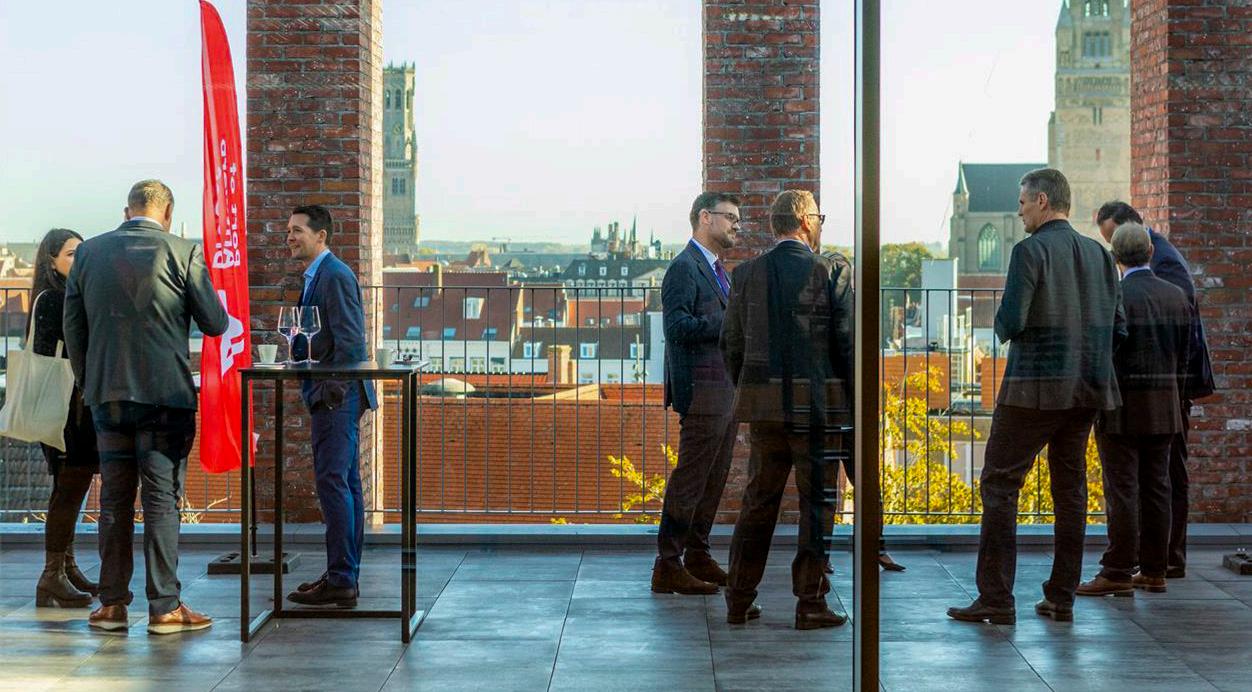
Dr. Janna Köhler, Advisor for hydrogen and decarbonization, Free Hanseatic City of Bremen, Ministry of Science and Ports
Ports of Bremen have formulated the goal of achieving climate neutrality by 2035, together with the relevant port stakeholders. While this poses great challenges on different levels, the energy transition also opens up new opportunities.
11:50 Question & Answer Session
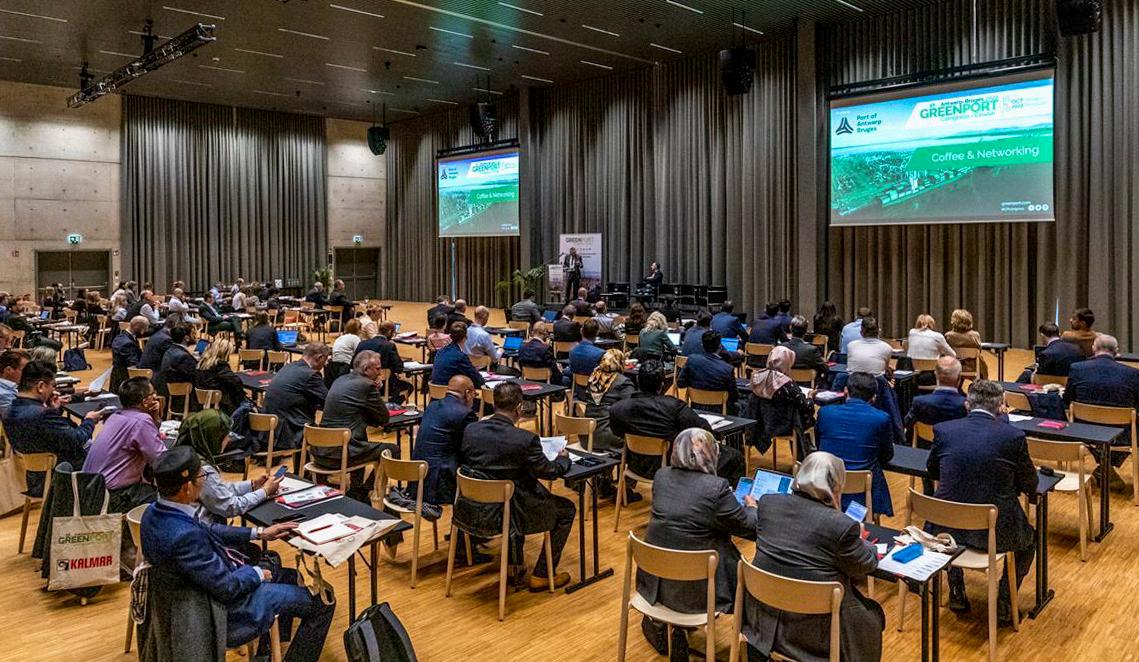
Lunch & Networking Book Online at https://www.portstrategy.com/greenport-cruise-and-congress or fax form to +44 1329 550192 For further information please call +44 1329 825335 or email congress@greenport.com
Session 4.1 Port Endeavour Session 4.2 Offshore Renewables
Alternative Energies 12:20
13:40 Waste Management on a Technical Level
Brian Elliot, Senior Project Officer in Unit Sustainability, Department Sustainability and Technical Assistance, European Maritime Safety Agency
13:55 Generating hydrocarbon products from maritime waste: Ecoslops’ experience on profitable circular economy within ports
Vincent Favier, CEO, Ecoslops

Ecoslops is an innovative cleantech that brings oil into circular economy. The solutions have been developed to help ports manage their waste in a more efficient and environmentally friendly way. The technology allows the recycling of oil residues from ships, as well as land-based hydrocarbon residues (yc used lub oil) that are often considered hazardous and difficult to dispose of.
14:10 Target Zero: Zero Waste to Landfill at the Port of Dover
Ben Crake, Environment Advisor, Port of Dover
14:25 Port Reception Facilities
Sophie Delair, Secretary General, Euroshore Port Reception Facilities play a key role together for supporting the maritime industry to reduce its carbon footprint, greening ports and preventing marine pollution. The presentation proposes a plead for the installation of adequate port reception facilities where necessary as there are some gaps. What a port reception facility is and their constraints are not always understood as they face maritime and land legislations which are not the same and even vary from one country to another
14:40 Question & Answer Session
13:40 Ports: hubs of the new blue economy
Ruben Eiras, Secretary-General, Fórum OceanoPortugal Blue Economy Cluster
13:55 Tiago Fernandes, Head of Logistics, Port of Lisbon Authority
14:10 Clean Ports, Clean Oceans: Improving Port Waste Management in the Philippines
Vilde Lyngstad Hageselle, Environmental Advisor and External Relations, Grieg Green
WWF will present the solutions conducted with the port and city authorities, such as the development of a materials recovery facility in the port of Cagayan de Oro, the collection and recycling of plastic waste in the ports of Manila North Port and Batangas, and will share how activities with other stakeholders in the port area have been developed collaboratively to ensure their sustainability.
14:25 Update on the Silk Alliance green corridor, a Singapore bunkering cluster Ahila Karan, Senior Decarbonisation Analyst, Llyod’s Register
14:40 Question & Answer Session

5.1:
Session
Waste Management and Circular Economy Session 5.2: Blue Growth
Book Online at https://www.portstrategy.com/greenport-cruise-and-congress or fax form to +44 1329 550192 For further information please call +44 1329 825335 or email congress@greenport.com
15:00 Coffee & Networking
Session 6: Digitalization and Technology
15:30 Delivering resilient supply chains
Steffen Siebert- Head of Sales Europe, Middle East & Africa at S5 Agency World
For complex supply chains to work, digital solutions are needed to facilitate transparent and clear lines of communication. Steffen will delve into how these softwares can optimise port operations; increasing productivity and reducing emissions.
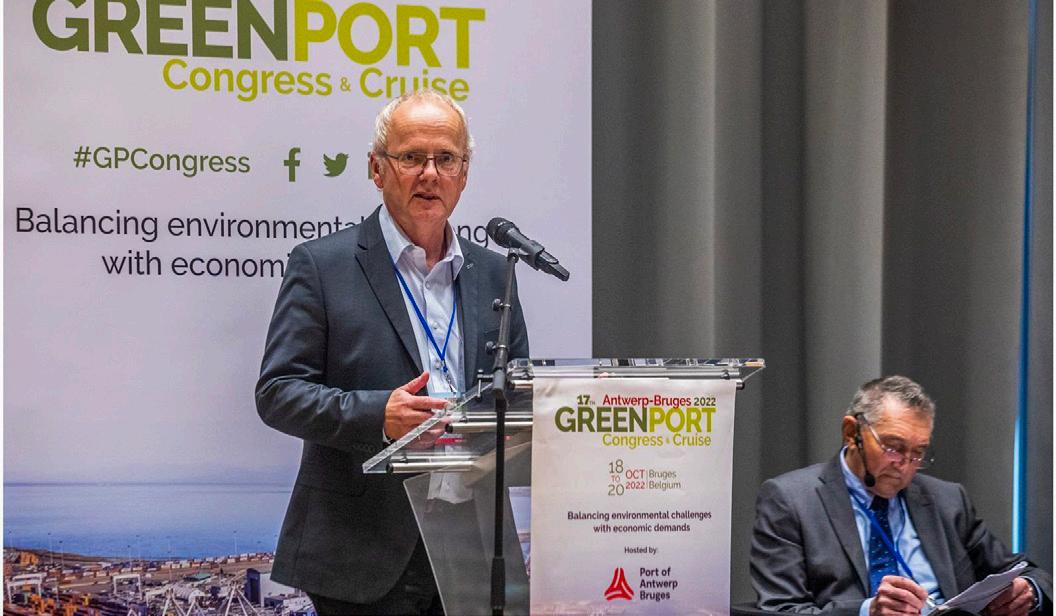
15:45 Moving on the Mersey – a localised approach for technology deployment to deliver emission reductions in leisure, freight, and passenger transport.
Richard Willis,Technical Director Port Operations & Technology, RoyalHaskoningDHV
Working together with local stakeholders across the maritime sector in the Liverpool City Region we studied where the use of river-centric transport modes blended with low-carbon technologies could transform both the under-used waterways in the city and reduce impact of air quality upon the residents.

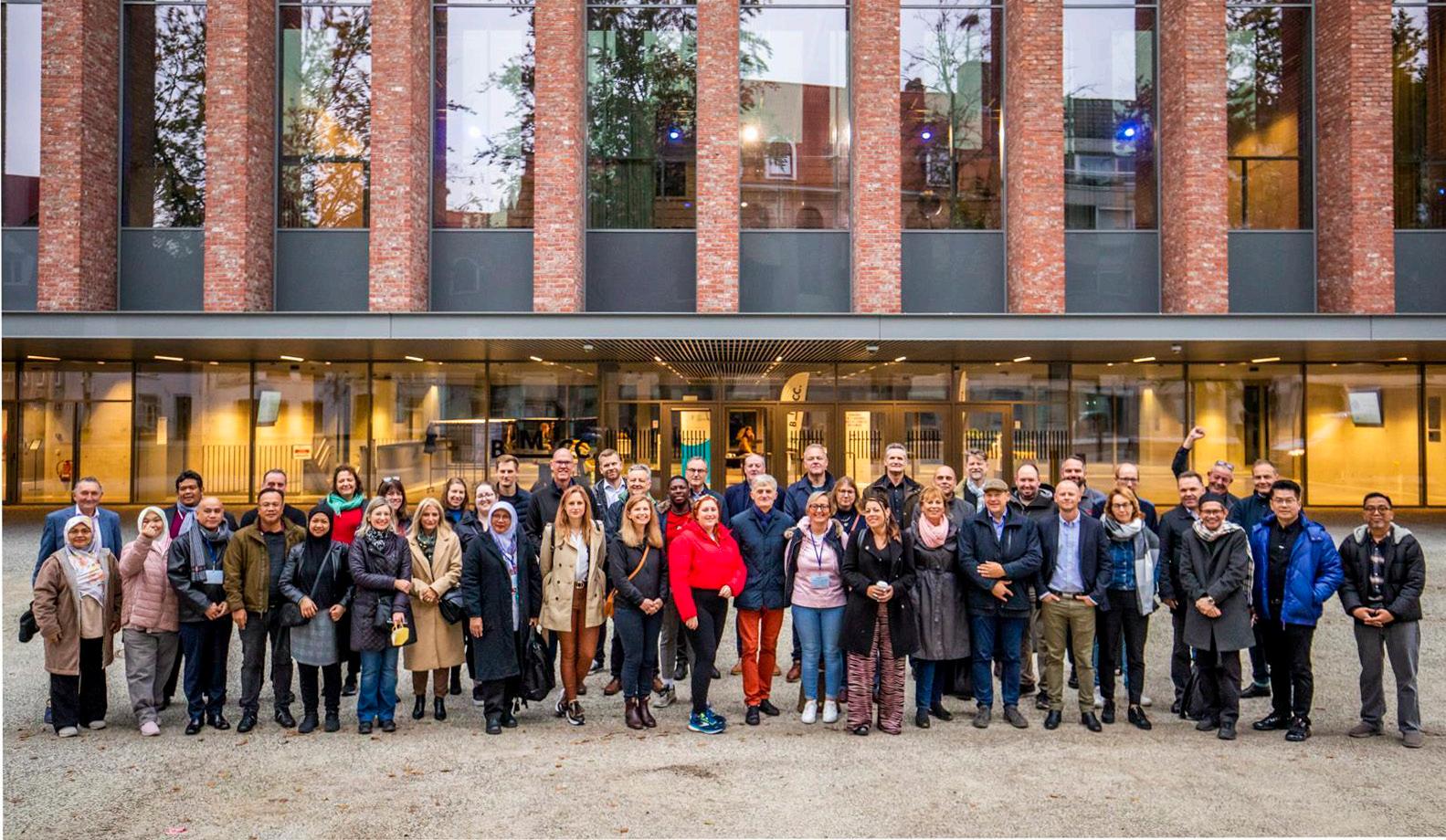
16:00 Concrete use cases and experiences in utilising data analytics, AI and simulation to increase productivity, sustainability and safety
Miika Murremäki, Head of Digital Solutions, Kalmar
By leveraging analytics, AI, and simulation, cargo handling equipment experts can help ports to increase productivity, sustainability and safety. This can ultimately help ports to remain competitive in a rapidly changing industry. Kalmar will present on the main use cases
16:15 LSYM Port Simulators developed by the University of Valencia
Pablo Galán, Head of Business Development, e-nquest
Our mission is to accelerate the port industry’s transition to digitalized training. We develop training systems with simulators, capable of reproducing the working environment of real machinery used at the terminals like quay cranes, mobile harbor cranes and vehicles like heavy forklifts or reach stackers among others
16:30 Question & Answer Session
16:50 Conference Wrap up by Conference Chairman/Moderator – Christopher Wooldridge
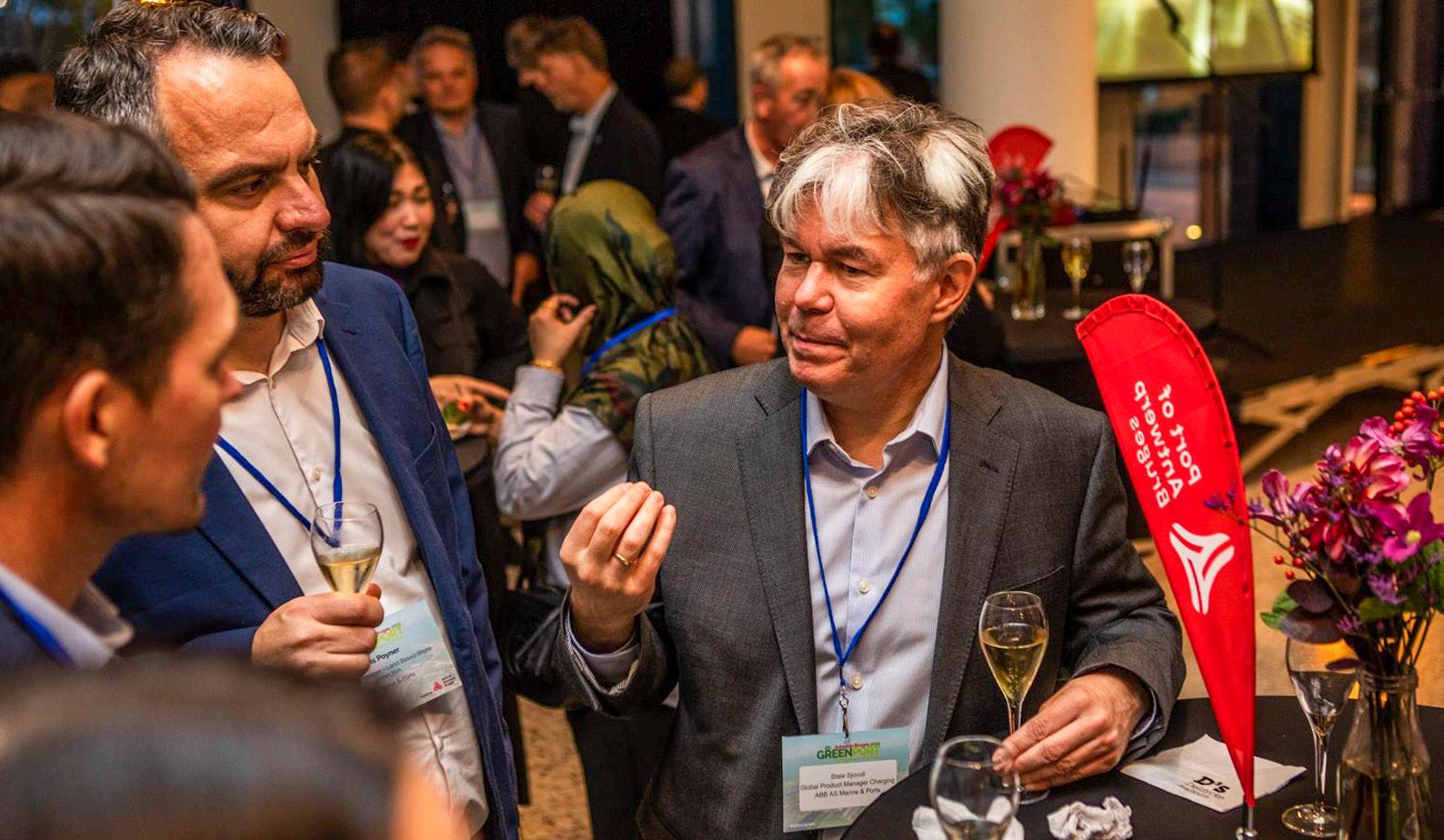
17:00 Conference Close
DAY THREE - Friday 20th October 2023
PORT TOUR OF LISBON
Book Online at https://www.portstrategy.com/greenport-cruise-and-congress or fax form to +44 1329 550192 For further information please call +44 1329 825335 or email congress@greenport.com
Conference Fee
Cost per delegate (standard rate)
• Cruise – One Day event €1,100
• Cruise & Congress – €2,160
Booking Online greenport.com/congress or complete and fax the booking form below to +44 1329 550192. On receipt of your registration, you will be sent confirmation of your delegate place
Cruise Fee Includes
Attendance of Cruise conference streams on day 1, full documentation in electronic format, lunch and refreshments, place at the Welcome Reception and place at the Conference Dinner.
Cruise and Congress combined Fee Includes Choice of conference streams for GreenPort Cruise on day 1, two day conference attendance at GreenPort Congress, full documentation in electronic format, lunch and refreshments throughout, place at the Welcome Reception, place at the Conference Dinner, place at the Port Tour.
CONTACT US
For further information on exhibiting, sponsoring, or attending the conference, contact the Events team on: +44 1329 825335 or congress@greenport.com
BOOKING FORM
OCT 2023 Lisbon Portugal
BOOK ONLINE OR COMPLETE THIS FORM AND FAX TO +44 1329 550192
(Please copy this form for additional delegates)
Please tick all that apply :
Please register me for GreenPort Cruise 2022 (1 day)
Please register me for GreenPort Congress 2023 (2 days)
Please register me for the virtual GreenPort Congress 2023 Conference Dinner (18th Oct 2023) – No additional cost
Welcome Reception (17th Oct 2023) – No additional cost
Port tour (20th Oct 2023) - No additional cost
Members of supporting associations will receive a 10% discount
I am a member of
HOW TO PAY *UK registered companies will be charged the standard rate UK VAT Bank Transfer: Mercator Media Ltd, HSBC Bank plc, EUR account, Sort Code: 40-12-76, Account number: 70235247
SWIFT/BIC8: HBUKGB4B BRANCH BIC11: HBUKGB41CM1 IBAN: GB35HBUK40127670235247
Credit/Debit Card: Complete the form with your card details
I have paid by bank transfer
Please charge my card (delete as appropriate) Mastercard/Visa/Amex
Card Number
Name on Card
Credit Card Billing Address
Code
Further information call +44 1329 825335 or email congress@greenport.com. Book online at greenport.com/congress
Title Mr/Mrs/Ms/Dr/Other Fax Company Email
Signature
Family Name Country First Name Telephone
Job Title
Company Address Company VAT No.
SPACE AT THE CONFERENCE IS LIMITED – RESERVE YOUR PLACE TODAY! Book online at https://www.portstrategy.com/greenport-cruise-and-congress or fax booking form to +44 1329 550192 Registered in England. Company Number 2427909. Mercator Media Ltd reserve the right to alter the timing, content or speeches of this conference at any time. Full terms & conditions for this booking are available at mercatormedia.com/our-business/terms-and-conditions (3 Numbers on the reverse/ AMEX 4 numbers on front)
Expiry Date Security
Signature
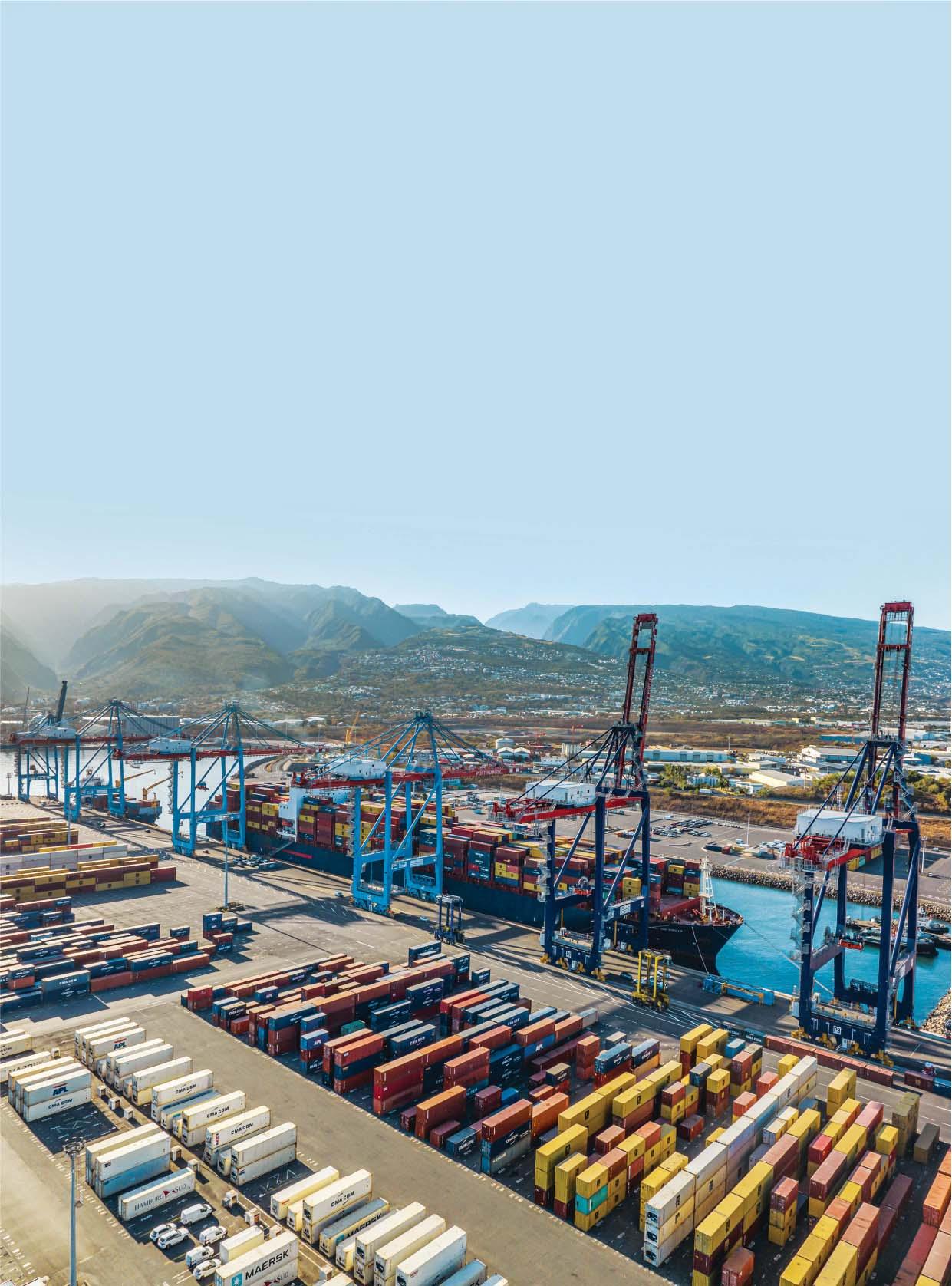















TERMINAL CONCESSION
DAR SWIMS AGAINST THE TIDE
The Tanzania Ports Authority appears to be swimming against the tide (accepted best practice) in its approach to awarding the concession for the Dar es Salaam Container Terminal. It is difficult to understand why!
The award of the concession for the Dare es Salaam Container Terminal, the operating unit known as Tanzania International Container Terminal Services (TICTS), appears to be taking a course that contravenes Tanzanian Government policy.

With the termination of the concession held by Hutchison Ports for the terminal, the Tanzanian Ports Authority (TPA) has been the recipient of a number of unsolicited offers to take over the operation of the terminal with the main names mentioned in this respect being Adani Ports and Special Economic Zone Ltd (AP&SEZ), A D Ports and D P World. Adani is now in residence at the terminal, working on behalf of the TPA on a management basis, but at the time of writing, in mid-July, the bush telegraph beats that it is the entity that looks most likely to be awarded the terminal on a long-term concession basis.
This all appears a bit strange, however, as the TPA has reiterated time and time again that its main goal with TICTS is to raise its performance to a higher efficiency level. Accepted practice in the sector is that the route to attain international standards of efficiency is by a competitive bid situation, with each bid containing a financial and detailed technical component presenting in detail how the various elements will work together to achieve the required levels of efficiency. Certainly, this is the approach favoured by such eminent entities as the World Bank, International Finance Corp, African Development Bank and the SSATP, the umbrella organisation representing 41 African countries, including Tanzania, and other organisations that seek to facilitate policy development and related capacity building in the transport sector in Africa. Indeed, the SSATP in its Working Paper NO. 1O7, Container Terminal Concession Guidelines, very clearly states:
“The paramount concern of governments and public authorities when entering any kind of public-private partnership arrangement, like a container terminal concessioning process, is to ensure, and demonstrate to their constituents, that it will produce value for money, i.e. they will get more out of it compared to what they were getting with the traditional public operated system, and hopefully at a better price. To this end, they must convince all stakeholders that the commercial partner they will select is indeed the most capable of producing this outcome. A very effective way to go about this is to organize an open international competition. If properly managed, it will mechanically ensure the port is getting the best possible partner at this particular point in time. It will also avoid the suspicion that almost systematically comes in case of a direct negotiation with a single project sponsor. And as exposed before, a number of players are available today to compete for these concession contracts. So whenever possible, organising an international tendering process should be the preferred option to seek a professional operator for a container terminal.”
What is even stranger, however, is that following the publication of the latest report of Tanzania’s Controller and Auditor General, covering the 2021/2022 financial year, it was stated in the media that Samia Suluhu Hassan, President of Tanzania, was to set to crack down on irregular deals referenced – effectively signposting to government agencies
the need to follow best practice. Potentially, the TPA in its current actions with TICTS can be seen to be out of sync with this ethic. It is certainly, at the very least, making itself open to accusations of corruption or lack of comprehensive effort in securing the best terminal operator.
8 Strangely the Tanzania Ports Authority is pursuing a process of direct negotiation with select parties rather than an open competitive tender to award the new concession for the Dar es Salaam Container Terminal
TICTS is not just an important terminal for Tanzania but also fulfils the role of a key gateway terminal for surrounding landlocked countries including Uganda, Burundi, Rwanda, DRC, Zambia and Malwai. Millions of dollars have been pumped into capacity building the road and/or rail connections providing links between these countries and Dar es Salaam port, injecting further impetus to make sure the vital interface between land and sea of Dar’s container terminal is operating consistently at maximum efficiency. Invariably, these dollars come from external sources, as is the case with virtually all the US$10.04 billion funding for the recently signed contract with a Chinese company for the development of a standard gauge railway that will run from Tanzania’s ports to Burundi, DRC and Rwanda, as well as to Uganda through the Lake Victoria port of Mwanza. The stakeholders involved will doubtless wish to ensure there are no impediments in the supply chain, especially at port gateways, that impede overall system performance.
The TPA would appear to be well advised not to follow the often problematic approach of direct negotiation for the TICTS concession but to take up the more proven option of a competitive tender.
DAR ES SALAAM CONTAINER
For the latest news and analysis go to www.portstrategy.com JULY/AUGUST 2023 | 23
‘‘
The TPA approach to concessioning the Dar container terminal appears to contravene government policy…it is hard to understand why!
TAPPING TRANSSHIPMENT
The recent expansion of West African dry bulk exports has focused attention on transshipment to reduce transport costs. The issues here are complex. Andrew Penfold takes a look at the pros and cons….
Diversification of dry bulk supplies has been the focus of much recent attention. A partial shift in focus to, for example, West Africa as a source of iron ore and bauxite for Chinese consumers has focused the spotlight on the economic delivery of these commodities as alternatives to established suppliers such as Australia and Brazil.
The snag in this strategy is the lack of true deepwater export terminals in many of these nascent suppliers. Although dry bulk freight rates have fallen back sharply since their peak in 2021, rates remain slightly above their long-term average. The relatively low value of dry bulk commodities results in market share being dependent upon CIF prices, with a focus on freight costs within this total. On this basis, the differential between Cape Size and smaller tonnage costs is central to the calculation. Last year, Handysize bulk carrier rates averaged around US$21,500, with Capesizes earning US$16,100 per day (source: Clarksons). This rate inversion was the result of a weakening of the supply/ demand balance for iron ore and coal trades, and a relatively healthy balance in smaller size ranges.
The overall effect of these differences in scale economies has been that exporters relying on restricted port infrastructure have seen CIF prices stick at much higher levels – with this adversely impacting on volumes shipped.
Transshipping bulk commodities has a long track record in the trades, with the offshore transfer of goods from a smaller vessel (or barges) to a large Capesize vessel now well established. It seems certain that the forces driving this will intensify as port investment lags demand. It’s certainly worth a look at the options here.
THE RATIONALE
The freight savings per tonne for, say, iron ore shipped from West Africa to China in a Capesize as opposed to a Handysize vessel are currently estimated at between US$15-20. At the 2021 peak of the market this was much higher and reached over US$45 per tonne. This represents a long-term differential that clearly justifies innovative solutions. This is not new technology, with offshore transshipment – ‘topping-off’ –established in the dry bulk market where load (or discharge) facilities are limited. Against this saving must be set the costs of establishing a transfer facility in often remote locations and the degree of financial security a service provider will require while providing the technical reliability the cargo owner must have. Also, the cost of chartering either a smaller bulk carrier or a fleet of barges must be factored in.
Despite these complexities, transshipment provides a realistic means of entering high volume bulk trades where landed commodity prices would otherwise be uncompetitive.
There are several specialist shipping companies that offer these services, with the translation of these cost savings into an actual long-term proposition requiring highly skilled capabilities.
DIFFERENT APPROACHES
The development of a floating crane pontoon, sometimes with storage and often using a series of barges, has been an
established way of meeting transshipment requirements for many years - for example, Indian iron ore exports have long used this method. Although overall system costs are low the speed of handling is slow and there is always considerable cargo loss. These issues can be minimised with custom designed units and specialist operations but, of course, the costs soon escalate.

Another method is the use of self-unloading bulk carriers to top-off the deepsea unit. High-capacity gravity belt-fed systems are very competitive. If a large Capesize vessel can be partially loaded at the quay or loading jetty and then transferred to deeper water to be completed by a selfunloader, then a highly efficient system is possible. Selfunloaders such as Canada Steamship Lines’ (CSL) Panamax CSL Acadian can achieve discharge rates of between 50006000 tonnes per hour, depending on the commodity. CSL also has designs for various vessel sizes offering a gravity-fed discharge rate of up to 10,000 tonnes per hour.
The choice between a long-term commitment with a higher investment in such systems in contrast to a lower tech (and slower) grab-based system will always be case-specific, but the systems are available for varying throughputs and situations – it will always require a bespoke solution. Can this be a long-term solution or a means of moving commodities ahead of large-scale port development?
OPPORTUNITIES: WEST AFRICA DOMINATES
West Africa is the current focus of attention for the reasons listed. Essentially, the main opportunities are for bauxite, iron ore and manganese – with China providing the primary impetus for development.
Conakry in Guinea has some of the largest undeveloped reserves of high-grade bauxite in the world. Recent interest on the part of Chinese aluminium companies has directly led to a rapid increase in bauxite export tonnages, with total national export volumes exceeding 80m tonnes in 2022. This rapidly increasing demand has survived political instability and several new export projects are anticipated in other West
DRY BULK HANDLING 24 | JULY/AUGUST 2023 For the latest news and analysis go to www.portstrategy.com
8 Oldendorff is a well-established provider of offshore transshipment terminals
African nations. Given lack of infrastructure and available power it seems certain that the focus will remain on shipping bauxite rather than alumina. The Kamsar bauxite project in Guinea is typical of the type of project development.
Rapid development of iron ore in the region has seen Sierra Leone become a major shipper to China with most shipments using Capesize vessels but with transshipment. Without such systems the CIF cost of delivery into China would be largely uneconomic versus higher volume suppliers from Brazil and Australia. These underlying issues have been obscured by the very high market price of iron ore that has been noted in the peak market but as prices weaken the freight issue is once again to the fore.
African manganese exports are dominated by Gabon. Long-established as a secondary supplier, these exports have increased rapidly of late by means of introducing transshipment systems to allow competitive deepsea freight rates to be offered.
The demand is there – and growing – as these nations cannot provide the required infrastructure in the port sector. They currently rely on transshipment, and it seems certain that this will continue.
PROS AND CONS
The actual realisation of these operations is a complex undertaking. The advantages of introducing such systems are clear:
5 There is the potential to reduce CIF prices of commodities – often by as much as US$20 per tonne.
5 With lower commodity prices, this can be sufficient to allow market penetration by a new supplier.
5 Transshipment systems allow the lack of capital for port development in some markets to be overcome.
5 Transshipment potentially offers a far shorter lead time for export development,.
5 When established, these can become stable systems offering lower transport costs. On the other hand:
5 The start-up costs can be high – especially if a bespoke terminal (or loading vessel) is specified. This will require a degree of financial security on the part of the shipper. Perceived risks can be high.
5 Initial positioning costs can be very high.
5 The marine conditions can be problematic – offshore transfer is dependent upon wave and wind conditions and downtime can be significant.
5 The maintenance of the system in a remote location requires extensive local back-up.
5 Manning costs are invariably higher than initially identified. All of this points to the need to use an established and experienced operator. Such an operator will charge premium rates, but there is really no short cut to delivering the required service levels.
EXPERIENCE ESSENTIAL
The actual establishment of a floating crane system is superficially simple but, in reality, there are only a few companies that offer the required degree of experience. Aside from CSL, some of the major players are as identified below. Oldendorff is perhaps the most established player and offers both floating crane and vessel-based systems, with a very strong presence noted since 2002. As well as Kamsar, Oldendorff operate such systems on a global basis with coal handled for discharge in this manner in Vietnam and Bangladesh. The company has also developed a strong presence in iron ore discharge in the Persian Gulf markets. More recently, a newly established Italian company –
Shi.E.L.D. – has focused on developing a presence in West Africa ahead of anticipated increases in demand for these services. The company has experience in Guinea as the manager of a transfer vessel, the Bulk Borneo that handles up to 35,000 tonnes per day of bauxite. The Shi.E.L.D. team is closely linked to the long established activities of Coe & Clerice in these operations.

Another new player is the Singapore headquartered (but Chinese owned) Winning Logistics – part of the Winning International Group – who offer offshore transshipment platforms with loading rates of 3000-4000 tonnes per hour. The company currently has four Floating Commodity Terminals operational for bauxite in Guinea. The plan is to extend this expertise at the global level wherever commodity demand runs ahead of port capacity.
a Handysize vessel, are currently estimated at between US$15-20
The Danish group Norden has recently expanded into the market and has signed a 10-year contract with Comilog to establish and operate a manganese transfer station in Gabon. Total investment in the project is placed at upwards of US$40m, with the company keen to establish a position in this sector and to expand further. The project involves establishing a floating transfer station 40km from the existing port, to allow for the use of Capesize vessels. Manganese ore is transported on barges from the port to the floating transfer station, where it is loaded onto the vessels and shipped to Asia.
TRANSSHIPMENT OUTLOOK
The pressure to diversify dry bulk supplies and the management of uncertain, but often much higher, freight costs, together with a lack of required port investment, will continue to see the use of such transshipment operations.
The degree to which this approach represents a long-term solution will be crucially dependent upon the expertise of the chosen provider. The risks in this sector are high, but the potential cost savings are always attractive. The key to successful development is the realisation of easily identified potential advantages into long-standing and tested realities. This means using experienced operators (and paying the resulting price).
DRY BULK HANDLING For the latest news and analysis go to www.portstrategy.com JULY/AUGUST 2023 | 25
8 The freight savings per tonne for iron ore shipped from West Africa to China in a Capesize, as opposed to
Despite these complexities, transshipment provides a realistic means of entering high volume bulk trades where landed commodity prices would otherwise be uncompetitive
‘‘
SANTOS: RETHINK UNDERWAY?
The direction of thinking on new container terminal concessions in Santos appears to be changing again. Rob Ward charts the rethink underway
Is there enough bread for everyone at the Santos table? With Goliaths like BTP and Santos Brasil dominating with 80% of the 5m TEU market of Santos today, are the Davids, the smaller terminals, still viable for boxes without expensive expansion of capacity and longer term contracts? Or can only diversification keep them alive? Just as we went to press one of the “Davids”, Ecoporto Santos, was given a 6-month extension to its 25-Year contract that was due to expire, and now they are “optimistic” they will be granted a new 25-year concession in a new space at Saboó.
Santos, the biggest port in all of South America, has always been a key gateway for Brazil and especially the megacity of Sao Paulo (metropolitan population of 22.5m and 47m in the state), and it is vital that it continues to grow and modernise as well as seek out its destined status as a “genuine hub port for Brazil and the East Coast of South America,” say various logistics experts.
However, there are clashes of opinion as to whether the means to that end, in terms of containerised cargo, are better served by one or two port terminal operators dominating the market or by multiple terminals. In the former camp are Brasil Terminal Portuaria (BTP, a joint venture between APMoeller Terminals and MSC’s port terminal unit Terminal Investment Limited) and Santos Brasil (a target for a Maersk or MSC to take-over). The latter camp comprises various interest including local players.
Port Strategy has written a few times about the grandiose expansion plans for BTP [and either/or Maersk or MSC individually] via the forecast STS10 tender process (for a gigantic 600,000 sq m new “Superterminal.” Since, however, the recent change in government in Brasilia (from right-wing, fairly open market Jair Bolsonaro to left-wing, statist and interventionist Lula da Silva), that process, is now under threat. On top of that the planned privatisation of the Santos Port Authority (SPA), via a master port concession has already been scrapped.
“We are now dealing with very different scenarios than under Bolsonaro and the plucky little companies, such as Ecoporto and Bandeirantes as well as others, are getting
much more of a hearing from the Lula government, whose philosophy is not to let foreign, multinational companies dominate the infrastructure so much as before,” says one veteran Santos based shipping agent who possesses deep knowledge of the arcane workings of the Port of Santos, which many describe as similar to trying to work out what happens in the Kremlin. As Churchill once said; “The Kremlin is a riddle, wrapped up in a mystery, inside an enigma,” and many approach the opaque workings of Santos in a similar vein.
“Many of the smaller operators in the container sphere have struggled to survive and Libra Terminais, once a flourishing company with a 30 per cent market share, was liquidated in 2018,” notes the veteran, “and Ecoporto saw its container handling almost disappear.”
“What is known,” says the shipping agent, “is that various mergers and acquisitions – such as Alianca, Hamburg Sud, etc being bought up by Maersk and Log-In by MSC – saw fewer liner alliances, and those that were calling ECSA were becoming Verticalised and calling at their own terminals [like BTP or MSC in Navegantes or Maersk at Itapoa], creating vacuums in the White Flag operators such as DP World, Ecoporto and the various Wilson, Sons terminals around the country, namely in Salvador and Rio Grande.” He also points out that in Santos Maersk and MSC account for more than 60 per cent of all box moves.
“What is also known,” he adds, “is that Ecoporto - which handled 363,000TEU back in 2014, when trading under the Tecondi banner - saw its container handling almost disappear and so had to diversify to survive.“

SANTOS BRAZIL: PORT PLANNING 26 | JULY/AUGUST 2023 For the latest news and analysis go to www.portstrategy.com
8 Grimaldi is providing a good mix of container, breakbulk and project cargo to Ecoporto Santos
Indeed, three ZPMC Ship to Shore Gantry Cranes (SSGCs) straddle the piers at Ecoporto’s current Valongo facility, representing a living testament to the moribund nature of the container aspect to this once lively, locally owned box terminal, which now specialises in break-bulk vessels. If, under Plan A for STS10, Ecoporto had been required to give up its Valongo site to make way for the “Superterminal” it would have been compensated for the SSGCs and other (mostly Kalmar) equipment, says the company.
Ecoporto’s nadir was in 2018 when it handled just over 1000TEU (about 0.02% of Santos boxes that year) but it is now fighting back on several fronts, with breakbulk improving and it handled 44,000TEU (0.8% of Santos) via multi-purpose vessels in 2022. It also has a very good chance to get back into the container business in a much more ambitious way, if the Santos port jig-saw pieces fall into the right positions.
This would be the case if, as expected, the STS10 project is broken up into two or three lots, especially as the Concais Passenger Terminal is likely to move into part of the current Ecoporto site in Valongo, for which it will be compensated by the granting of land in the Saboó area, closer to BTP.
Luiz Araujo, Commercial Director, Ecoporto Santos, tells Port Strategy that business has been “tough going” since the BTP project was up and running [it started in 2013 and by 2021 it was handling more than 43 per cent of the Santos box market], but last year was “the best for Ecoporto for nearly a decade”, with revenue up more than 25 per cent, at Reais630m (US$130.2m), compared to Reais500m in 2021. Although straight-forward container handling was in terminal decline – from five regular calls back in 2012 down to just one, from break-bulk and ro-ro specialist Grimaldi Line – Ecoporto has been specialising in Less Than Container Load (LCL) customers and diversifying more and more towards breakbulk and project cargo.
Regular calls from Grimaldi Line’s European service have provided containerised, break bulk and project cargoes (especially for the construction of a new facilities for cellulose producer Suzano at its Ribas do Rio Pardo plant in Mato Grosso do Sul) as well as from BBC Chartering, other breakbulk operators and various tramp vessels.
Staffing levels have been increasing again, up to 700 direct and 800 indirect, although still some way to go until they reach the levels of the halcyon days from 2013 to 16: with 1600 direct and 1600 indirect.
Despite the good news on several fronts, the lack of a concession extension has led, over the past year, to many LCL customers abandoning Ecoporto due to the “lack of certainty” over its future.
“We have been fighting to renew our long-term contract since 2014 and we are still fighting, but now we are far more confident,” Araujo states.
“We have struggled a lot since 2016 when we were hit by the triple whammy of an economic downturn in Brazil, the two new container terminals [BTP and DP World] ramping up their operations and the mergers and acquisitions among the shipping lines,” says a reflective Araujo, who has been with Ecoporto more than 20 years. “It became very difficult to try and deal with that level of competition but, thanks to the total support of parent company, EcoRodovias [which operates various toll roads in the south of Brazil], we survived and now, although not exactly thriving, we are doing well.
Some of the LCL customers lost by Ecoporto in recent months have headed for Bandeirantes which confirms that company’s status as the “leading LCL” player in the Santos market.
Washington Flores, CEO for Bandeirantes and Deicmar, says that with the flight of customers from Ecoporto it now
has 70 per cent of the LCL market in Santos, and this has led to “turnover rising and a good profit for last year. The overall LCL market in Santos totalled 44,000TEU last year, with Santos Brasil now in second place, with 15-20 per cent, and Ecoporto trailing in third with 10-15 per cent.
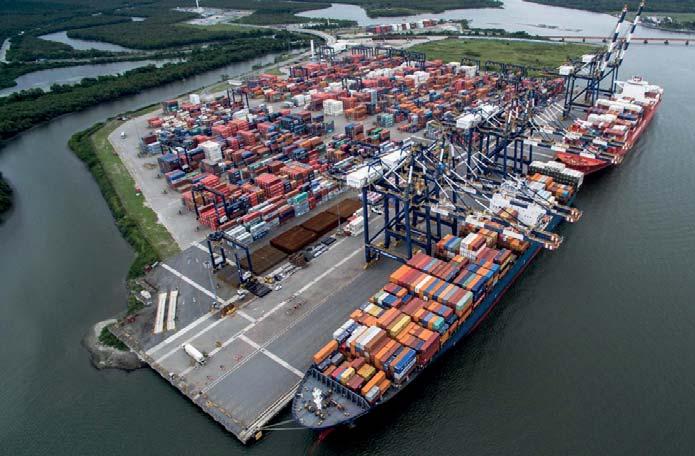
Bandeirantes, which acquired the logistics company Deicmar (once the leading automobile handler in Santos) 10 years ago, moved into the LCL business at about the same time and, says Flores, is providing a “key service in an important part of the logistics chain”, namely for the “smaller companies who cannot make use of full container loads, so are therefore ignored by the mega carriers and terminals”.
Last year Bandeirantes handled some 20,000TEU of merchandise, about 45 per cent of the overall Santos LCL market.
8 To scale up container capacity in one terminal unit or to diversify and offer a wider choice to potential customers – the new government appears to be moving away from the scale-up approach
A Cause Celebre for Bandeirantes – which specialises in customs clearance, separation and segmentation and delivery to customers as well as warehousing - was its handling of respirators for hospitals during the height of the Covid pandemic for which the company received many accolades from within the Santos port community and outside.
“The importers of the urgently needed respirators never had enough at any one time to fill a whole container so niche operators like ours could offer something that the bigger terminals could not,” says Flores. “We are very proud of the fact we handled 100 per cent of all the respirators in the ABC region [which includes the Sao Paulo cities of Santo Andre, Sao Bernardo and Sao Caetano] and Santos. It is situations like this that underline how important it is that there are many different companies of all sizes to serve all the needs of a major and complex port like Santos,” he contends.
Santos veterans like Flores and Araujo are firm believers that there is bread, and space, for port operators and logistics companies of all sizes, and they are hoping that Brasilia’s reconfiguration of the STS10 project will see those niche operators continue in the port for a long time to come.
SANTOS BRAZIL: PORT PLANNING For the latest news and analysis go to www.portstrategy.com JULY/AUGUST 2023 | 27
‘‘
… they are hoping that Brasilia’s re-configuration of the STS10 project will see those niche operators continue in the port for a long time to come















































































































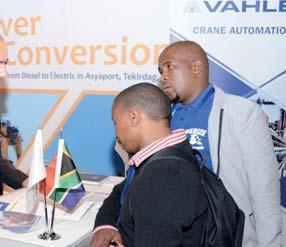


















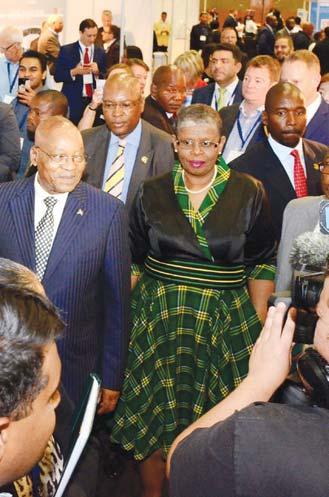




NEW FEATURES - NEW OPPORTUNITIES AFRICA’S MARKET PLACE FIRST CLASS AGENDA UNLIMITED NETWORKING 20 - 21 September 2023 Hilton Tangier Al Houara Resort & Spa, Morocco Events | Live & Digital Content | Networking Join the conversation online #TOCAfrica www.tocevents-africa.com
A NEW LEASE OF LIFE
The prospects for DP World Santos have improved with the potential demise of the “Superterminal” plan opening the way for new investment. Rob Ward reports
Apart from Ecoporto, the company likely to suffer the most if the STS10 project for a third major box terminal at the Saboo, “Superterminal” site in Santos – with around 600,000 sq m – had gone ahead would be DP World Santos.

With 1.067m TEU handled in 2022, DPW Santos is not exactly a David in the Santos panoply of terminals, but nor is it a Goliath; it is somewhere inbetween, maybe a ‘Daviath.’ It is outside the organised SPA area and operates as a Terminal de Uso Privativo (Or TUP) and so does not have to use the costly OGMO casual labour pool, but which it nevertheless chooses to use for part of its breakbulk operations at Suzano Terminal. That throughput gave DPW a 19 per cent share of the Santos market in 2022 but that’s less than half of its two rivals (BTP and Santos Brasil with 40 per cent each).
Despite being assiduous in carving out its own niche in terms of boxes – serving mostly the various carriers not aligned with MSC and Maersk – it would probably have ended up losing many of its services to the three bigger terminals (the current BTP and Santos Brasil, plus the future incumbents of STS10 in Saboo, on the right bank).
DIVERSIFICATION POSITIVES
However, by diversifying into handling other types of cargo – namely cellulose and paper for Suzano – and by working hard with its commercial activities the future looks bright for DPW Santos which took over 100 per cent from Embraport in 2017. When Embraport started up its construction phase in 2010 (and also when it opened its container operations in 2014), DPWorld had a 33 per cent share. It handled (as Embraport) 546,000 TEU in 2014, taking a 14 per cent share of the market during its second year of operations.
And now, with the likely demise of the STS10 project (see preceding article), and the prospect that it will be downsized, the future looks even brighter, and the chances of the non MSC and Maersk carriers – such as ONE, Hapag Lloyd and CMA CGM – staying with DPW Santos are positively glowing.
“DP World has done well to hold on to between 15 and 20 per cent of the Santos market while BTP and Santos Brasil dominate, but if a third “big” terminal came into play they might lose their main ‘Non-Big Two’ carriers – such as Hapag Lloyd, Cosco and ONE – and then they could really struggle,” says a well-known port consultant based in Sao Paulo.
“Therefore, they are one of the main beneficiaries of the current rethink on STS10 and the reason they are announcing investments and expansion plans is probably as a result of this good news, at least it is for them.”
DP World underlines how it is playing an important role in the “container mix” for Santos as it crashed through the 1m TEU barrier for the first time in 2023, and as it heads towards its 1.2mTEU capacity. It has announced it will add more capacity to the terminal; up to at least 1.4mTEU per annum.
Marcio Medina, Commercial Director, DPW Santos, says that another five per cent growth can be expected for this year, and he adds that the paper pulp handling totalled 3.7m tonnes in 2022 which was 15 per cent more than in 2021.
“Cargo diversification is a consolidated strategy at DP World and is the main approach to supply chain reconfiguration and here in Santos it started with the inauguration of the pulp complex in 2020,” explains Medina. “Today we operate the largest multipurpose terminal in the country, but still with container handling as our core business.”
The partnership with Suzano, opening operations in April 2020, has seen more than nine million tons of pulp shipped.
The complex received investments totalling Reais700m and has a warehouse of 35,000 sq m, and static capacity for more than 150,000 tons of raw material.
“Our investments aim to continue this cargo diversification strategy, in addition to increasing our container handling capacity, thus supporting the sustainable growth of Brazilian foreign trade,” adds Medina.
In terms of containers DP World will spend Reais200m in Santos to expand and modernise its terminal; adding 130,000 sq m to the existing 845,000 sq m facility and expanding the piers from 1100m to 1300m, which would be enough to accommodate the 366m boxships soon to be coming to ECSA.
For the latest news and analysis go to www.portstrategy.com JULY/AUGUST 2023 | 29
SANTOS:
8 DP World Santos is now looking to make new investments
DP WORLD TERMINAL DEVELOPMENT
Credit: Estúdio 58Imagens Aéreas
‘‘
Our investments aim to continue this cargo diversification strategy, in addition to increasing our container handling capacity
IN POLE POSITION
Polish ports are on the up, driving Baltic container volume overall. Conversely, the role of German ports in serving the Baltic is reducing, not least today due to the Russian situation. A J Keyes reports

Ports in Poland have traditionally been driven by a combination of strong Polish demand (including Hamburg transit activity) and transshipment into the wider Baltic region. While the former remains strong, the latter has suffered severely due to a loss of Russian cargoes direct to St Petersburg and transit into Russia via Baltic States and Finnish ports.
So, until the Russian situation stabilises or recovers, the Polish economy will remain the principal driver. This is not a negative scenario with the country generating a high level of GDP growth over the last 10 years, especially the 4.6 per cent average per annum between 2015 and 2019. Further, although the COVID-19 pandemic saw a drop of two per cent, there was a swift rebound of 6.8 per cent in 2021 with an average of 3.1 per cent then forecast by the IMF to 2028.
Traditionally, Hamburg used to be the most easterly port of call for deep-sea services with the Baltic ports beyond this point served via feeder and intra-regional services and not deep-sea calls. Today, however, Gdansk (and to some extent Gothenburg, Sweden) have changed this scenario, attracting main-line, deep-sea calls and functioning as high-capacity transshipment hubs. For the remaining ports, the majority are highly established, and with one or two notable exceptions, their future role will not change in terms of serving smaller feeder and short-sea container services as well as, in many cases, being adept at developing niche traffics – ro-ro, forest products, autos, project cargoes etc.
As Table 1 shows, the 2014 Baltic region total of 7.7m TEU increased to 8.1m TEU in 2022, after having peaked at 8.9m TEU in 2019. The subsequent slide in volume was due at first to supply chain issues as a result of the pandemic and then the collapse of Russian demand in 2022.
POLAND: THE PRINCIPAL DRIVER
Fundamentally, it is Poland’s ports which remain the driver of this regional development. Notably, Gdansk has seen annual increases between 2014-2022, with its total volumes rising from 1.2m TEU to almost 2.1m TEU over the period. Continued investment at Gdansk in deep water, larger cranes and longer berthing has attracted deep sea calls from Asia to serve both local Polish import-export markets and as a transshipment hub. Maersk Line remains the major liner customer of the port although the Ocean Alliance also calls now.
This level of growth can be compared with other ports in the region, also shown in Table 1, with no other individual port able to match this rate of continued growth. The only exception is Klaipeda in Lithuania, although its 11.1 per cent annual rise averaged over the period between 2014 and 2022, is largely generated by the very strong results in 2022
BALTIC: CONTAINERPORT OPERATIONS 30 | JULY/AUGUST 2023 For the latest news and analysis go to www.portstrategy.com
8 DCT Gdansk is blazing an expansionist trail
It is Poland’s ports which remain the driver of this regional development ‘‘
due to volumes from Mediterranean Shipping Co (MSC).
The weakness in the Russian economy coupled with the Russian trade embargo has resulted in a fall in total container throughput at St Petersburg/Ust Luga, which dropped substantially from over 2.2 million TEU in 2019 to 0.9 million TEU in 2022. Prior to ‘falling off a cliff in 2022,’ Russian port container volumes had exhibited positive year on year growth climbing
BALTIC: CONTAINERPORT OPERATIONS
up from 1.7mTEU in 2015 – with this growth underpinned by the strong market that existed for goods moving to Russia. Currently, however, these days are not expected to return until the Ukraine conflict is over and trade with the country resumes – which is an unknown length of time.
The Russian problem is, however, a widespread one with North Continent ports also seeing a sharp drop in containers feedered to/from the region, with this further underlining the scale of Russian-led disruption. As already noted, the trade sanctions impacting Russia are not expected to end any time soon, which means that ports like Hamburg, that have traditionally served Russia, will not see volumes returning and alternate markets will need to be targeted to make up for any loss of container traffic.
As well as experiencing negatively impacted container shipping volumes, Hamburg has also faced the added problem of seeing its share of overland containers to/from Poland undermined by the improved costs and efficiencies at Polish ports.
There is a clear correlation between Poland’s hub development and other Polish port efficiencies, as witnessed on a smaller scale in Gdynia, and the reduction of influence of German ports in Baltic hinterland activities.
GERMAN PORT PERFORMANCE
In 2014, total German port throughput was almost 15.6 million TEU, but at the end of 2022 it had fallen to just under 13.5
million TEU, impacted by a lack of demand for transhipping to Russia.
Hamburg saw a decrease in total volumes for 2022, dropping from 8.7 million TEU in 2021 to 8.3 million TEU. As well as the Russian situation, a series of workforce strikes and congestion during 2022 must also be regarded as factors negatively influencing the port’s throughput.
Wilhelmshaven volumes have fluctuated in recent years, linked primarily to Maersk Line’s use of the facility. Despite a very strong post COVID-19 rebound in 2021, the port continues to struggle to retain volume growth and regular services calling.
As a result of the volume fluctuations at Hamburg and Wilhelmshaven, volumes at the major ports in Germany, listed in Table 2, have decreased by an average of 1.8 per cent per annum between 2014 and 2022. Indeed, the total in 2022 of just under 13.5 million TEU represents a decline on the position in 2014 when the total for containers handled was almost 15.5 million TEU. Within this assessment range, there was also a decline in 2020 of just over one million TEU, from 14.8 million TEU (2019) to 13.8 million TEU (2020), due to the COVID-19 pandemic. While there was a rebound in 2021 to 14.4 million TEU, the impact of the economic sanctions on Russia was a major factor in the decline the following year in 2022.
It is clear that while ports in Poland, notably DCT Gdansk, continue to increase their importance in the Baltic market, Hamburg and German ports are less successful in container volume terms. and are continuing to struggle to maintain recent container throughput activity. This said, Hamburg remains an important economic hub promoting diverse added value activities in the container sector. 2022 also confirmed its ongoing ability to serve megamax container vessels – 18,000+TEU container vessels made 234 calls in Hamburg, six per cent more than the previous year.
8 Table 1: Total Port Volumes in Baltic Port Region 20142022, in ‘000 TEU
For the latest news and analysis go to www.portstrategy.com JULY/AUGUST 2023 | 31 Port201420152016201720182019202020212022CAGR Gdansk (Poland) 1,2121,0911,2991,5811,9492,0731,9242,1182,0726.9% Gdynia (Poland) 8496856427118048979059869140.9% Szczecin-Świnoujście Inner Terminal(Poland) 78 88 91 93 81 76 87 82 75-0.5% St Petersburg & Ust Luga (Russia) 2,3751,7151,7451,9212,1312,2222,1001,994919-11.2% Gothenburg (Sweden) 8298107956397507727768288850.8% Helsinki (Finland) 4014324504915105345094674922.6% HaminaKotka (Finland) 5755556316906536786215946291.1% Kaliningrad (Russia) 3251791892392763242814373972.5% Tallin (Estonia) 260208202215223223213227251-0.4% Riga (Latvia) 3883553854454694674534164612.2% Klaipeda (Lithuania) 4503924434727507036406671,04711.1% Regional total 7,7426,5106,8727,4978,5968,9698,5098,8168,1420.6% -15.9%5.6%9.1%14.7%4.3%-5.1%3.6%-7.6% Source: dataand.com Port201420152016201720182019202020212022CAGR Hamburg 9,7758,8488,9298,8608,7419,2828,5788,7008,300-2.0% Bremerhaven 5,7315,4675,5105,4585,4224,8504,7675,0054,518-2.9% Wilhelmshaven 6742748252065666542371366333.2% sub-total 15,57314,74214,92114,83814,81914,79713,76814,41813,481-1.8% -5.3%1.2%-0.6%-0.1%-0.2%-7.0%4.7%-6.5%
Source: dataand.com
8 Table 2: Total volumes at German ports , 2014-2022 by ‘000 TEU
CRANKING UP CAPACITY
Poland’s ports are looking to consolidate their current strong position. Will this continue the steady erosion of the role of German ports serving the Baltic? AJ Keyes looks at the shape of things to come
The emergence of DCT Gdansk (or the ‘Baltic Hub’ as it is now known) in Poland has challenged existing port infrastructure, especially the traditional role of serving the Baltic region via transshipment through German ports. Add to this trend the economic sanctions impacting Russian ports, and there is certainly now a “new normal” in place for the Baltic region. This raises a simple question – will the trend continue or will the German ports, notably Hamburg, be able to reclaim lost ground?
Economic growth in 2021 and 2022 for Poland shows the resilience to market fluctuations in the face of the COVID-19 pandemic, while the impact of the Ukraine conflict via the reduction of transshipment cargoes and feeder services to Russia/Kaliningrad, has not halted port throughput growth. Polish gateway volumes have continued to grow, supported by high numbers of Ukrainian refugees increasing the local population and thus lifting consumer demand.
The key question is why are Poland’s ports proving successful and Hamburg, for example, is slipping?
INVESTMENT AND VERSATILITY
Investment in infrastructure to be able to support ship size growth is an important factor, as is the ability to diversify to build on market strengths. As Table 1 shows, ports in Poland have continued to expand the quality of infrastructure and facilities.
ICTSI’s Baltic Container Terminal (BCT) highlights the versatile approach required to adapt to new market circumstances and to maintain a positive position to its benefit and the port of Gdynia as a whole. BCT offers 800m of quay and a total capacity of 1.2 million TEU per annum, serving a mix of feeder, short-sea and deep-sea customers. In the latter context, MSC recently announced a new call to be introduced on its Far East ‘SWAN’ service.
Operating at the port since 2003, with investment at the facility running well in excess of US$100 million, ICTSI has recently renewed its tenure at the terminal to run until 2053. However, this is more than just a facility for container activity, with the terminal successfully diversifying its service portfolio in two other key areas.
First is the handling of special cargoes such as advanced military equipment. “BCT has considerable expertise in this area,” emphasises Wojciech Szymulewicz, Chief Executive Officer, “meeting stringent security requirements, and as such enjoys the trust of the Polish army and Poland’s NATO allies.”
Then there is the handling of wind turbine components destined for use in onshore wind farms. It further expects to deploy this expertise in conjunction with offshore wind farms, which are planned for development over the short to medium term, although with Gdansk recently nominated by the government as the major installation port for this activity BCT anticipates it will probably not deal with the major components such as towers, nacells and blades but will instead be active with other components such as transition pieces, secondary steel and cables.
The Baltic Sea has enormous potential for offshore wind, with the current 2.8 GW of installed capacity expected to be 19.6 GW by 2030 following a commitment from eight countries that border the region. Here, Poland will play a crucial role as
it is targeting capacity of 6 GW by 2030 and 11 GW by 2040.
The continued expansion into these other cargo areas complements the terminal’s container activities, which extend along the increasingly important trans-European Baltic-Adriatic Corridor (Corridor VI). This route runs from Gdynia via southern Poland (Upper Silesia), Vienna and Bratislava and the Eastern Alpine region right through to Northern Italy, serving diverse industrialised centres enroute. With around 250 intermodal trains running per month, the facility is already seeing rail account for approximately 30 per cent of annual throughput.
ICTSI is not the only global operator in the Polish market, with Hutchison Ports operating Gdynia Container Terminal (GCT), although more limited water depth and infrastructure has seen its major customer, CMA CGM, switch to DCT Gdansk (Baltic Hub). There have been other recent liner moves – the CMA-CGM subsidiary Containerships has also moved from Gdynia (BCT) to the Baltic Hub plus two smaller operators, Viasea and Ellerman have shifted from BCT to GCT. All indicators that the competitive climate overall is hotting up.
For its part, BCT is clearly aiming to maintain a positive presence in deep-sea trades – in addition to MSC’s Far East Swan Loop, referenced above, it now handles direct MSC services to the US East Coast and to India/Pakistan, and it has in the pipeline for this autumn the commencement of port authority backed plans to deepen its berthing line from 12.7m to 15.5m. The programme will run for two years with BCT being provided with alternative berths throughout this time.
This autumn will also see BCT get better rail access as a result of the upgrade of shunting facilities and electrification.
NO LACK OF DEEPSEA PORT INFRASTRUCTURE
In terms of deepsea shipping, DCT Gdansk has two largescale terminals and deep water, able to handle the largest container vessels in service. Strong continuing demand means Terminal 3 is already under development and will take total container capacity to 4.5 million TEU per annum during the current decade.
Clearly, there is no lack of port infrastructure in Poland, with deep-sea, feeder, project cargoes and ro-ro all amongst the varied activities taking place.
8 BCT can accommodate full size intermodal trains with rail now accounting for around 30 per cent of the terminal’s throughput
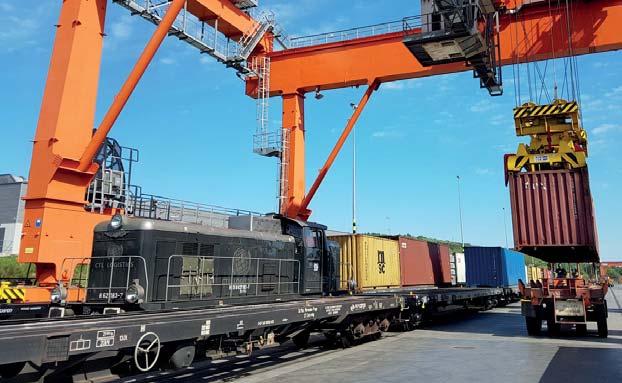
BALTIC: CONTAINERPORT
32 | JULY/AUGUST 2023 For the latest news and analysis go to www.portstrategy.com
DEVELOPMENT
Hamburg’s two container terminal operators have also continued to invest and further expansion at the port is expected. Yet, as Table 2 identifies, this is not enough to stem the tide of change regarding its role as a hub port serving the Baltic. The port is continuing to see its transshipment volumes diminish, with this activity falling by an average of three per cent per annum since 2014 when it handled more than 3.7 million TEU. The figure for 2022 was 2.9 million TEU. Bremerhaven saw a similar fall in transshipment activity in 2022, down from 2.9 million TEU to 2.7 million TEU.
For the same period DCT Gdansk recorded growth of five per cent per annum, reflecting a continuing shift in emphasis away from Germany to Poland.
Ensuring sufficient depth of water in the River Elbe to satisfy the continued increase in container ship sizes has been the biggest challenge to Hamburg’s role as a major hub port of call for container shipping lines. So far, however, it has managed to do this with, as noted in the previous article, the volume of megamax vessel calls increasing year on year. This is fundamental to Hamburg maintaining its long established position as the main European port of call for Asian cargo and staying in the premier league of transshipment operations. Draught, though is not the whole story, when it comes to maintainIing competitiveness.
Location can also not be ignored because Hamburg’s cargo terminals are 100km from the mouth of the North Sea and this is a distance that both the deep-sea vessels and the feeder ships need to sail, there and back, before any onward
sailing occurs. By comparison, the likes of DCT Gdansk and Świnoujście represent no deviation from shipping routes, minimising shipping line costs.
The cargo shift away from Hamburg for transshipment containers is clear to see, but there is also the possibility of hinterlands in eastern Germany and Southwest Poland also deserting Hamburg to Poland as well.
The planned Świnoujście Container Terminal project, located to the east of the outer port in Świnoujście, if built, will offer a water depth of 17m and supporting container handling infrastructure of one million TEU per annum initially, with the potential to increase in phase two to around two million TEU per annum. The port has direct accessible truck markets in Northeast Poland and Northwest Germany (including Berlin), while it is very well-located geographically to Slovakia, the Czech Republic, Austria, and Hungary. This means transport cost structures for serving these markets appear highly favourable over Hamburg.
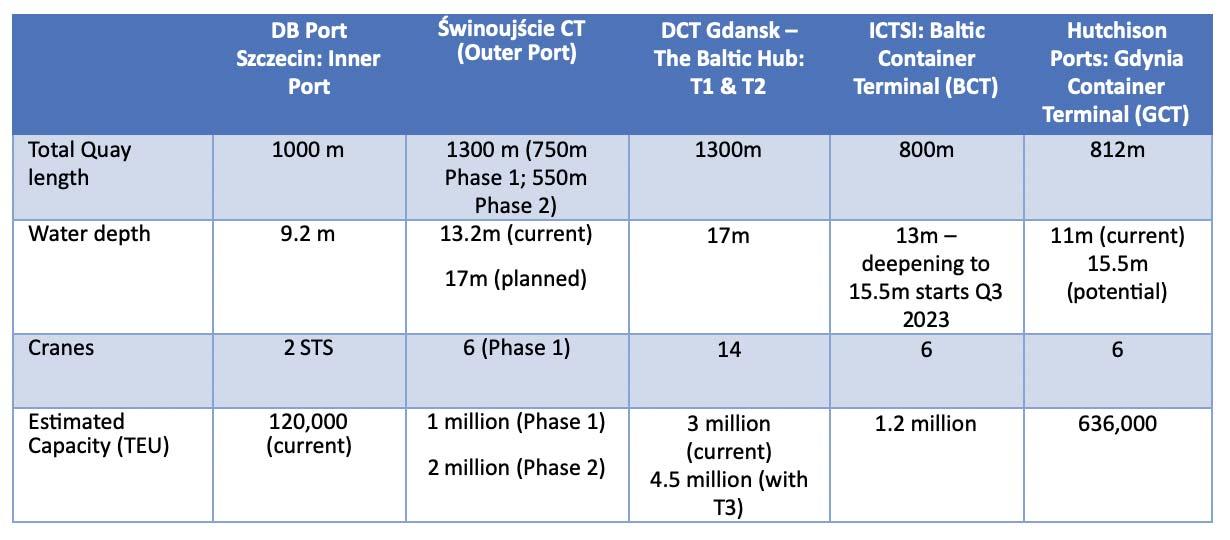
Against these factors though there are negatives: a big dredging requirement; high costs, is the project really needed in overall capacity terms, why not just go for a smaller facility and transship? The project has its critics…
THE SQUEEZE IS ON
The squeeze on Hamburg’s volumes from Poland will likely continue if the forthcoming development of Świnoujście gains further traction (although there is no certainty regarding this as yet). This is in addition to DCT Gdansk bringing its Terminal 3 to fruition and offering more deepsea container capacity.
Yet, some parties contend it could be even more competitive for the German ports if the Polish government could streamline port authority management to deliver a more effective strategic approach. There is also the issue of introducing an effective National Port Masterplan.
For the latest news and analysis go to www.portstrategy.com JULY/AUGUST 2023 | 33
8 Table 1: Port Infrastructure in Poland’s Major Container Ports, Q2 2023
BALTIC: CONTAINERPORT DEVELOPMENT
‘‘
Poland: The issue remains of introducing an effective National Port Masterplan
8 Table 2: Transshipment at Major German Ports 2014 – 2022, in ‘000 TEU
BIDDING FOR THE BIG TIME
The Port of Klaipeda has plans to develop a new largescale terminal before the end of decade. AJ
Keyes
assesses the viability of the project
The Port of Klaipeda is one of the more northerly ice-free ports in the Eastern part of the Baltic Sea – it primarily serves industrial regions to the east of Lithuania. Despite the loss of cargo opportunities to Russia, Klaipeda saw record growth in container handling, with an increase of 57 per cent in 2022 compared to 2021.
This strong growth was due to additional activity from Mediterranean Shipping Co (MSC), which also chose to utilise the port for some transshipment cargo, even returning the containers back to the Polish market, especially for US trades. Access to other markets, including Pakistan and Ecuador, were also confirmed by the Port Authority as contributing to recent demand.
Yet is this sufficient to commit to a major new large-scale terminal development project?
Well, the port can claim several important competitive factors supporting future demand. Despite its location it guarantees uninterrupted shipping and cargo operations, unlike Russian ports like St. Petersburg (before the current economic sanctions on the country decimated its cargo activity).
Klaipeda’s South Port Project envisages a new high throughput container terminal
The port is served by two railway stations and highways which together link Klaipėda to Kaunas, Vilnius, and cities in the nearby countries, such as Minsk, Kyiv, and Moscow. However, the ongoing conflict in Ukraine, instigated by Russia, continues to curtail cargo flowing to and from many of these locations.
There are two existing terminals where containers are handled, although the limited berth depths of 11m restricts the size of ships that can call. The depth issue has, however, been partially rectified because the port waters and entrance channel dredging project that began at the port in 2020 has been completed, with 15.5m now the depth of the Port of Klaipėda ship channel.
FURTHER DREDGING
According to the Klaipėda State Seaport Authority strategic plan, further dredging of the port waters to a depth of 17m is planned for 2026, which links with the South Port project so that transshipment and import-export containers can be targeted, while also supporting the offshore wind industry.
The project will see between 70ha and 100ha at the Southern part of the port developed, with the initiative ultimately providing a continuous quay that stretches 1300m, and an entrance channel of 200m in length and 600m wide.
So far, the infrastructure seems to be ticking all the necessary boxes. There is also a confirmed timeline for the project, at least to 2028 according to the Port of Klaipeda, which highlights that the very earliest that any cargo movements could commence is from 2029 onwards.
Table 1 outlines the various activities to be undertaken and when each is currently slated to occur. An in-depth market study will be crucial in outlining the projected demand to
support the planned facility. Assuming this process generates a positive range of cargo forecasts that can support the planned capacity of the facility and ensure a sufficient rate of return for investors, then construction could occur between 2026 and 2028. Again, this is assuming all technical documents are finalised and all required permits are in place.
Based on these projected timescales, the earliest estimated start for operations will be 2029. So, will there be sufficient container volumes to warrant this project?
The Klaipeda South port is clearly a largescale project that will add additional container space and deeper water for larger ships. It is clearly an ambitious plan, with the need for an additional facility adding in excess of one million TEU per annum extra capacity, somewhat questionable.

Container activity at the port in 2023 and over the shortterm thereafter will ultimately dictate whether this extra space is needed for containers. Since 2014, container volumes have increased by 11.1 per cent per annum to the end of 2022, but this is due to MSC helping the 2021 total of 667,000 TEU jump to 1.05 million in 2022.
This level of growth will need to be maintained for the planned new facility to be commercially and economically viable. Clearly, the limited local Lithuanian cargo base will be insufficient to fill this capacity by itself, with this further underlining the necessity of establishing a regional transit and transshipment role.
BALTIC: KLAIPEDA PORT DEVELOPMENT 34 | JULY/AUGUST 2023 For the latest news and analysis go to www.portstrategy.com
8 Table 1: Klaipeda South Expansion Plan Timescales
Source: Dates and activities from information outlined by Klaipėda State Seaport Authority
8 Klaipeda is looking to add a new one million TEU per annum container terminal by 2029 – but is there sufficient demand to support the project?
‘‘
BIG AMBITIONS BUT CHALLENGES
Russia’s ‘great turn to the East’ has seen a new emphasis on the exploitation of the Northeast passage but as Oleksandr Gavrylyuk explains big challenges remain
On 24 June 2023, Sevmorput, Russia’s only nuclear-powered lighter/container carrier, left the country’s Baltic port of St Petersburg to round the Scandinavian Peninsula and start its first voyage along the Northeast Passage this year.
Aimed to deliver numerous cargoes (containers, metalwork, lumber, cranes and motor vehicles) from north-western Russia to its remote Far Eastern regions, the vessel was scheduled to arrive at the harbour of Vostochny (near Vladivostok), on the Russian coast of the Sea of Japan, 22 days on from its departure date. From here, the ship will proceed to call at the port of Petropavlovsk-Kamchatsky on the nation’s easternmost Kamchatka Peninsula, from where it will go back to Murmansk in the European part of the Russian Arctic, according to Vyacheslav Ruksha, Deputy Director General of the state-run nuclear energy corporation RosAtom.
The sole developer of the Arctic’s infrastructure since 2018, RosAtom, initiated Sevmorput’s regular shipping service last year. In 2022, the ship made two round trips with just four ports of call and the load factor varying from 10 to 90 percent. This year, it is planned to make three such voyages and call at 11 harbours (including major ones, such as Arkhangelsk, Nakhodka and Magadan) along the way.
Extraction of the Arctic minerals has been a major goal for Moscow for decades, gradually transforming it into one of the globe’s leading hydrocarbon producers and exporters. As a result, the use of the 5600 km-long Northern Sea Route (NSR), Russia’s segment of the Northeast Passage) has always been of paramount importance for the country.
DEVELOPMENT CATALYST
Since the Kremlin’s full-scale invasion of Ukraine last year, the NSR’s significance has grown even more. The West’s economic sanctions have made Russia shift its main trade focus onto the Asian-Pacific region (and above all China).
In August last year, it adopted a comprehensive programme for the NSR development by 2035 comprising over 150 various activities. The development strategy calls for a continual expansion of the annual traffic along the NSR from 34m tonnes in 2022 to 80m tonnes in 2024, 150m tonnes in 2030 and 220m tonnes in 2035. The number of voyages along the NSR is expected to grow to 1747 in 2024, 3381 in 2030 and 3895 in 2035.
The route’s overall infrastructure remains either underdeveloped or obsolete. Russia’s Arctic coast lacks handling facilities, especially container terminals, while railway and road approaches to the available ones are limited.
To improve the situation, the Hydrographic Enterprise (HE), RosAtom’s subsidiary) is going to carry out five harbour development projects in the Arctic zone from 2023 to 2026. RUB12.77 billion, of the projected RUB34.8 billion cost, is intended to be sourced from the so-called “extra-budgetary” sources, according to Aleksandr Bengert, Director General, HE.
Built in 1988, Sevmorput is able to single-handedly navigate ice up to one meter thick at an average speed of two knots. When following an icebreaker, the vessel can pass through even thicker ice fields.
However, with an increasing number of scientific reports predicting the ice-free Arctic in less than a decade, Moscow is looking forward to its long-standing dream of year-round navigation in the region finally coming true.
With Russia’s Arctic stretching for more than 24,150km of its littoral, the country is responsible for over 53 per cent of the Arctic Ocean’s entire coastline and 80 percent of its oil and gas reserves. The Russian Arctic zone accounts for 10 per cent of the world’s oil and 25 percent of its gas resources. It contains 95 percent of Russia’s reserves of platinum group metals, 74 percent of nickel, 55 percent of cobalt, 67 percent of apatite ores, 61 percent of rare metals and 14 percent of bauxites, as cited by the nation’s Ministry for Natural Resources.
The Kremlin’s “Great Turn” to the East has been shaping a new transport and logistics reality. For instance, with 33 vessels under construction, the Russian Arctic zone will need 97 more cargo ships by 2030, in the opinion of Vyacheslav Ruksha. To guarantee their passage through the ice fields, RosAtom is about to expand its icebreaking fleet from 10 (seven nuclearand three diesel-propelled) icebreakers operating along the NSR to 15 (nine nuclear- and five diesel powered) by 2030. To raise the funds for building at least two nuclear-powered ships, the corporation has signed a cooperation agreement with the state-controlled VTB bank.
Another major challenge is finding cargoes for the round trips along the NSR. For example, when Sevmorput left St Petersburg tin June this year, the loading factor reached 95 per cent of its carrying capacity. However, providing goods for the return voyage has remained a tall order. While the Russian authorities want their Asian partners to help solve the problem, there are still little signs of interest from Beijing or New Delhi.

RUSSIA’S ARCTIC ROUTE For the latest news and analysis go to www.portstrategy.com JULY/AUGUST 2023 | 35
8 The Sevmorput, Russia’s only nuclear-powered lighter/container carrier – the ‘front line’ in Russia’s bid to achieve much greater use of the Northeast Passage
…providing goods for the return voyage has remained a tall order….there are still little signs of interest from Beijing or New Delhi
‘‘
MAXIMISING VALUE
Brad Saunders, Senior Principal Engineer & Technical Lead for APAC, Coastal & Maritime Engineering, BMT, sets out how for small ports a modern approach to asset valuation is appropriate and holds considerable potential to uncover hidden value
8 Small ports adopting a modern approach to asset valuation can deliver multiple benefits
Smaller ports, despite their size, possess immense potential as crucial nodes in global trade and transportation networks. However, accurately assessing the value of their assets can be a daunting task, requiring specialised knowledge and insights. It can also be a job that in a small port environment is carried out in a routine or traditional way that does not properly unlock an up-to-date asset valuation. This is where maritime consultancy firms come into play, offering their expertise in asset valuation to empower smaller ports and optimise their operations.
By leveraging the skills and experience of maritime consultants, these ports can uncover hidden value and pave the way for sustainable growth. Within this scenario, there is also the important aspect that where asset replacement is concerned – for example harbour tugs and pilot boats –ports can ensure the charges levied against their use are adequate to facilitate timely replacement.
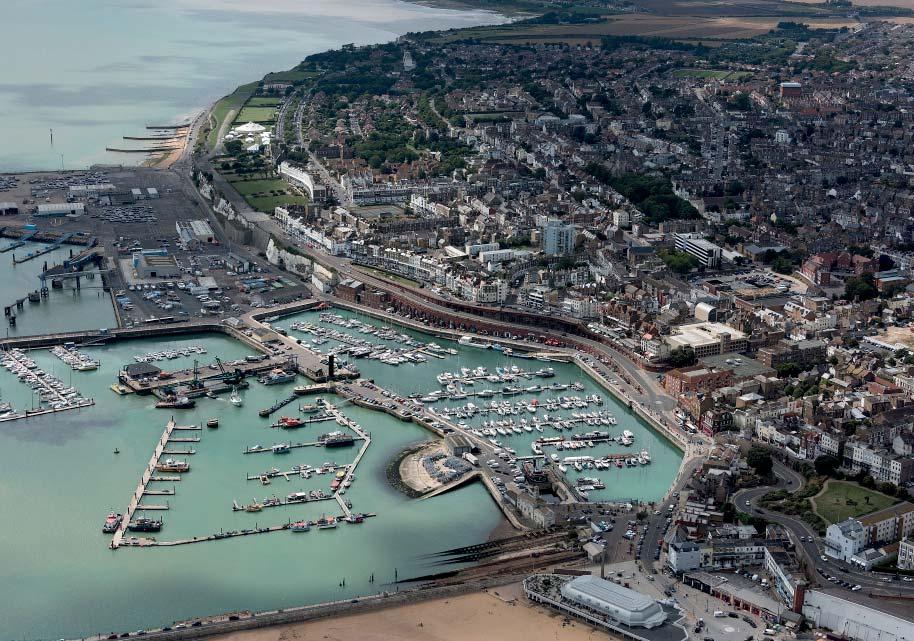
To a great extent, the ‘old rules’ governing small port asset valuation are no longer comprehensive enough. Smaller port valuations and investment has been progressively shaken up by revolutions in energy, mobility, and digitisation over the
About BMT* BMT is a leading international design, engineering, science, and risk management consultancy, driven by a commitment to excellence and sustainability. With over 1,300 professionals worldwide, we empower our customers to make informed decisions, delivering high-quality, high-value services for the maritime industry.
past decade. These revolutions are introducing new dynamics across the breadth of existing port infrastructure investments that previously appeared almost impervious to change. At the same time, economic and social transformations are introducing new types of investments that represent opportunity and efficiency for operators.
As a result, operators of smaller ports need to change with these ‘new dynamics’ in order for them to stay relevant, progress and ultimately survive. Drawing on specialist advice and technical expertise from Port and Maritime Infrastructure consultants BMT, the following elaborates how small ports can stay ahead of the curve and be able to sustain their roles as important supply chain partners, in addition to diversifying themselves to become strategic economic development actors in the highly contested waters’ space.
To manage the ‘new dynamics’ introduced by the energy transition and other structural changes, operators need to move beyond the historical valuations approach that focused almost exclusively on relatively static technical assessments and financial models. Today, other factors need to be layered on for a full-picture understanding. This is partly due to the turbulence and turmoil linked to significant inflation, increases in interest rates, declining equity markets, and a looming threat of recession which comes on the heels of the deep disruptions caused by the COVID-19 pandemic. To a great extent, these structural shifts in the economic environment are becoming more and more uneven and harder to recover from
ASSET VALUATION: SMALL PORTS 36 | JULY/AUGUST 2023 For the latest news and analysis go to www.portstrategy.com
SIGNIFICANCE OF ASSET VALUATION
Asset valuation serves as a vital tool for understanding the worth and potential of a port’s infrastructure, facilities, and surrounding resources. This process goes beyond financial figures and models for smaller ports, encompassing various factors that influence the port’s overall value.
5 Infrastructure Assessment: Maritime consultants meticulously evaluate the port’s physical assets, including docks, terminals, warehouses, and equipment. They identify areas for improvement, optimising efficiency and capacity utilisation to enhance overall performance.
5 Geographical Advantage: The location of a port greatly impacts its potential. Consultants analyse the port’s geographical position, proximity to transportation networks, and accessibility to key markets. This assessment helps identify opportunities for expansion and improved connectivity.
5 Economic Evaluation: Understanding the economic viability of a smaller port is essential for long-term success. Consultants delve into cargo volume, revenue streams, and market dynamics, providing valuable insights into potential growth areas, niche markets, and diversification opportunities.
5 Regulatory Compliance and Sustainability: Today, adherence to regulatory requirements and sustainable practices is a crucial aspect of asset valuation. Maritime consultancy firms assess a port’s compliance with regulations, environmental standards, and social responsibilities. This evaluation ensures that the port maintains a positive reputation and attracts environmentally conscious partners and investors.
LEVERAGING CONSULTANCY EXPERTISE
Maritime consultancy firms specialising in asset valuation bring a wealth of knowledge and experience to the table, allowing smaller ports to unlock their true potential in today’s world. By leveraging their expertise, these firms offer several key benefits:
5 In-Depth Analysis: Maritime consultants conduct comprehensive assessments, considering both quantitative and qualitative factors. They provide a holistic view of the
ASSET VALUATION: SMALL PORTS
port’s assets, enabling port authorities and stakeholders to make informed decisions based on accurate and reliable data.
5 Strategic Planning: Armed with detailed asset valuations, consultants work closely with port authorities to develop strategic plans. These plans focus on optimising existing infrastructure, identifying investment opportunities, and creating a sustainable growth and development roadmap.
5 Industry Insights: Maritime consultancy firms possess a deep understanding of the maritime industry’s complexities, trends, and emerging technologies. Their expertise enables smaller ports to stay ahead of the curve, adapt to evolving market conditions, and capitalise on new opportunities.
5 Stakeholder Collaboration: Maritime consultants facilitate collaboration among port authorities, shipping companies, government agencies, and local communities. By fostering partnerships, they help create a supportive ecosystem that drives the port’s growth and benefits all stakeholders involved.
To conclude. asset valuation is a crucial step in unlocking the potential of smaller ports. These ports can leverage expert knowledge and insights by engaging maritime consultancy firms to accurately assess their assets’ value. Through comprehensive evaluations, strategic planning, and collaboration with stakeholders, smaller ports can maximise their potential, attract investor interest and investments (for instance, via public funding agencies such as World Bank and ADP), and become vital contributors to regional and global trade.
By paying heed to the guidance of maritime consultants, these ports can often benefit by achieving higher valuations and securing public/private investor interest facilitated by a strong focus on enhancing their competitiveness, sustainability, climate change resilience, supply chain resilience, digitisation (operational efficiency) and decarbonisation efforts. Ultimately, this will enable them to efficiently plan ahead and to support their growing passenger/cargo volumes. Port managers can also navigate more confidently and freely amongst a vast proliferation of invisible and hybrid mix of opaque/transparent sea threats, seize opportunities, and chart a course toward long-term success and sustainability.
8 Structural changes in the trading environment for small ports present new opportunities

For the latest news and analysis go to www.portstrategy.com JULY/AUGUST 2023 | 37
DATA DRIVES DEVELOPMENT
8 RTE has launched the second generation of its Wireless Reefer Acquisition Device: WRAD II

AUTOMATED REEFER MONITORING ORDER OF THE DAY
As automated reefer monitoring systems rapidly take over from manual inspections within container terminals, the technology is moving away from purely monitoring temperatures and including a greater emphasis on analysing data. This can be seen by an increased interest in using such systems for energy monitoring, allowing operators to use the data to reduce reefer energy usage. Julian Galvis, Identec Solutions VP Sales Marine & Ports, says: “That’s the future of our solution - it goes beyond the monitoring of temperature and humidity; we are past that as an industry. It is now more about the administration of the whole reefer process.”
A major trend has been to integrate reefer monitoring systems with other port platforms. This too has allowed
data to be used more effectively. Donald A. Vinson, President and CEO, RTE notes: “Over the years, terminal operators have become much more sophisticated using technology and data. By comparison, reefer monitoring was typically a stand-alone system in the past. Today it is uncommon to find RTE systems not integrated with other platforms, especially Terminal Operating Systems (TOS). The data collected by our reefer monitoring system is integrated with other data to allow the user to make operational decisions. As a result, our GRASP system(s) have continued to add new features and integration methods.” As reefer containers continue to increase in terminals, the investment in automated reefer monitoring solutions will continue to grow.
DATA ANALYSIS: DESIGN INNOVATION, ENERGY MONITORING ...
8 Automated Reefer Management Systems (ARMS): ARMS has developed a system for automated power and reefer connections. It has identified the operational area management of the storage of reefers as needing improvement in terms of safety and operability. It points out that port personnel are still contributing to the area’s management both directly and manually.
To solve these issues, ARMS has developed its ARMS plug, with the support of industry partners Identec Solutions, SCAME SPA, Crouzet SA and Nuova Icom. Used in the terminal or onboard ship, the solution automates the connection of refrigerated containers, and remotely
manages electrical and data connections, continuously checking the status of reefers and detecting their electric consumption. Its mechatronic arms ARMS 1-2-1 and 1-2-n, currently in the industrialisation phase, allow the operating system of the terminal or ship, with which it interfaces, to remotely manage the connection and disconnection of electrical power and data lines on refrigerated containers. Its operating system also maintains a complete monitoring of the operating parameters and the state of reefer boxes using the integrated ReeferRunner system produced by its partner Identec Solutions.
REEFER MONITORING 38 | JULY/AUGUST 2023 For the latest news and analysis go to www.portstrategy.com
8 Copeland: Copeland’s REFCON 6 is an automated terminal solution that covers the entire container terminal. Two-way communications between an operator and every reefer container can take place 24/7, and all data is securely logged for event history and documentation purposes. Data from local REFCON 6 systems is consolidated and stored by connectivity, software and service management programme ProAct Transport. Centralisation of data on a secure web server makes it possible for container terminals to establish automated remote management of all reefer containers, covering their entire stay at the terminal. Augmenting the REFCON 6 software, REFCON 6 portable modems and REFCON wireless hubs provide monitoring solutions for refrigerated containers at various sites, offering complete coverage. The REFCON portable modem can be
8 Identec Solutions: Identec Solutions’ Reefer Runner is continuing to develop and expand in both its usage and capabilities. There are now almost 60 deployments of Reefer Runner worldwide, including eight of the world’s Top 10 global container operators. The remote monitoring and control system gives terminal operators real time visibility of every reefer container through its robust wireless technology. Once connected, all monitoring data and energy consumption is visible. It integrates directly with available TOS systems. Julian Galvis, VP Sales Marine & Ports, Identec Solutions, notes: “In addition to seeing more and more customers taking advantage of our system for invoicing and billing, they are using our system’s data to determine how much energy and costs associated with energy are being consumed. They can use that information to determine whether or not their tariffs are aligned with what the actual consumption is, and it gives them the option to switch to dynamic pricing rather than flat rates.” He says that this represents a “game-changer” for Reefer Runner’s customers. Reefer Runner teamed up for a trial with ABB in the Mediterranean in 2021, which allowed informed decisions to be made about reducing energy being used. For example, based on the information provided by Reefer Runner, peak shaving was able to be carried out during peak times for reefer energy usage, which allowed peak
8 Lumel: Poland-headquartered Lumel developed its reefer monitoring system following a request from a customer responsible for reefers at a container terminal. The problems to be addressed included a lack of supervision over the parameters of container power supply, lack of information about power supply interruptions as well as lack of possibility to provide the goods receiver with documentation relating to continuous power supply to the container. Therefore Lumel, which manufactures industrial automation devices, developed a mobile measuring case for the container which is made of materials ensuring water and
Refrigerated Transport Electronics (RTE): RTE has been in the reefer monitoring business for nearly four decades. It says that it introduced the first commercially available remote reefer monitoring solution in 1985 and the industry’s first wireless reefer monitoring system in 2011. Today, the company offers several monitoring solutions for vessels and terminals, including RF communications and reefer energy analysis. A driver for the development of RTE’s products is customer feedback and the company’s engineering team reportedly strives to develop unique solutions that “prioritise simplicity and functionality, tailoring them to meet the changing demands of our clients”. RTE’s latest product, the WRAD II wireless
directly plugged into the log retrieval port or connected using an extension cable, depending on the specific application. Once connected, all data is transmitted wirelessly to REFCON, where terminal staff can oversee data and alarms. Steven ter Beek, Sales Director, Copeland Europe, singles out data security as a major priority. The REFCON portable modem solution uses Bluetooth Low Energy (BLE) 5 as its wireless interface. “With its high-security standards, the use of this interface helps to protect data security,” he says. The REFCON portable modem is also equipped with built-in security keys for additional protection against external threats. By using BLE as the communication protocol, the REFCON Portable Modem eliminates the need for recharging and replacement at the end of the battery’s life.
demand to be cut by 20 per cent and peak consumption by 25 per cent. Identec Solutions hopes to launch Reefer Runner Pro next year, which will include not only management and administration processes, but will help customers invoice for value added services such as repair and maintenance. “There will be more reliance on our system for not just for monitoring but for day-to-day management,” underlines Julian Galvis. Elsewhere, Reefer Runner is expanding its offerings by moving to a 5G option for small terminals that want a subscription, cloud-based solution.
Recent up-take: Indentec Solutions is in the process of taking Reefer Runner live at the Terminal Investment Limited (TIL) terminal at the Port of Santos, Brazil’s largest container terminal facility, representing its first installation in the country. Reefer Runner became operational in December 2021 at Puerto Bolivar, Ecuador, as part of Yilport’s initiative to boost productivity. Last year Reefer Runner was installed for 770 reefer points at OPCSA in the port of Las Palmas, Gran Canaria, providing staff with more time for value-added services.
dust protection as well as low weight. It deploys a measuring circuit consisting of a power network analyser, current transformers and necessary protection devices. Built-in Wi-Fi and/or GSM modules guarantee wireless communication, providing remote access to the current and archived measurement results 24/7. Benefits include full control over the parameters of the container power supply; at any time, the administrator can connect to devices via Wi-Fi or GSM networks and an immediate text message is generated in case of any problems with the container power supply.
reefer monitoring device, is the second generation of its Wireless Reefer Acquisition Device. Equipped with Bluetooth wireless technology, RTE says it provides “fast and reliable low-energy connectivity crucial in a port environment”. The company has also included NFC capability to ensure efficient installation, setup, and diagnostic interaction for on-site personnel. RTE says: “Our goal is to get data to the user using various methods. An example is our added product features that provide empirical data and visually aided feedback to ascertain changing reefer conditions.” RTE’s site-based reefer monitoring solutions are currently used in over 80 terminals worldwide.
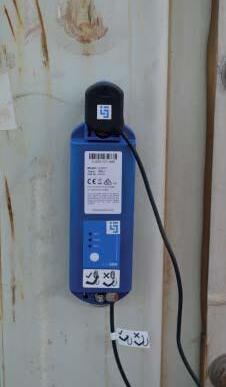
REEFER MONITORING For the latest news and analysis go to www.portstrategy.com JULY/AUGUST 2023 | 39
8 All reefer monitoring data and energy consumption is visible through Identec Solutions’ Reefer Runner
ELECTRIC AND GREEN GOALS
8 The RAM SingFlex tandem system allows crane operators to change between spreaders in less than two minutes without manual intervention
SECTOR ANALYSIS: ENERGY EFFICIENCY AND PRODUCTIVITY

Increasing energy efficiency and being more environmentally friendly are key drivers behind recent developments in the telescopic spreader market. Pieter Verdonschot, Product Manager, VDL Container Systems, highlights: We see ports looking for more energy efficiency as well as more environmentally friendly solutions. This results in more purchases of electric spreaders and hybrid spreaders but also in replacement of old equipment which is not fulfilling the latest standards when it comes to energy efficiency”. The use of electric and hybrid spreaders also helps meet the aim of boosting terminal productivity, with less downtime
and maintenance required. Other innovations, identified in the company reviews below, including the reduction of spreader weight and increased telescoping and twin separating speeds, also aim to increase productivity. Meanwhile, the trend to use tandem spreaders has gained momentum due to the iof 40ft containers. RAM Spreaders notes: “The transition from single to twin and now twin to tandem is taking off.” With many major terminals having ordered or planning to order such systems, RAM says this is a “clear indication that tandem lift will soon become the new norm in container handling.”
DATA ANALYSIS: ELECTRIFICATION, NEW MODELS AND DESIGNS
8 Barlow Technology/Inamer: DP World Southampton has started trialling Flexi-Flippers on its STS cranes – with initial reports said to be very encouraging. Barlow Technology, which supplied the Inamer-manufactured product, predicts that the “success of the problem-solving solution will pave the way for a time-saving, cost-efficient, high performance product for the UK’s ports industry”. The product is already in use in a number of terminals throughout Europe. Barlow
8 Bromma: Bromma has launched an all-electric ship to shore (STS) spreader, which aims to assist terminal operators reach environmental goals as well as boost productivity, efficiency and flexibility. The company says that its STS45E G2 PLUS all-electric spreader, released in 2022, is the fastest on the
Technology says that by replacing traditional spreader flipper arms on cranes, the Flexi-Flipper can be easily adapted to achieve the correct combination of rigidity and cushioning. Advantages include reducing the number of fins that need to be repaired annually, while the structure of the spreader is preserved with the flexi-flipper’s adaptability to varying load requirements, saving on lost hours and down-time, while also being safer for crane operators.
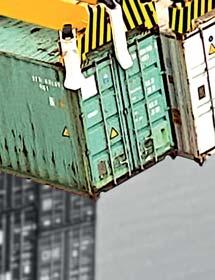
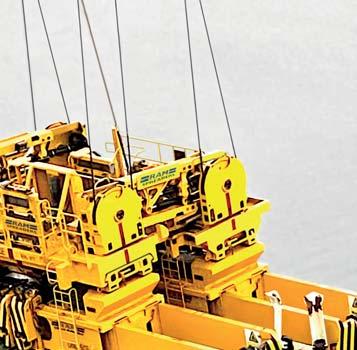
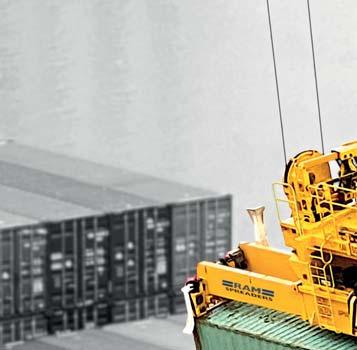
market. “Our spreader easily achieves accurate positioning when telescoping due to increased telescoping and twin separating speed,” Bromma says. Further, the company notes that eliminating spreader hydraulics reduces power consumption by up to 90 per cent. The company states that

TELESCOPIC SPREADERS 40 | JULY/AUGUST 2023For the latest news and analysis go to www.portstrategy.com
when comparing an all-electric STS spreader to its hydraulic alternative, it consumes less energy during its operation. When idling, it consumes almost no energy at all. Bromma has launched more solutions this year, including its Bromma Height Indication System (HIS). Based on ultrasonic sensors, the system measures the distance between the spreader and
8 ELME Spreader: ELME has launched its new generation of spreaders under the umbrella title of ‘Innovation’ – they are aimed at adapting to what the manufacturer calls the ‘harsh’ conditions of container handling. The company’s latest models in this range include the ELME Spreader Model 857 INNOVATION, announced in May this year. This top lift spreader for the handling of laden ISO containers and trailers weighing up to 45 tonnes is designed for use with reach stackers. Two parallel telescopic beams assure maximum overlap. Telescoping is powered by one hydraulic cylinder for each end beam and side-shift is executed by one hydraulic cylinder. Rotation is done by a slewing ring with double transmissions for turning and brakes for holding. ELME also unveiled its 818 INNOVATION model in April this year, which is designed for use under a gantry at the front of a lift truck.
8 RAM Spreaders: RAM Spreaders has seen more tandem headblock systems on its orderbook from existing European customers wishing to expand their container handling operations. It notes that 190 of its single hoist tandem units are either on order or have been delivered. The RAM SingFlex tandem system, with its clever docking station, enables the crane operator to change between spreaders in less than two minutes without manual intervention. RAM says: “Its versatility in adjusting skew, longitudinal offset, and the gap between containers makes it an ideal choice for container terminals wanting to expand without the need to invest in dual hoist cranes.” The growing trend for tandem operations has been driven by the container trade increasingly shifting from 20ft to 40ft containers, which has reduced crane rates in terminals. Tandem systems combat this issue, with RAM noting these operations can reduce vessel stays by up to 40 per cent, with average loading rates of upwards of 150 TEUs
8 Stinis: Stinis has launched a version of its Long Twin spreader for STS cranes and straddle carrier operations, for mobile harbour cranes. The company’s Long Twin Spreader has a telescoping system for adjusting the gap between two 20ft containers. Stinis explains: “The new spreader combines the proven concept of the separating STS Long-Twin with a new centre of gravity adjustment system.” In the new design, the tower slides atop the spreader and in this way compensates for a weight difference of up to 15 tonnes between the two containers. The company
8 VDL Container Systems: Having delivered its first fully electric telescopic spreaders around 15 years ago, VDL Container Systems has boosted the development of its hybrid and electric powered solutions. This includes its Hybrid Piggyback Spreader in Künz cranes. On such a spreader the telescopic movement, twistlocks and flippers are powered electrically and only the piggyback system is powered hydraulically. Pieter Verdonschot, Product Manager, VDL Container Systems, notes: “When in container mode all benefits of an electric spreader are applicable (less energy consumption, noise production, wear and tear and maintenance required).” In total four such spreaders have been supplied to several terminals in Austria and Germany. Elsewhere, the company has developed its Hybrid Flipper to combat the vulnerability of flippers on fully electric
the container, providing real-time signals to the crane operator to decelerate and avoid hard landings on containers.
Recent take-up: Bromma has supplied Long Beach Container Terminal with six units of its all-electric twin lift STS spreaders as the terminal aims to hit its environmental targets.
The company states that: “Gantry mounting is used for lift trucks, dedicated to container handling only.” And that: “Compared to fork mounting, the system increases the residual capacity of the truck and is thus a more economical solution.” Four telescopic hangers connect the spreader to the gantry. Gravity assures the level position of the spreader. The hangers allow the spreader to automatically adapt to containers on trailers or uneven ground. Telescoping is powered by one hydraulic cylinder for each end beam. At the heart of both models is increased structural strength and reduced weight, with an estimated increased life expectancy of 30 per cent related to fatigue resistance and standard load case conditions. For the 857 model, the reduced weight of the spreader makes it possible to increase the lifting capacity in the second and third container row operations.
an hour being achieved by customers. RAM has recently launched its Universal Pipe Handling Spreader. This specialised telescopic spreader can handle up to three pipes between 11.8 to 12.7 metres in length using telescopic beams that latch onto the pipes. The telescopic beams also adjust transversely to accommodate different diameter pipes. All functions of the pipe spreader are done by remote control, with a diagnostic panel on the spreader providing spreader status, fault-finding and troubleshooting information.
Recent take-up: The Port of Massawa in Eritrea, East Africa, has invested in RAM’s twinlift telescopic mobile harbour crane spreaders. RAM says that this is because its MHC spreader can withstand the rigours of a dusty and harsh environment, with ease of maintenance and minimal lubrication required. It uses fewer moving parts than a conventional sliding pyramid system.
adds that the height of the total two-piece system is not more than 100mm higher than a normal twin mobile harbour crane spreader.
Recent take-up: The first unit was delivered to Montecon S.A., in Montevideo in Uruguay in September 2021. It is estimated that the Stinis Long-Twin brings a 10 per cent productivity increase to operations, due to various positive factors including the separating long-twin mechanism and the high torque flippers.
telescopic spreaders. Pieter Verdonschot explains: “To absorb the high impacts flippers have to withstand without using hydraulics has proven to be very difficult.” Therefore, the company launched a Hybrid Flipper, where an electric motor powers a closed loop hydraulic system. The amount of hydraulic oil is similar or less compared to the gearbox oil in a mechanical gearbox, but the torque it can produce and withstand is far more than a mechanical gearbox can withstand. Since the first delivery five years ago, some further improvements have been made to the patented design.
Recent take-up: VDL Container Systems has recently delivered a range of new and replacement spreaders. Its fully electric rotating spreaders have recently been delivered to Chemion Dormagen and Klumpp & Müller in Germany in Künz cranes.
TELESCOPIC SPREADERS For the latest news and analysis go to www.portstrategy.com JULY/AUGUST 2023 | 41



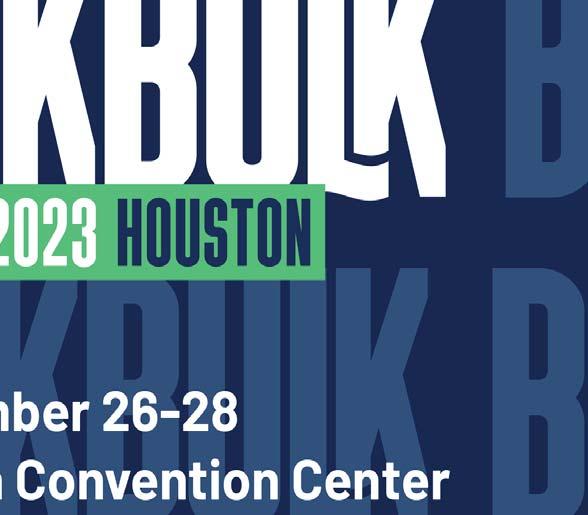
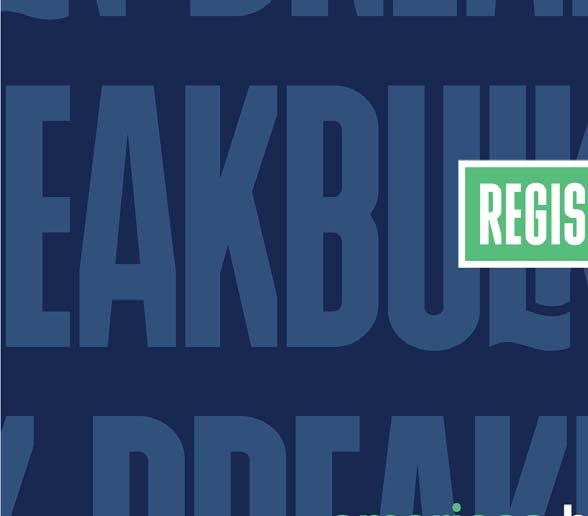
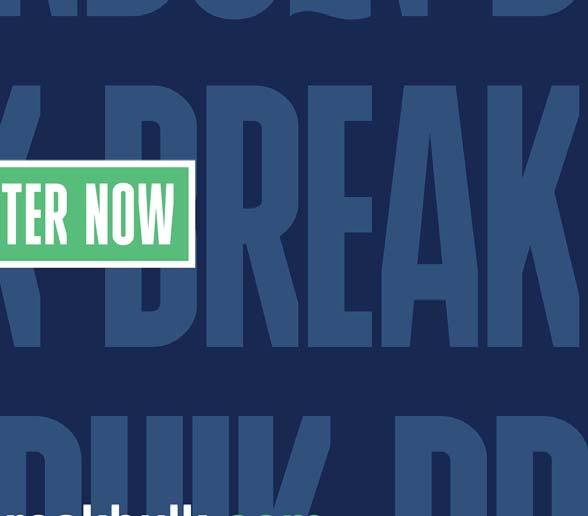

MRS Greifer GmbH


Grabs of MRS Greifer are in use all over the world. They are working reliably and extremely solid. All our grabs will be made customized. Besides the production of rope operated mechanical grabs, motor grabs and hydraulic grabs we supply an excellent after sales service.
Talweg 15-17, Helmstadt-Bargen 74921, Germany
Tel: +49 (0)7263 - 91 29 0
Fax: +49 (0)7263 - 91 29 12 info@mrs-greifer.de www.mrs-greifer.de
Orts GMBH Maschinenfabrik
Over 40 years experience constructing and manufacturing a wide range of grabs, including electro-hydraulic grabs (with the necessary crane equipment) radio controlled diesel hydraulic grabs, 4, 2 and single rope grabs all suitable for bulk cargo.
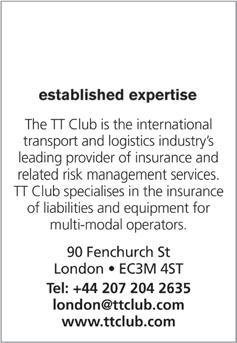
Schwartauer Str. 99
D-23611 Sereetz • Germany
Tel:+49 451 398 850
Fax: +49 451 392 374 soj@orts-gmbh.de www.orts-grabs.de

To advertise in the
Contact Arrate Landera +44 1329 825335 www.portstrategy.com



11
JUNE 2024 Southampton United Kingdom


















Conductix-Wampfler
Künz GmbH
Founded in 1932, Künz is now the market leader in intermodal rail-mounted gantry cranes in Europe and North America, offering innovative and efficient solutions for container handling in intermodal operation and automated stacking cranes for port and railyard operations.

Gerbestr. 15, 6971 Hard, Austria
T: +43 5574 6883 0 sales@kuenz.com www.kuenz.com
SANY Europe GmbH

offers a broad spectrum of high-performance mobile port machines such as Reach Stacker, Empty Container Handler, Heavy Duty Forklift Trucks and Material Handler
Sany Allee 1
Sany Allee 1
D-50181 Bedburg
50181 Bedburg, Germany
Tel: +49 2272 90531 100
Tel: +49 2272 90531 100
Email: info@sanyeurope.com
Email: info@sanyeurope.com
www.sanyeurope.com
www.sanyeurope.com Sany
VISYOy
VISY takes pride in solving operational problems, specialising in gate automation and access control solutions in ports and terminals. Their solutions streamline processes resulting in saving money and increasing productivity.
Visy systems reduce expenses, optimize safety & security, and increase throughput capacity via process automation. Our singleplatform gate operating system and OCR solutions manage all cargo, assets & personnel movements via quay, rail or road to keep operations moving.
To advertise in the Port Strategy Directory
Contact Arrate Landera +44 1329 825335
www.portstrategy.com
The world specialist in Power and Data Transfer Systems, Mobile Electrification, and Crane Electrification Solutions. We Keep Your Vital Business Moving!
Rheinstrasse 27 + 33 Weil am Rhein 79576 Germany
Tel: +49 (0) 7621 662 0
Fax: +49 (0) 7621 662 144 info.de@conductix.com
www.conductix.com

IDENTEC SOLUTIONS is an industry-leading, trusted partner in managing and monitoring reefer containers and optimizing entire terminal operations through solutions like Reefer Runner and Terminal Tracker.

Contact: Stephan Piworus, Global VP Sales Marine & Ports, spiworus@identecsolutions.com; Mobile: +49 151 74122606 www.identecsolutions.com



The world leading manufacturer of Sideloaders, self-loading semi-trailers for versatile & efficient container handling.
www.hammarlift.com
info@hammarlift.com
TVH is a global player in the field of spare parts and accessories for heavy forklifts, reach stackers, container handlers, spreaders and terminal tractors. With over 96,000 references in stock and more than 644,000 known references, TVH offers quality replacement parts for many brands and makes, including the hard-to-find ones.
Tel: +44 2476 585 000 sales.team.uk@tvh.com www.tvh.com

PRODUCTS & SERVICES DIRECTORY 44 | JULY/AUGUST 2023For the latest news and analysis go to www.portstrategy.com
H ANDLING EQUIPMENT I NSURANCE P ORT AUTOMATION S IDELIFTER/SIDELOADER TT Club Directory March 2021 indd 1 01/03/2021 14:40 I
TPORT AUTOMATION
: +358 3 211 0403 Email: sales@visy.fi Web: www visy fi/
Tel
ID indd
25/01/2022
1
11:42
P OWER TRANSMISSION
R EFRIGERATED TRANSPORT S PARE PARTS
G RABS
Port Strategy
Directory
Reefer Monitoring Solutions Visit us at: rte-usa.com New York | Panama For more information visit: seawork.com contact: +44 1329 825335 or email: info@seawork.com 11 13 TO JUNE 2024 Southampton United Kingdom Seawork directory indd 1 25/07/2023 11:27
11 13 TO JUNE 2024 Southampton United Kingdom Seawork directory indd 1 25/07/2023 11:27
For more information visit: seawork.com contact: +44 1329 825335 or email: info@seawork.com
13 TO
For more information visit: seawork.com contact: +44 1329 825335 or email: info@seawork.com Seawork directory indd 1 25/07/2023 11:27
ELME Spreader AB

ELME Spreader, world’s leading independent spreader manufacturer supports companies worldwide with container handling solutions that makes work easier and more profitable. Over 21,000 spreaders have been attached to lift trucks, reach stackers, straddle carriers and cranes.

Stalgatan 6 , PO Box 174
SE 343 22, Almhult, Sweden
Tel: +46 47655800
Fax: +46 476 55899 sales@elme.com www.elme.com
T ERMINAL OPERATIONS SYSTEMS
The Brain of Logistics
With more than 30 years experience in IT Solutions and Business Operation Consultancy DSP offers a large portfolio of professional services and products to support terminal operations processes and system.
DSP Data and System Planning SA
Via Cantonale 38 6928 Manno, Switzerland
Tel: +41 91 230 27 20
Fax: +41 91 230 27 31 info@dspservices.ch www.dspservices.ch

Solvo Europe B.V.
Solvo’s software solutions such as TOS or WMS help container and general cargo terminals take full care of their cargo handling processes and make sure the clients expectations are exceeded.
Prinses Margrietplantsoen 33, 2595AM, The Hague, The Netherlands
Tel: +31 (0) 702-051-709




Email: sales@solvosys.com www.sovosys.com
ERMINAL OPERATIONS SYSTEMS
Tideworks Technology provides comprehensive terminal operating system solutions for marine and intermodal terminal operations worldwide. Tideworks works at every step of terminal operations to maximize productivity and customer service.



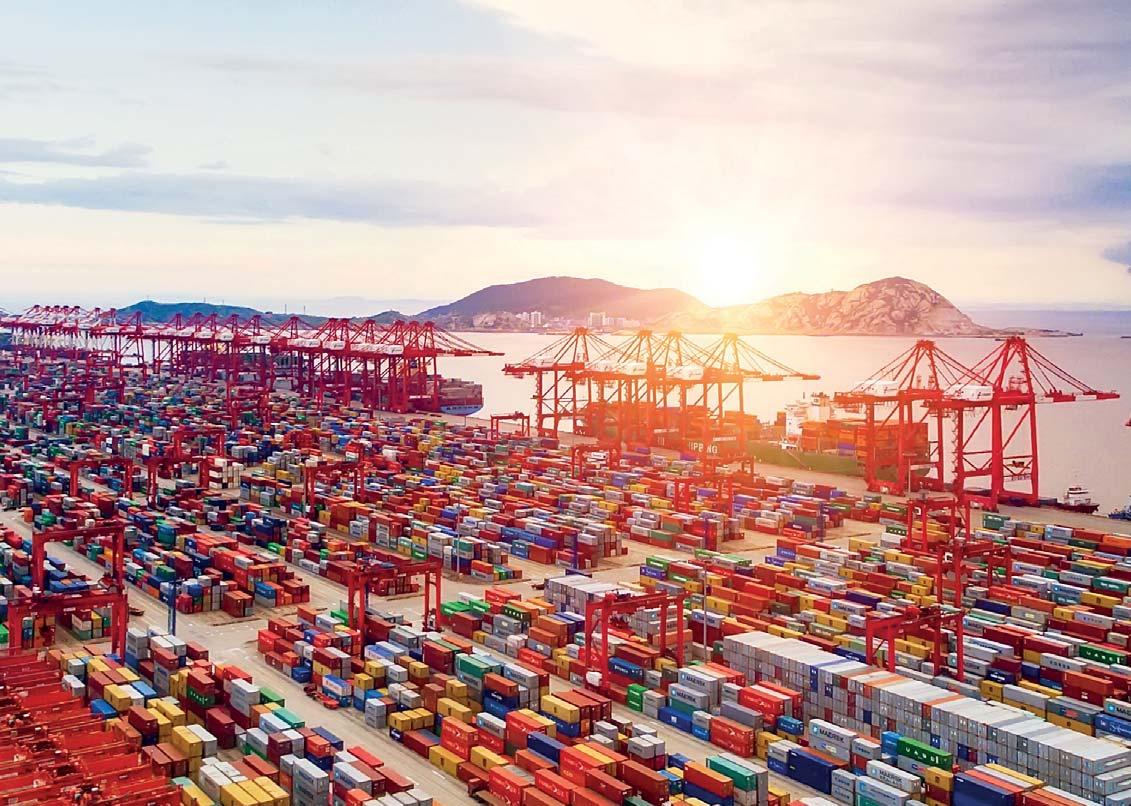

info@tideworks.com +1 206 382 4470 www.tideworks.com
TGI Maritime Software is a Terminal Operating System editor and integrator specialized in the support of Small to Medium Terminals. Its expertise is built on 34 years of experience within the maritime sector. TGI provides comprehensive services to its customers all along their projects. OSCAR TOS and CARROL TOS have already been successfully handled by 40 container and RoRo terminals worldwide.
Tel : +33 (0)3 28 65 81 91 contact@tgims.com www.tgims.com
MAFI Transport-Systeme GmbH

Specialised in the development and production of heavy-duty equipment for transporting containers, semi-trailers, cargo/roll trailers and special container chassis in ports and industry.

Hochhäuser Str 18 97941 Tauberbischofsheim, Germany
Tel: +49 9341 8990 sales@mafi.de www.mafi.de
Brunton Shaw UK is a successful manufacturer of high quality wire ropes for a wide range of applications. The company effectively combines more than 130 years of experience and tradition with an up to the minute range of products, and a customer service package ideal for the modern market place.
Tel: +44 1909 537626
Email: info@brunton-shaw.co.uk
www.brunton-shaw.com
PRODUCTS & SERVICES DIRECTORY
S
T ERMINAL
PREADERS
OPERATIONS SYSTEMS
T
RACTORS
T
w
Visit portstrategy.com Email subscriptions@mercatormedia.com Or Call +44 1329 825335 For multiple users or site access, email corporatesubs@mercatormedia.com port and terminal professionals around the world Informing over To guarantee your magazine SUBSCRIBE NOW needs of our audience. Subscribe today! • Instant access to industry news • Expert opinion • Monthly features • Weekly eNewsletter • 10 editions per year CONTACT DETAILS: DIGITAL: TALKING THE SAME LANGUAGE ACCESS ALL CONTENT! ANNUAL SUBSCRIPTIONS AVAILABLE FROM £228 PS Subs Had HP (2023) indd indd 1 01/06/2023 08:14 For more information visit: seawork.com contact: +44 1329 825335 or email: info@seawork.com 11 13 TO JUNE 2024 Southampton United Kingdom Seawork directory indd 1 25/07/2023 11:27
IRE ROPES
POSTSCRIPT
CHINA REVS UP AUTO ACTIVITIES
There might be some areas of Chinese activity that are seen as slipping but in the arena of automobile production and transport by sea the country is growing in strength. Electric vehicles are at the forefront of this new market penetration.
The AlixPartners 2023 Global Automotive Outlook report highlights Chinese car manufacturers as now leading the world in export volume, “as the traditional western car industry is running out of time to defend its historic market share.” The specialised consultancy underlines that: “In the first quarter of 2023, China replaced Japan as the world leader in automotive exports” and labelled it, “an astonishing advancement from sixth place as recently as 2019.”
In particular, China is seen to be very competitive in European markets with electric vehicle sales.
Adding perspective to this, Andrew Bergbaum, Partner & Managing Director in the AlixPartners Automotive practice, said at the time of the release of the report:
“China can now really be regarded as an automotive superpower. UK and European OEMs, on the other hand, are increasingly taking on the role of defenders of market share in their traditional, and shrinking, home markets. At the same time, having enjoyed some pricing power, they are now coming under pressure with tightening margins in the face of a low growth global market and increasing competition. For the UK, the proposed accelerated transition away from pure combustion engines by 2030 is going to position lower-cost Chinese imported BEVs as attractive investment alternatives.”
Another measure of China’s advance, AlixPartners notes, is that in the Chinese domestic market in 2023, for the first time in decades, Chinese brands will surpass foreign products (51 per cent), and they are predicted to account for a market share of 65 per cent by 2030.
Vehicle sales in Europe over the long term are forecast to run at around 15 per cent below pre-Covid levels and in the UK at around 10 per cent below.
In terms of the switch from combustion to battery
power, AlixPartners makes the interesting observation that: “It is becoming increasingly apparent that combustion engines and electric vehicles will exist in parallel for longer than originally expected. The lengthening ICE lifetime is helped by the fact that the drawn-out decline in the cost of batteries will significantly dampen the pace of the transition to electric mobility in the medium term. This ‘twin-tracking,’ the consultancy suggests, “prevents the establishment of rapid economies of scale and in turn further increases the acute financial pressure on the industry.” Rising costs, including raw material costs, are identified as likely to be of ongoing concern.
CAR CARRIER BOOM
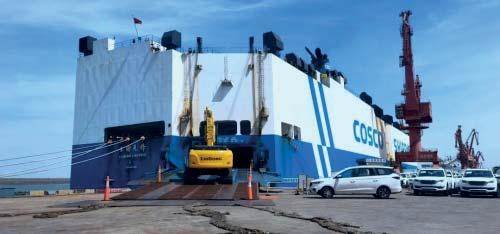
Prompted to a significant extent by China’s electric vehicle exports, structural changes are also afoot in the car carrier sector. Ton-miles are increasing significantly, rates are strong and as of the end of the first quarter of 2023 the car carrier order book, according to Gersemi Asset Management (GAM), accounted for a volume equivalent to 25 per cent of the fleet on the water. Further, GAM’s view is that freight rates will not cool this year with just 12 vehicle carriers scheduled for delivery in 2023 and three vessels expected to be scrapped.
This looks set to change from 2024 onwards, however, with 46 new vessels scheduled for delivery in 2024 and 52 in 2025, a big uplift. These figures could prove to be even higher with much of the demand for new vessels coming directly from Chinese automotive manufacturers who are busy ordering their own vessels and have options for additional units. Additionally, the sector has seen container liner operators crowd in – Cosco, CMA CGM and HMM have all recently ordered or chartered specialist vehicle carrying ships. The seeds of change appear well and truly planted in the sector overall.
8 The order book for car carriers is swelling with Chinese auto manufacturers growing direct involvement and container liner operators attracted by healthy rates
‘‘
The seeds of change are manifest in the automotive sector – electric vehicle sales have catapulted China into the number one slot for export sales and it is equally busy growing its presence in specialist car carrier operations
46 | JULY/AUGUST 2023 For the latest news and analysis go to www.portstrategy.com
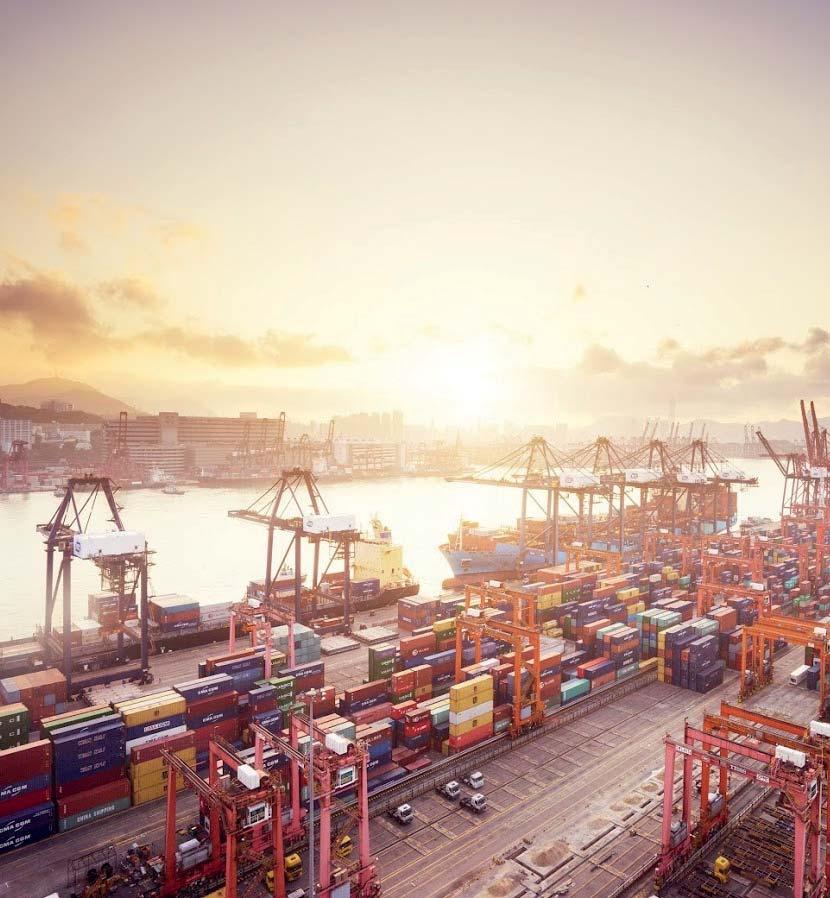
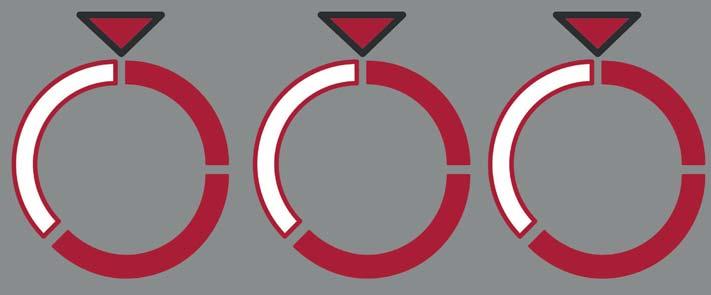
Arrate Landera, Brand Manager t: (+44) 1329 825 335 e: sales@portstrategy.com www.portstrategy.com Contact us today PORTSTRATEGY INSIGHT FOR PORT EXECUTIVES MAGAZINE RECIPIENTS DECISION MAKERS PAGEVIEWS PER MONTH 17,80072%36,240 Reach industry professionals with Port Strategy Promote your business to the right audience in the right place at the right time. Engage with our international audience of decision makers and buyers. The Port opportunities for campaign delivery. We provide bespoke marketing packages Port Strategy’s valued content is dedicated to the international ports and terminals business and is delivered through multiple channels.





















44TH 23 TO NOV 3 21 Hamburg Germany Propulsion stream | Alternative fuels stream | Technical visit Meet and network with 200 CEOs and technical directors from ship owning, operating and management policy makers, shipbuilding, fuel, equipment and technology suppliers. Visit: motorship.com/PFFBOOK Contact: +44 1329 825335 Email: conferences@propulsionconference.com #MotorshipPFF Keynote panel topic: The cost of decarbonisation & who is going to pay? Topics to discuss with the keynote panel will include carbon levy funding, funding for investment, national incentives, funding for new technology & hypothecation. Programme out now - Book now and save 20%
challenges for new technology LNG beyond transition Carbon capture Advances in lubrication
shipping’s emissions-cutting ambitions Gain insight from industry experts on: MOTORSHIP MARINE TECHNOLOGY THE Media partner: Media supporters:
Learn from C-suite keynote panel Safety
Powering
MODERATOR
Lars Robert Pedersen, Deputy Secretary General, BIMCO
Ricardo Batista, European Commission
Simon Bennett, Deputy Secretary General, International Chamber of Shipping
Martin Kröger, CEO, German Shipowners’ Association (VDR)
Wolfram Guntermann, Director Regulatory Lloyd AG
Supported by: Sponsored by:
Markus Münz, Managing Director, VDMA Large Engines

























































































































































































































